Methods and compositions for DNA profiling
Stephens , et al. Sept
U.S. patent number 10,422,002 [Application Number 14/622,632] was granted by the patent office on 2019-09-24 for methods and compositions for dna profiling. This patent grant is currently assigned to ILLUMINA, INC.. The grantee listed for this patent is Illumina, Inc.. Invention is credited to Sasan Amini, Carey Davis, Yonmee Han, Cydne Holt, Anne Jager, Min-Jui Richard Shen, David Silva, Frank J. Steemers, Kathryn M. Stephens, Paulina Walichiewicz.



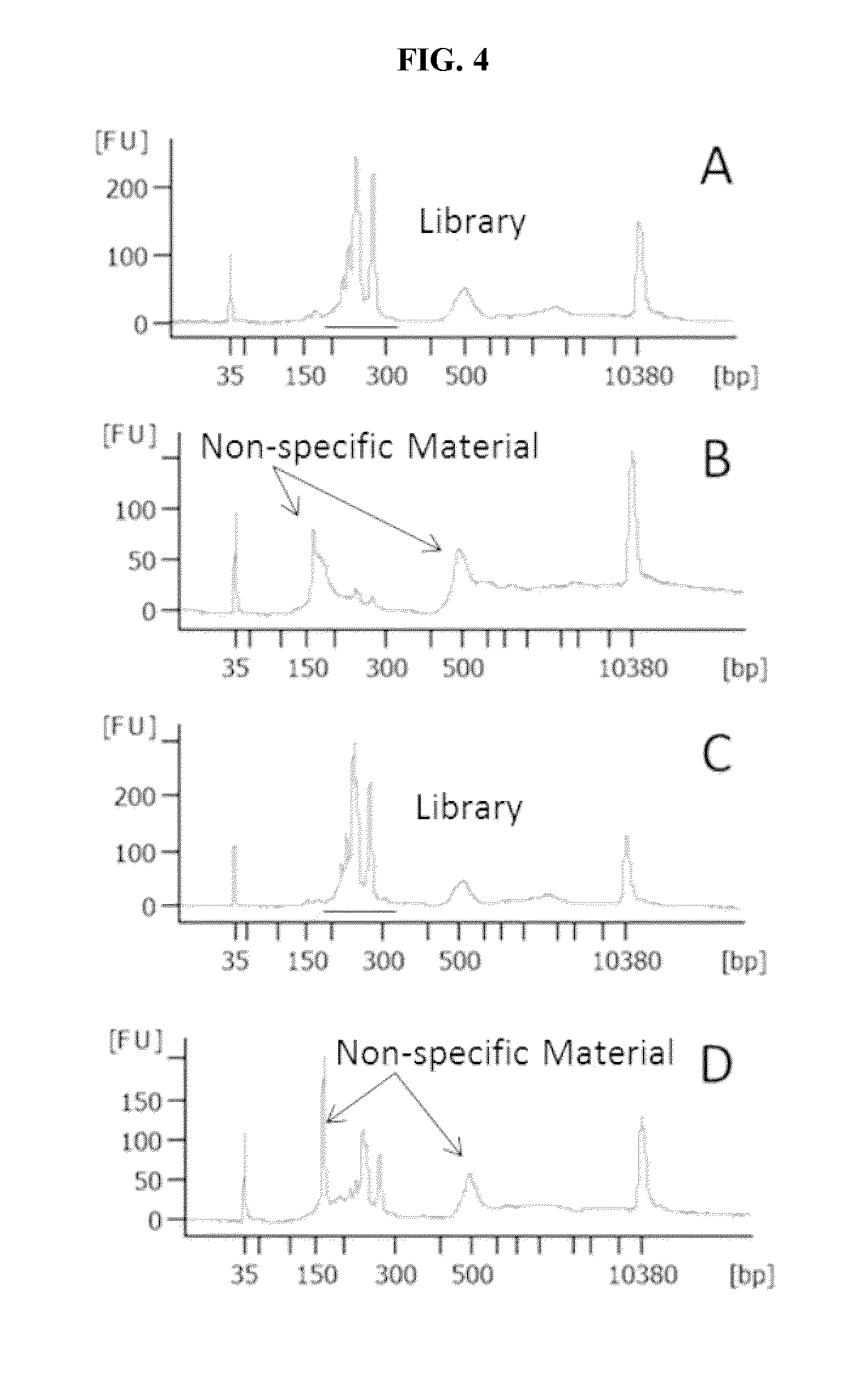
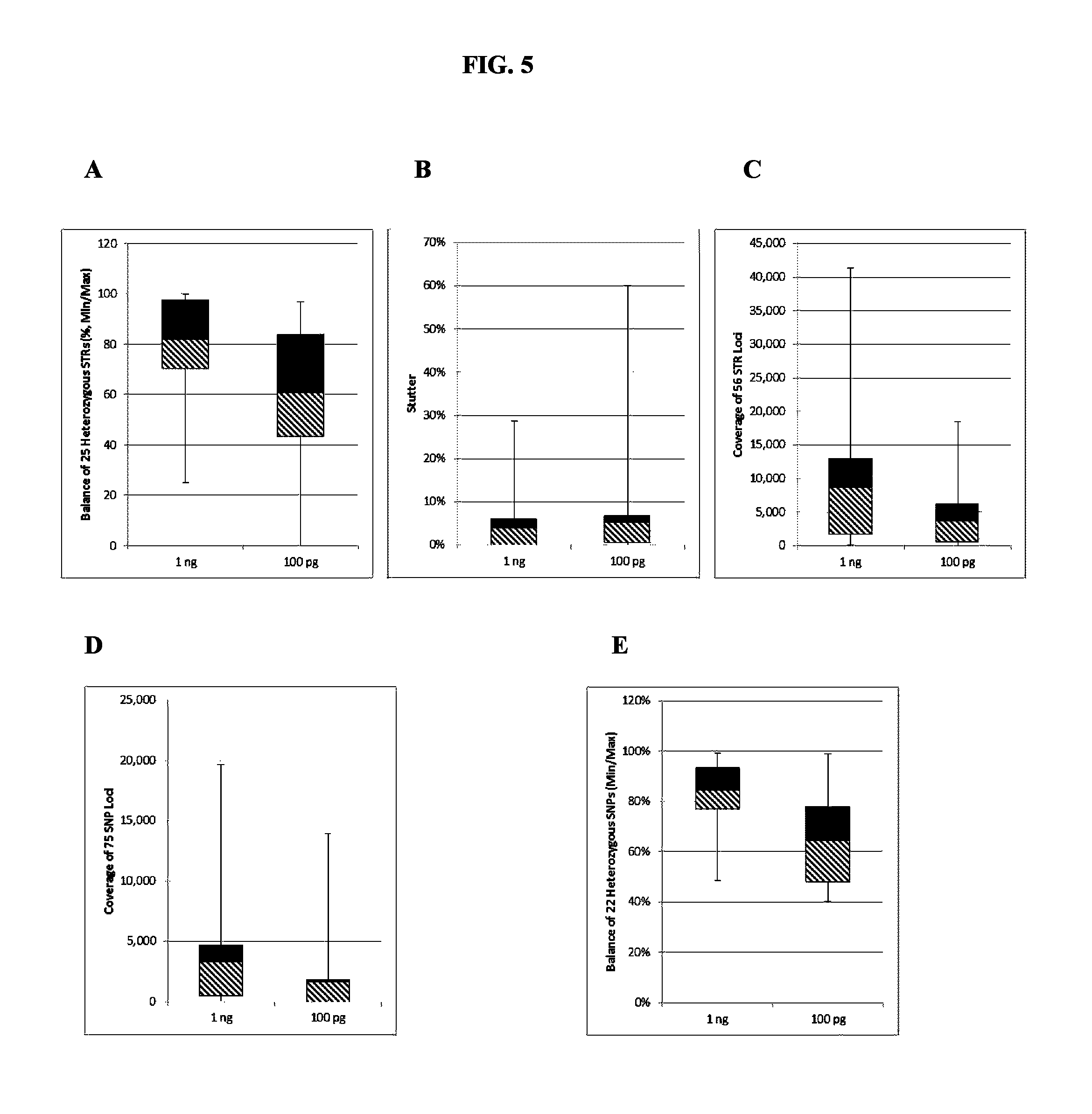
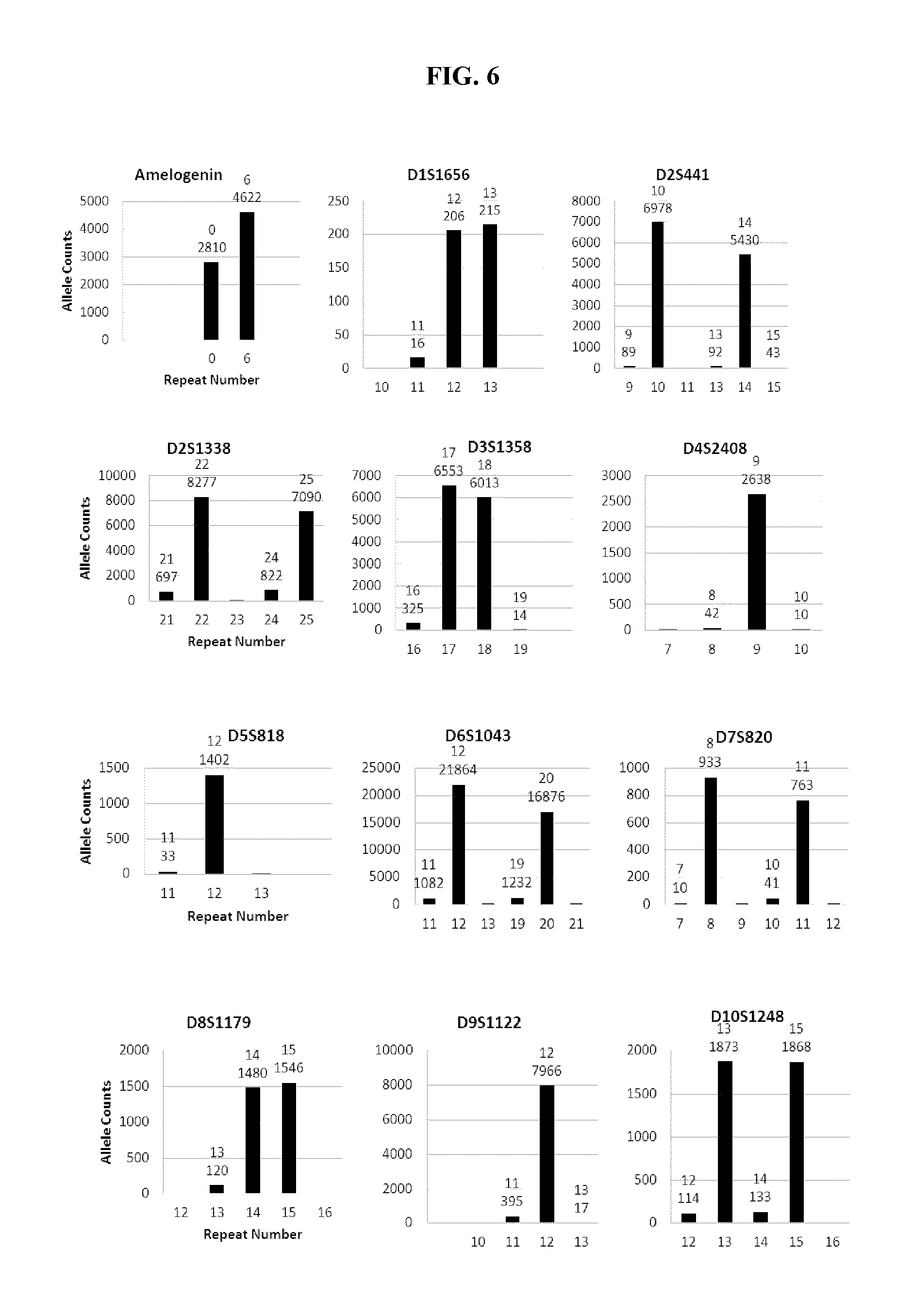
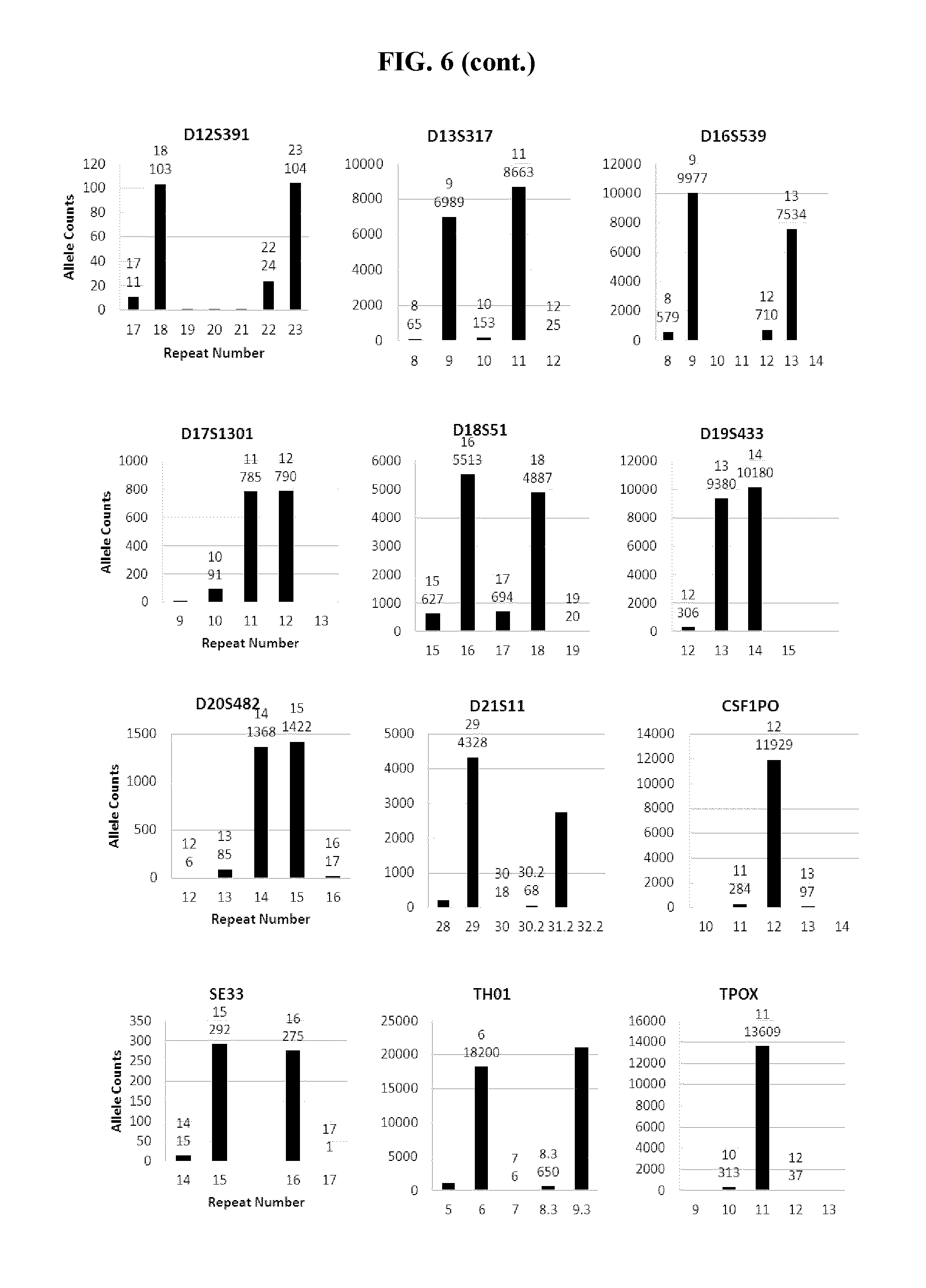
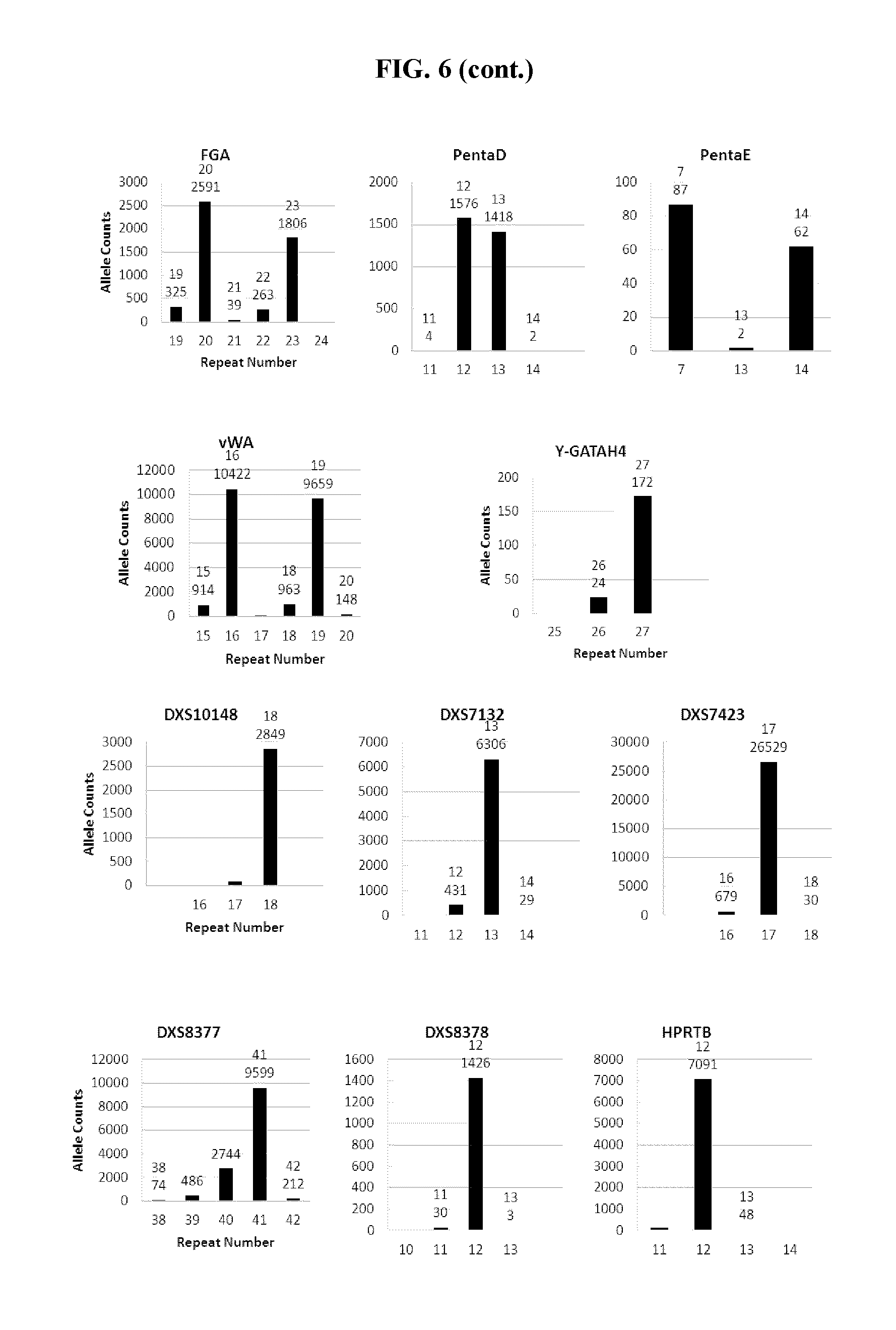

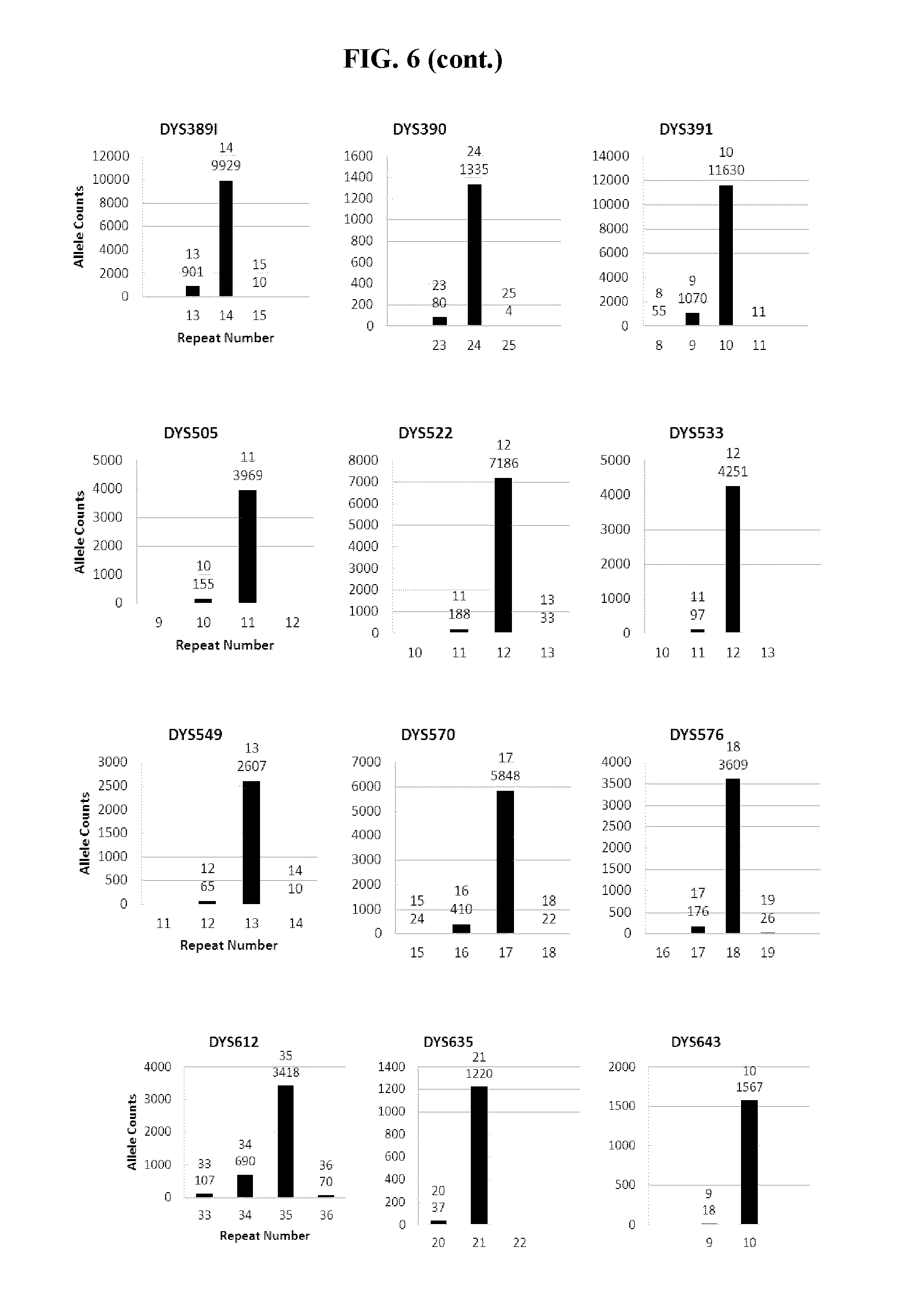
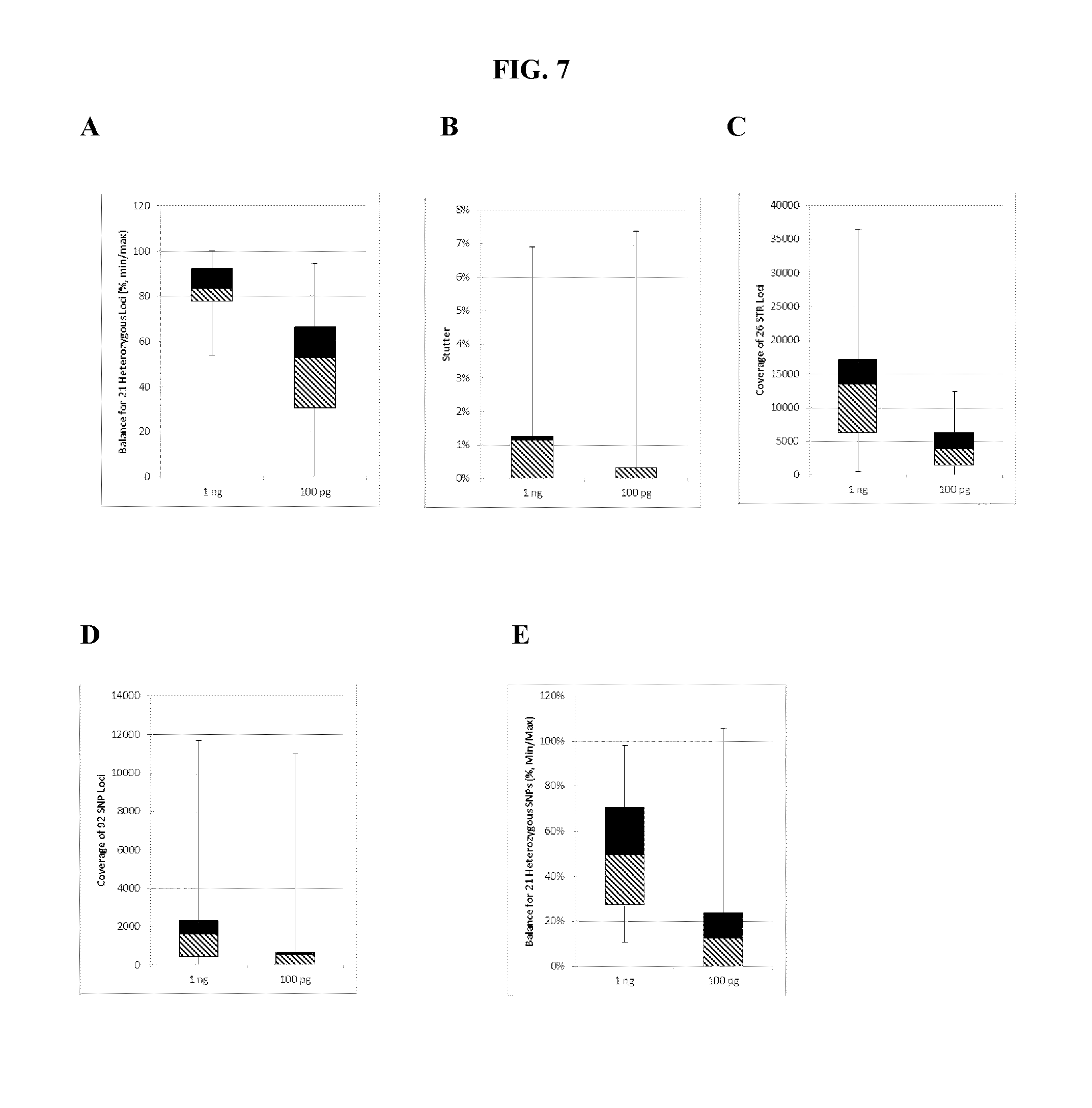
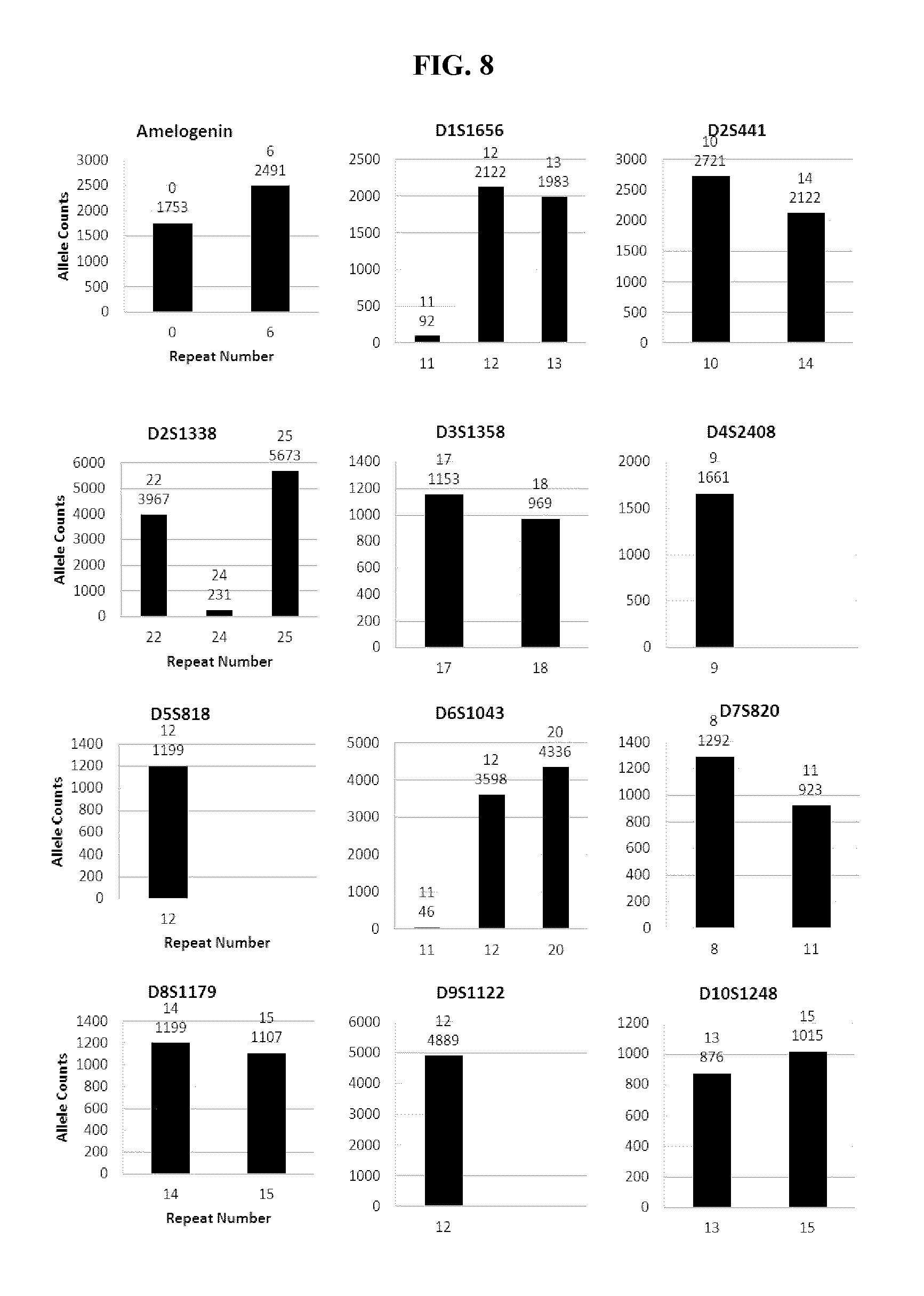
View All Diagrams
| United States Patent | 10,422,002 |
| Stephens , et al. | September 24, 2019 |
Methods and compositions for DNA profiling
Abstract
Embodiments disclosed herein provide methods for constructing a DNA profile comprising: providing a nucleic acid sample, amplifying the nucleic acid sample with a plurality of primers that specifically hybridize to at least one target sequence comprising a SNP and at least one target sequence comprising a tandem repeat, and determining the genotypes of the at least one SNP and at least one tandem repeat in the amplification products, thereby constructing the DNA profile of the nucleic acid sample. Embodiments disclosed herein further provide a plurality of primers that specifically hybridize to at least one short target sequence and at least one long target sequence in a nucleic acid sample, wherein amplifying the nucleic acid sample using the plurality of primers in a single reaction results in a short amplification product and a long amplification product, wherein each of the plurality of primers comprises one or more tag sequences.
| Inventors: | Stephens; Kathryn M. (Poway, CA), Holt; Cydne (Encinitas, CA), Davis; Carey (San Diego, CA), Jager; Anne (San Diego, CA), Walichiewicz; Paulina (San Diego, CA), Han; Yonmee (San Diego, CA), Silva; David (San Diego, CA), Shen; Min-Jui Richard (Poway, CA), Amini; Sasan (San Diego, CA), Steemers; Frank J. (Encinitas, CA) | ||||||||||
|---|---|---|---|---|---|---|---|---|---|---|---|
| Applicant: |
|
||||||||||
| Assignee: | ILLUMINA, INC. (San Diego,
CA) |
||||||||||
| Family ID: | 52629678 | ||||||||||
| Appl. No.: | 14/622,632 | ||||||||||
| Filed: | February 13, 2015 |
Prior Publication Data
| Document Identifier | Publication Date | |
|---|---|---|
| US 20150232929 A1 | Aug 20, 2015 | |
Related U.S. Patent Documents
| Application Number | Filing Date | Patent Number | Issue Date | ||
|---|---|---|---|---|---|
| 61940942 | Feb 18, 2014 | ||||
| 62043060 | Aug 28, 2014 | ||||
| 62103524 | Jan 14, 2015 | ||||
| Current U.S. Class: | 1/1 |
| Current CPC Class: | C12Q 1/6876 (20130101); C12Q 1/6858 (20130101); C12Q 1/6827 (20130101); C12Q 1/6853 (20130101); C12Q 1/6869 (20130101); C12Q 1/6827 (20130101); C12Q 2531/113 (20130101); C12Q 2535/122 (20130101); C12Q 2537/143 (20130101); C12Q 1/6858 (20130101); C12Q 2531/113 (20130101); C12Q 2535/122 (20130101); C12Q 2537/143 (20130101); C12Q 2600/16 (20130101); C12Q 2600/156 (20130101) |
| Current International Class: | C12Q 1/6858 (20180101); C12Q 1/6876 (20180101); C12Q 1/6827 (20180101); C12Q 1/6869 (20180101); C12Q 1/6853 (20180101) |
References Cited [Referenced By]
U.S. Patent Documents
| 2003/0082566 | May 2003 | Sylvan |
| 2003/0157499 | August 2003 | Lundeberg |
| 2006/0014190 | January 2006 | Hennessy |
| 2006/0057595 | March 2006 | Lao |
| 2008/0090239 | April 2008 | Shoemaker |
| 2009/0081675 | March 2009 | Colston, Jr. |
| 2009/0163366 | June 2009 | Nickerson |
| 2009/0317817 | December 2009 | Oeth |
| WO 2006/004659 | Jan 2006 | WO | |||
| 2011091046 | Jul 2011 | WO | |||
| WO 2012/155084 | Nov 2012 | WO | |||
Other References
|
Dieffenbach et al. Genome Research 1993; 3: S30-S37. cited by examiner . Kinde et al. Proceedings of the National Academy of Sciences, USA 2011; 108: 9530-9535. (Year: 2011). cited by examiner . Kube et al. Genes and Immunity 2003; 4: 459-468. (Year: 2003). cited by examiner . Rook MS et al., Whole genome amplification of DNA from laser capture-microdissected tissue for high-throughput single nucleotide polymorphism and short tandem repeat genotyping, American Journal of Pathology 164:23-33 (2004). cited by applicant . Fraige Karina et al., Analysis of Seven STR Human Loci for Paternity Testing by Microchip Electrophoresis, Brazilian Archives of Biology and Technology 56:213-221 (2013). cited by applicant . Teemu Kivioja et al., Counting absolute numbers of molecules using unique molecular identifiers, Nature Methods, Nature Publishing Group, GB 9:72-74 (2012). cited by applicant . Liu Jing et al., An Improved allele-specific PCR primer design method for SNP marker analysis and its application, Plant Methods, Biomed Central, London, GB, 8:1-8 (2012). cited by applicant . Phillips Chris et al., Development of a novel forensic STR multiplex for ancestry analysis and extended identity testing, Electrophoresis, 34:1151-1162 (2013). cited by applicant . Bornman Daniel et al., Short-read, high-throughput sequencing technology for STR genotyping, Biotech Rapid Dispatches 2012:1-6 (2012). cited by applicant . Bender K et al., A multiplex SNP typing approach for the DNA pyrosequencing technology, International Congress Series 1288:73-75 (2006). cited by applicant . International Search Report and Written Opinion dated May 13, 2015 for PCT Application No. PCT/US2015/015939, filed Feb. 13, 2015. cited by applicant . "Office Action", Office Action, Columbian Patent Application No. NC2016/0001634, dated Feb. 9, 2018, 10 pages. cited by applicant. |
Primary Examiner: Bertagna; Angela M.
Attorney, Agent or Firm: Illumina, Inc.
Parent Case Text
RELATED APPLICATIONS
This application claims priority to U.S. Provisional Application No. 62/103,524 filed Jan. 14, 2015, U.S. Provisional Application No. 62/043,060 filed Aug. 28, 2014, and U.S. Provisional Application No. 61/940,942 filed Feb. 18, 2014, the contents of which are incorporated herein by reference in their entireties.
Claims
What is claimed is:
1. A composition of primers, comprising: a first primer set comprising primers that specifically hybridize to a first target sequence and amplify a first fragment having a first fragment length, wherein the first target sequence comprises a single nucleotide polymorphism (SNP), and wherein the primers that specifically hybridize to the first target sequence hybridize to a portion of the first target sequence that flanks the SNP and do not hybridize to the SNP; and a second primer set comprising primers that specifically hybridize to a second target sequence and amplify a second fragment having a second fragment length, wherein the first fragment length is shorter than the second fragment length, and wherein the second target sequence comprises a tandem repeat; and wherein at least one of the primers in the composition comprising the first and second primer sets comprises one or more tag sequences, and wherein at least one of the primers in the composition has a low melting temperature, has a length of at least 24 nucleotides, comprises a homopolymer nucleotide sequence, or a combination thereof, and wherein at least one of the primers in the composition has a low melting temperature and has a length of at least 24 nucleotides.
2. The composition of claim 1, wherein the one or more tag sequences further comprise a primer tag, a capture tag, a sequencing tag, a unique molecular identifier tag, or a combination thereof.
3. The composition of claim 1, wherein at least one of the primers in the first primer set has a length of at least 24 nucleotides.
4. The composition of claim 1, wherein the low melting temperature is a temperature that is less than 60 degrees C.
5. The composition of claim 1, wherein the first primer set further comprises additional primers that specifically hybridize to one or more additional target sequences collectively comprising at least 29 SNPs.
6. The composition of claim 1, wherein the tandem repeat is a short tandem repeat (STR), an intermediate tandem repeat (ITR), or a variant thereof.
7. The composition of claim 1, wherein the second primer set further comprises additional primers that specifically hybridize to one or more additional target sequences collectively comprising at least 23 tandem repeat sequences.
8. The composition of claim 1, wherein at least one of the primers in the composition of primers has a length of between 24 and 38 nucleotides.
9. The composition of claim 1, wherein at least one of the primers in the composition of primers has a melting temperature that is less than 58 degrees C.
10. The composition of claim 1, wherein at least one of the primers in the composition of primers has a melting temperature of about 54 degrees C.
Description
REFERENCE TO SEQUENCE LISTING, TABLE, OR COMPUTER PROGRAM LISTING
The present application is being filed along with a Sequence Listing in electronic format. The Sequence Listing is provided as a file entitled IP-1192-US_SL.txt, created Mar. 7, 2018, which is 59,789 bytes in size. The information in the electronic format of the Sequence Listing is incorporated herein by reference in its entirety.
FIELD OF THE DISCLOSURE
Embodiments provided herein relate to methods and compositions for DNA profiling. Some embodiments relate to methods of amplification of target sequences of variant sizes in a single reaction, followed by subsequent sequencing of the library.
BACKGROUND OF THE DISCLOSURE
Historically, the use of a subset of markers in a human genome has been utilized to determine an individual's personal identity, or DNA fingerprint or profile. These markers include locations or loci of short tandem repeated sequences (STRs) and intermediate tandem repeated sequences (ITRs) which in combination are useful in identifying one individual from another on a genetic level. The analysis of these markers has become standardized in the analysis of DNA found at crime scenes. For example, in the United States a number of these repeated sequences have been combined to create a Combined DNA Index System (CODIS), which serve as the laboratory standard for DNA profiling in criminal cases. Other countries similarly have adopted a standard system for DNA profiling. These systems have also been utilized to determine paternity and familial relationships. However, the current systems are all based on size separation of these repeated loci on an electrophoretic system and are thus limited to the number of loci that can be differentiated in such a system. For example, some of the current commercial systems for DNA profiling for forensics purposes differentiate only 16 markers due to the limitations of the electrophoretic detection methods.
SUMMARY OF THE DISCLOSURE
Embodiments relate to systems and methods that are not content limited and that bring different pieces of genetic information about an individual together to provide a comprehensive, more complete DNA profile of an individual. The present disclosure describes methods and compositions that enable this profile of an individual, thereby advancing the fields of personal and forensic genomics.
DNA profiling currently uses selected biological markers for determining the identity of a DNA sample. For example, the most common analysis for determining a DNA profile is to determine the profile for a number of short tandem repeated (STRs) sequences found in an organism's genome. The analysis consists of amplifying defined STR sequences that can be up to 400 bp long that can be differentiated by size on an electrophoretic gel or by using capillary electrophoresis (CE). Electrophoresis is used to detect size changes due to differences in the number of repeated STRs at a given locus and as such the length of the PCR amplicons, which for the CE system is between 50-500 bp. To help overcome the limits imposed by size differentiation methodologies (i.e., STRs of overlapping amplicon size cannot be differentiated), current methods of DNA profiling utilize different sets of labelled primers such that amplicons that overlap in size can be labelled with different fluorescent dyes whereon, upon excitation, the emission spectra differ thereby allowing for overlapping amplicons to be differentiated using differences in the dye excitation and emission spectra. Using differentiated labeling, current methods allow for the multiplexing of 24 different STR loci using 6 differently detectable dyes in one DNA profiling run.
There are many limitations to the current DNA profiling methodologies. As previously mentioned, size differentiated systems limit the number of loci that can be discretely determined at a given time. Another limitation of the established methods for DNA profiling is that the DNA to be analyzed oftentimes is degraded and the size range of some of the markers does not accommodate degraded DNA, for example the amplicons can be larger than the size of the fragments of the degraded DNA. For degraded DNA, amplicons of 400 bp are considered very long and can result in loss of amplification of those longer loci. When DNA analysts amplify degraded DNA samples to identify their STR profile, for example a sample found at a crime scene, oftentimes they are unable to detect all the loci resulting in a partial profile which can make matching a suspect in a crime scene to a crime sample difficult or impossible. As a default with such samples, a DNA analyst has little choice and if any sample is left over, additional assays need to be performed to identify other markers which might give a clue as to the identity of the individual, such as single nucleotide polymorphisms (SNPs), mini-STRs, or mitochondrial DNA (mtDNA) analysis. However, precious sample must be expended on each assay with no certainty of success in finally identifying an individual. FIG. 1A demonstrates the potential different paths to DNA identification, all of which are separate workflows and require aliquots of precious samples. When one or more simple workflows need to be combined and potentially repeated multiple times then the resulting process is no longer simple or an effective use of a precious sample.
Embodiments described in the present application provide methods, compositions and systems for determining the DNA profile of an individual or organism by next generation sequencing (NGS) thereby providing a solution to the problems and limitations of current methodologies for DNA profiling. FIG. 1B shows an exemplary workflow of the disclosed methods in one embodiment. Disclosed herein are methods and compositions for combining a multitude of forensically relevant markers into one assay including, but not limited to, short tandem repeats (STRs), intermediate tandem repeats (ITRs), identity informative single nucleotide polymorphisms (iSNPs), ancestry informative single nucleotide polymorphisms (aSNPs) and phenotypic informative single nucleotide polymorphisms (pSNPs).
The present disclosure describes assays that overcome the limitations of current methodologies for DNA profiling. Disclosed embodiments provide methods and compositions for multiplex amplification, library preparation and sequencing of combined STRs, ITRs, iSNPs, aSNPs, and pSNPs from one nucleic acid sample in a single multiplex reaction. Disclosed methods analyze a plurality of markers in one experimental assay with minimal sample handling, using low amounts of sample DNA including degraded DNA. Some embodiments described can be utilized for databanking DNA profiles and/or DNA profiles that can be used for criminal casework. Some embodiments provide PCR methods and compositions developed to be sensitive enough to detect sub-nanogram amounts of DNA. Further, the unconventional primer design parameters allow for highly multiplexed PCR for the identification of STRs, ITRs and SNPs in one multiplex reaction. For criminal casework, the present methods and compositions incorporate unique molecule identifiers (UMIs) which aide in removal of, for example, PCR and sequencing errors, stutter and the like from sequencing results. See Kivioja et al., Nat. Meth. 9, 72-74 (2012). As well, the results from the methods and compositions disclosed herein are compatible with existing databases.
Therefore, embodiments disclosed herein provide methods for constructing a DNA profile comprising: providing a nucleic acid sample, amplifying the nucleic acid sample with a plurality of primers that specifically hybridize to at least one target sequence comprising a single nucleotide polymorphism (SNP) and at least one target sequence comprising a tandem repeat in a multiplex reaction to generate amplification products, and determining the genotypes of the at least one SNP and the at least one tandem repeat in the amplification products, thereby constructing the DNA profile of the nucleic acid sample.
In some embodiments, the methods comprise generating a nucleic acid library from the amplification products. In some embodiments, the methods comprise determining the sequences of the nucleic acid library. In some embodiments, the nucleic acid sample is from a human. In some embodiments, the nucleic acid sample is from an environmental sample, a plant, a non-human animal, a bacterium, archaea, a fungus, or a virus. In some embodiments, the DNA profile is used for one or more of disease diagnostics or prognosis, cancer biomarker identification, genetic anomaly identification or genetic diversity analysis. In some embodiments, the DNA profile is used for one or more of databanking, forensics, criminal case work, paternity or personal identification. In some embodiments, the at least one SNP indicates the ancestry or a phenotypic characteristic of the source of the nucleic acid sample. In some embodiments, each of the plurality of primers has a low melting temperature and/or has a length of at least 24 nucleotides. In some embodiments, each of the plurality of primers has a melting temperature that is less than 60 degrees C. In some embodiments, each of the plurality of primers has a melting temperature that is about 50 degrees C. to about 60 degrees C. In some embodiments, each of the plurality of primers has a length of at least 24 nucleotides. In some embodiments, each of the plurality of primers has a length of about 24 nucleotides to about 38 nucleotides. In some embodiments, each of the plurality of primers comprises a homopolymer nucleotide sequence. In some embodiments, the nucleic acid sample is amplified by polymerase chain reaction (PCR). In some embodiments, the nucleic acid sample is amplified in an amplification buffer having a salt concentration that is increased compared to the salt concentration of an amplification buffer used in conjunction with conventionally designed primers. In some embodiments, the salt comprises KCl, LiCl, NaCl, or a combination thereof. In some embodiments, the salt comprises KCl. In some embodiments, the concentration of KCl in the amplification buffer is about 100 mM to about 200 mM. In some embodiments, the concentration of KCl in the amplification buffer is less than about 150 mM. In some embodiments, the concentration of KCl in the amplification buffer is about 145 mM. In some embodiments, the SNP is an ancestry SNP, a phenotypic SNP, an identity SNP, or a combination thereof. In some embodiments, the plurality of primers specifically hybridize to at least 30 SNPs. In some embodiments, the plurality of primers specifically hybridize to at least 50 SNPs. In some embodiments, the tandem repeat is a short tandem repeats (STR), an intermediate tandem repeat (ITR), or a variant thereof. In some embodiments, the plurality of primers specifically hybridize to at least 24 tandem repeat sequences. In some embodiments, the plurality of primers specifically hybridize to at least 60 tandem repeat sequences. In some embodiments, the nucleic acid sample comprises about 100 pg to about 100 ng DNA. In some embodiments, the nucleic acid sample comprises about 10 pg to about 100 pg DNA. In some embodiments, the nucleic acid sample comprises about 5 pg to about 10 pg DNA. In some embodiments, the nucleic acid sample comprises genomic DNA. In some embodiments, the genomic DNA is from a forensic sample. In some embodiments, the genomic DNA comprises degraded DNA. In some embodiments, at least 50% of the genotypes of the at least one SNP and at least one tandem repeat are determined. In some embodiments, at least 80% of the genotypes of the at least one SNP and at least one tandem repeat are determined. In some embodiments, at least 90% of the genotypes of the at least one SNP and at least one tandem repeat are determined. In some embodiments, at least 95% of the genotypes of the at least one SNP and at least one tandem repeat are determined. In some embodiments, each of the plurality of primers comprises one or more tag sequences. In some embodiments, the one or more tag sequences comprise a primer tag, a capture tag, a sequencing tag, a unique molecular identifier tag, or a combination thereof. In some embodiments, the one or more tag sequences comprise a primer tag. In some embodiments, the one or more tag sequences comprise a unique molecular identifier tag.
Embodiments disclosed herein provide methods of constructing a nucleic acid library comprising: providing a nucleic acid sample, and amplifying the nucleic acid sample with a plurality of primers that specifically hybridize to at least one target sequence comprising a single nucleotide polymorphism (SNP) and at least one target sequence comprising a tandem repeat sequence in a multiplex reaction to generate amplification products.
In some embodiments, the nucleic acid sample is not fragmented prior to the amplification. In some embodiments, the target sequences are not enriched prior to the amplification. In some embodiments, the at least one SNP indicates the ancestry or a phenotypic characteristic of the source of the nucleic acid sample. In some embodiments, each of the plurality of primers comprises one or more tag sequences. In some embodiments, the one or more tag sequences comprise a primer tag, a capture tag, a sequencing tag, or a unique molecular identifier tag, or a combination thereof. In some embodiments, the methods include amplifying the amplification products with a second plurality of primers. In some embodiments, each of the second plurality of primers comprises a portion corresponding to the primer tag of the plurality of primers and one or more tag sequences. In some embodiments, the one or more tag sequences of the second plurality of primers comprise a capture tag, or a sequencing tag, or a combination thereof. In some embodiments, the methods include adding single stranded-binding protein (SSB) to the amplification products. In some embodiments, the nucleic acid sample and/or the amplification products are amplified by polymerase chain reaction (PCR). In some embodiments, the nucleic acid sample and/or the amplification products are amplified in an amplification buffer having a salt concentration that is increased compared to the salt concentration of an amplification buffer used in conjunction with conventionally designed primers. In some embodiments, the salt comprises KCl, LiCl, NaCl, or a combination thereof. In some embodiments, the salt comprises KCl. In some embodiments, the concentration of KCl in the amplification buffer is about 100 mM to about 200 mM. In some embodiments, the concentration of KCl in the amplification buffer is less than about 150 mM. In some embodiments, the concentration of KCl in the amplification buffer is about 145 mM.
Embodiments disclosed herein provide a nucleic acid library comprising a plurality of nucleic acid molecules, wherein the plurality of nucleic acid molecules comprise at least one tandem repeat sequence flanked by a first pair of tag sequences and at least one single nucleotide polymorphism (SNP) sequence flanked by a second pair of tag sequences. Further provided is a nucleic acid library constructed using the methods and compositions disclosed herein. In some embodiments, the at least one SNP indicates the ancestry or a phenotypic characteristic of the source of the plurality of nucleic acid molecules.
Embodiments disclosed herein provide a plurality of primers that specifically hybridize to at least one short target sequence and at least one long target sequence in a nucleic acid sample, wherein amplifying the nucleic acid sample using the plurality of primers in a single multiplex reaction results in at least one short amplification product and at least one long amplification product, wherein each of the plurality of primers comprises one or more tag sequences.
In some embodiments, the short target sequence comprises a single nucleotide polymorphism (SNP) and the long target sequence comprises a tandem repeat. In some embodiments, the one or more tag sequences comprise a primer tag, a capture tag, a sequencing tag, a unique molecular identifier tag, or a combination thereof. In some embodiments, each of the plurality of primers has a low melting temperature and/or has a length of at least 24 nucleotides. In some embodiments, each of the plurality of primers has a melting temperature that is less than 60 degrees C. In some embodiments, each of the plurality of primers has a melting temperature that is about 50 degrees C. to about 60 degrees C. In some embodiments, each of the plurality of primers has a length of at least 24 nucleotides. In some embodiments, each of the plurality of primers has a length of about 24 nucleotides to about 38 nucleotides. In some embodiments, each of the plurality of primers comprises a homopolymer nucleotide sequence. In some embodiments, the nucleic acid sample is amplified by polymerase chain reaction (PCR). In some embodiments, the SNP is an ancestry SNP, a phenotypic SNP, an identity SNP, or a combination thereof. In some embodiments, the plurality of primers specifically hybridize to at least 30 SNPs. In some embodiments, the plurality of primers specifically hybridize to at least 50 SNPs. In some embodiments, the tandem repeat is a short tandem repeats (STR), an intermediate tandem repeat (ITR), or a variant thereof. In some embodiments, the plurality of primers specifically hybridize to at least 24 tandem repeat sequences. In some embodiments, the plurality of primers specifically hybridize to at least 60 tandem repeat sequences.
Embodiments disclosed herein provide kits comprising at least one container means, wherein the at least one container means comprises a plurality of primers disclosed herein.
In some embodiments, the kits include a reagent for an amplification reaction. In some embodiments, the reagent is an amplification buffer for polymerase chain reaction (PCR). In some embodiments, the amplification buffer comprises a salt concentration that is increased compared to the salt concentration of an amplification buffer used in conjunction with conventionally designed primers. In some embodiments, the salt comprises KCl, LiCl, NaCl, or a combination thereof. In some embodiments, the salt comprises KCl. In some embodiments, the concentration of KCl in the amplification buffer is about 100 mM to about 200 mM. In some embodiments, the concentration of KCl in the amplification buffer is less than about 150 mM. In some embodiments, the concentration of KCl in the amplification buffer is about 145 mM.
BRIEF DESCRIPTION OF THE DRAWINGS
FIG. 1A and FIG. 1B show the differences in the A) current workflow for DNA profiling versus B) that of one exemplary embodiment of the present disclosure.
FIG. 2 shows one exemplary embodiment of a method for creating a library useful for DNA profiling.
FIG. 3 shows another exemplary embodiment of a method for creating a library useful for DNA profiling.
FIG. 4A, FIG. 4B, FIG. 4C and FIG. 4D are line graphs illustrating electropherogram results of how a primer pair designed by traditional methods and following established PCR primer design protocols and limitations can cause non-specific amplification of genomic targets and obscuration of desired amplicons detection when combined with primers designed following methods of the present disclosure; A) 10 primer pairs designed by methods of the present disclosure directed to SNP loci, B) and D) the 10 primers plus an additional primer pair designed by traditional methods demonstrating that the additional primer pair interferes with the 10 primer pairs during amplification, and C) the 10 primer pairs plus an additional primer pair, wherein the additional primer pair was also designed by following the methods of the present disclosure resulting in a successful amplification of all the targeted SNPs. The X-axis is the size of the library fragments (bp) and the Y axis is fluorescence units of (FU) of the amplified peaks of the amplified fragments.
FIG. 5A, FIG. 5B, FIG. 5C, FIG. 5D and FIG. 5E are box plots showing exemplary results for an experiment following the workflow outlined in FIG. 2, which was used to identify a panel of 56 STRs and mix of 75 identity-informative SNPs (iSNPs), ancestry-informative SNPs (aSNPs) and phenotypic-informative SNPs (pSNPs) in a multiplex amplification and sequencing reaction from a sample. Reported are replicated results demonstrating successful amplification and sequencing of the STR loci from the panel; A) box plot demonstrating intra-locus balance for 25 heterozygous STRs from the panel, B) box plot demonstrating low stutter for the majority of the 56 STR loci, C) box plot demonstrating sequencing coverage for the STR loci, D) box plot demonstrating the sequence coverage for the SNPs, and E) box plot demonstrating balance for 22 heterozygous SNPs from the panel. The lower error bar indicates the minimum value, the upper error bar indicates the maximum value, the lower box reports the 25.sup.th percentile and the upper box reports the 75.sup.th percentile with the mean being the intersection between the lower and upper boxes.
FIG. 6 shows a series of bar charts showing the exemplary STR loci plots from the experiment of FIG. 5. The plots show different allelic calls for the STRs in the panel of FIG. 5.
FIG. 7A, FIG. 7B, FIG. 7C, FIG. 7D and FIG. 7E are box plots showing exemplary results for an experiment following the workflow outlined in FIG. 3, which was used to identify a panel of 26 STRs and a mix of 94 iSNPs, aSNPs and pSNPs in a multiplex amplification and sequencing reaction from a sample. Reported are replicated results demonstrating successful amplification and sequencing of the STRs from the panel; A) box plot demonstrating intra-locus balance for 21 heterozygous STR loci from the panel, B) box plot demonstrating low stutter for the 26 STR loci (39 of the 47 alleles of the 26 loci showed no stutter), C) box plot demonstrating sequencing coverage for the STR loci (read numbers normalized using the UMIs), D) box plot demonstrating the sequence coverage for the SNPs and E) box plot demonstrating balance for 21 heterozygous iSNPs from the panel. The lower error bar indicates the minimum value, the upper error bar indicates the maximum value, the lower box reports the 25.sup.th percentile and the upper box reports the 75.sup.th percentile with the mean being the intersection between the lower and upper boxes.
FIG. 8 shows a series of bar charts showing the exemplary STR loci plots from the experiment of FIG. 7. The plots show different allelic calls for the STRs in the panel of FIG. 7.
FIG. 9 shows bar graphs of samples analyzed without UMIs, and with UMIs. The left panel for each set represents samples analyzed without UMIs and the right panel for each set represents samples analyzed with UMIs. The X axis designates the repeat number of the STR and the Y axis designates the count number of the particular allele. The error lines within the bars separate the sequencing error (upper part of the bar) from the correct sequence (lower part of the bar) within the STR sequence.
FIG. 10A and FIG. 10B show exemplary results from an experiment where the DNA ratio was 90:10 female:male. A) a subset of STR loci call results for STR loci when using current capillary electrophoresis DNA profiling methods, and B) several STR loci call results for several STR loci when using the methods of the present application. Both the CE methods and the methods of the present application did detect the low level of male DNA contamination.
FIG. 11 shows bar charts that show that STR loci specific to the Y chromosome were detected in the experiment of FIG. 9, further demonstrating that the present application can detect contaminating male DNA and specific STR loci from that male DNA whereas two experiments would need to be run with the current CE methodologies to do so.
FIG. 12 is a table that shows exemplary high level sequencing results from an experiment using 12 sample individuals and a reference individual, demonstrating consistency of STR and SNP calls between two replications.
FIG. 13 is a table that shows exemplary population statistics from the experiment shown in FIG. 12.
FIG. 14 is a table that shows exemplary phenotype predictions based on genotype of pSNPs from the experiment shown in FIG. 12.
FIG. 15 is a graph showing exemplary ancestry mapping based on genotype of aSNPs from the experiment shown in FIG. 12.
FIG. 16A, FIG. 16B, FIG. 16C, FIG. 16D and FIG. 16E are bar charts showing the exemplary STR loci plots from the experiment of FIG. 12.
FIG. 17A and FIG. 17B are bar charts showing exemplary SNP plots from the experiment of FIG. 12.
FIG. 18A and FIG. 18B show box plots showing the intra-locus balance of exemplary STR and SNP loci from the experiment of FIG. 12.
FIG. 19A and FIG. 19B are graphs showing stutter analysis of exemplary STR loci from the experiment of FIG. 12.
FIG. 20 is a table that shows exemplary isometric heterozygotes in STR loci from the experiment of FIG. 12. Sequences represented include Sample 3/Locus D9S1122/Repeat Number 13 (TAGATAGATAGATAGATAGATAGATAGATAGATAGATAGATAGATAGATAGA) (SEQ ID NO:405); Sample 3/Locus D9S1122/Repeat Number 13 (TAGATCGATAGATAGATAGATAGATAGATAGATAGATAGATAGATAGATAGA) (SEQ ID NO:406); Sample 7/D2S1338/Repeat Number 19 (TGCCTGCCTGCCTGCCTGCCTGCCTGCCTGCCTTCCTTCCTTCCTTCCTTCCTTCC TTCCTTCCTTCCTTCCTTCC) (SEQ ID NO: 407); Sample 7/D2S1338/Repeat Number 19 (TGCCTGCCTGCCTGCCTGCCTGCCTGCCTTCCTTCCTTCCTTCCTTCCTTCCTTCC TTCCTTCCTTCCTTCCTTCC) (SEQ ID NO: 408); Sample 13/D8S1179/Repeat Number 14 (TCTATCTATCTGTCTATCTATCTATCTATCTATCTATCTATCTATCTATCTATCTA) (SEQ ID NO:409); Sample 13/D8S1179/Repeat Number 14 (TCTATCT[[A]]GTCTATCTATCTATCTATCTATCTATCTATCTATCTATCTATCTAT CTA) (SEQ ID NO:410); Sample 14/D8S1179/Repeat Number 13 (TCTATCTATCTGTCTATCTATCTATCTATCTATCTATCTATCTATCTATCTA (SEQ ID NO:411); Sample 14/D8S1179/Repeat Number 13 (TCTATCTGTCTATCTATCTATCTATCTATCTATCTATCTATCTATCTATCTA (SEQ ID NO:412); Sample 15/D2S1338/Repeat Number 19 (TGCCTGCCTGCCTGCCTGCCTGCCTGCCTTCCTTCCTTCCTTCCTTCCTTCCTTCC TTCCTTCCTTCCTTCCTTCC) (SEQ ID NO:413); Sample 15/D2S1338/Repeat Number 19 (TGCCTGCCTGCCTGCCTGCCTGCCTTCCTTCCTTCCTTCCTTCCTTCCTTCCTTCCT TCCTTCCTTCCTTCCTTCC) (SEQ ID NO:414); Sample 17/D8S1179/Repeat Number 13 (TCTATCTATCTATCTATCTATCTATCTATCTATCTATCTATCTATCTATCTA) (SEQ ID NO:415); Sample 17/D8S1179/Repeat Number 13 (TCTATCTGTCTATCTATCTATCTATCTATCTATCTATCTATCTATCTATCTA) (SEQ ID NO:416); Sample 17/D9S1122/Repeat Number 12 (TAGATAGATAGATAGATAGATAGATAGATAGATAGATAGATAGATAGA) (SEQ ID NO:417); Sample 17/D9S1122/Repeat Number 12 (TAGATCGATAGATAGATAGATAGATAGATAGATAGATAGATAGATAGA) (SEQ ID NO:418); 2800M/D9S1122/Repeat Number 12 (TAGATAGATAGATAGATAGATAGATAGATAGATAGATAGATAGATAGA) (SEQ ID NO:419); 2800M/D9S1122/Repeat Number 12 (TAGATCGATAGATAGATAGATAGATAGATAGATAGATAGATAGATAGA) (SEQ ID NO:420).
FIG. 21 is a block diagram that shows an exemplary inheritance plot based on variants within the STR D8S1179 from the experiment of FIG. 12. Sequences represented include [TCTA]2 [TCTG]1 [TCTA]9 (SEQ ID NO:421); [TCTA]2 [TCTG]1 [TCTA]10 (SEQ ID NO:422); [TCTA]13 (SEQ ID NO:423); [TCTA]1 [TCTG]1 [TCTA]11 (SEQ ID NO:424); [TCTA]10 (SEQ ID NO:425).
FIG. 22 is a block diagram that shows an exemplary inheritance plot based on variants within the STR D135317 from the experiment of FIG. 12. Sequences represented include [TATC]11 [AATC]2 (SEQ ID NO:426); [TATC]12 [AATC]2 (SEQ ID NO:427); [TATC]11 TATCAATC (SEQ ID NO:428); [TATC]12 TATCAATC (SEQ ID NO:429).
FIG. 23 is a table that shows exemplary genotyping results using degraded DNA.
FIG. 24A and FIG. 24B show exemplary STR genotyping results and intro-locus balance at difference DNA inputs.
FIG. 25A and FIG. 25B show exemplary SNP genotyping results and intro-locus balance at difference DNA inputs.
DETAILED DESCRIPTION
Definitions
All patents, applications, published applications and other publications referred to herein are incorporated by reference to the referenced material and in their entireties. If a term or phrase is used herein in a way that is contrary to or otherwise inconsistent with a definition set forth in the patents, applications, published applications and other publications that are herein incorporated by reference, the use herein prevails over the definition that is incorporated herein by reference.
As used herein, the singular forms "a", "an", and "the" include plural references unless indicated otherwise, expressly or by context. For example, "a" dimer includes one or more dimers, unless indicated otherwise, expressly or by context.
As used herein, the terms "DNA profile," "genetic fingerprint," and "genotypic profile" are used interchangeably herein to refer to the allelic variations in a collection of polymorphic loci, such as a tandem repeat, a single nucleotide polymorphism (SNP), etc. A DNA profile is useful in forensics for identifying an individual based on a nucleic acid sample. DNA profile as used herein may also be used for other applications, such as diagnosis and prognosis of diseases including cancer, cancer biomarker identification, inheritance analysis, genetic diversity analysis, genetic anomaly identification, databanking, forensics, criminal case work, paternity, personal identification, etc.
The terms "polynucleotide," "oligonucleotide," "nucleic acid" and "nucleic acid molecule" are used interchangeably herein to refer to a polymeric form of nucleotides of any length, and may comprise ribonucleotides, deoxyribonucleotides, analogs thereof, or mixtures thereof. This term refers only to the primary structure of the molecule. Thus, the term includes triple-, double- and single-stranded deoxyribonucleic acid ("DNA"), as well as triple-, double- and single-stranded ribonucleic acid ("RNA").
As used herein, "sequence identity" or "identity" or "homology" in the context of two nucleotide sequences includes reference to the residues in the two sequences which are the same when aligned for maximum correspondence over a specified comparison window. The portion of the nucleotide sequence in the comparison window may comprise additions or deletions (i.e., gaps) as compared to the reference sequence for optimal alignment of the two sequences. The percentage is calculated by determining the number of positions at which the identical nucleic acid base residue occurs in both sequences to yield the number of matched positions, dividing the number of matched positions by the total number of positions in the window of comparison and multiplying the result by 100 to yield the percentage of sequence identity.
As used herein, "substantially complementary or substantially matched" means that two nucleic acid sequences have at least 90% sequence identity. Preferably, the two nucleic acid sequences have at least 95%, 96%, 97%, 98%, 99% or 100% of sequence identity. Alternatively, "substantially complementary or substantially matched" means that two nucleic acid sequences can hybridize under high stringency condition(s).
It is understood that aspects and embodiments of the invention described herein include "consisting" and/or "consisting essentially of" aspects and embodiments.
Other objects, advantages and features of the present invention will become apparent from the following specification taken in conjunction with the accompanying drawings.
Methods for Constructing a DNA Profile
Established methodologies for determining the DNA profile are limited in a number of ways. For example, current methods detect size changes of amplified loci which differ due to changes in lengths of tandem repeated sequences found in a DNA sample. To multiplex STR amplifications for visualization, the amplifications have to be designed to space the different amplicons sizes within the size separation limits of the electrophoretic system, which for CE is from about 50-500 bp. As such, only a limited number of the repeated sequences can be visualized in one assay. For example, the GLOBALFILER PCR amplification kit (APPLIED BIOSYSTEMS) is reportedly able to differentiate 24 STR loci by using 6 different dyes. Further, such methods have issues when sample DNA is degraded as is common with DNA samples from a crime scene, such that longer amplification products are not possible resulting in an incomplete DNA profile. Current methods are also oftentimes not sensitive enough to detect small amounts of contaminating DNA so a mixed sample can go undetected and unreported, which could be critical for criminal casework. As such, current methods can lead to incomplete results which lead to inconclusive results, which can be detrimental for DNA profiling.
Additionally, current targets do not include information about sample ancestry, phenotypic traits such as possible eye color and other individualized sample information. Some sequencing methodologies have attempted to include both STR and SNP detection. For example, library preparation followed by custom enrichment for STRs and SNPs has been attempted, however not all STRs are completely covered as library preparation methods typically involve sample shearing that can obliterate the targeted sequence. Further, established primer design methods and protocols can provide primer sets for amplifying long sequences (e.g., STRs) or short sequences (e.g., SNPs), but the combinations of both in one reaction have not met with success.
The present disclosure describes solutions to the problems and limitations of the current DNA profiling systems. Methods and compositions described herein allow for the combination of STRs and SNPs into one assay using PCR to amplify the targets and generate libraries for sequencing. While developing the present assays, it was unexpectedly discovered that, for example, when utilizing unconventional and counterintuitive primer design, both STRs and SNPs can be amplified in one reaction which allows the sequence for all targeted loci to be determined. Surprisingly, when designing amplification primers using parameters contrary to the current dogma surrounding primer design, primers were created that allowed for the longer STR regions to be amplified and the short SNP regions to be amplified in a more or less balanced manner thereby allowing for both STRs and SNPs to be multiplex amplified together.
The methods and compositions disclosed herein for determining the DNA profile of an organism can be used whenever differently sized sets of amplicons are desired from one amplification reaction outside of DNA profiling. For example, if targets of interest for PCR include both large gene regions and short SNP regions which may result in amplicons that vary in size from hundreds to thousands of base pairs versus amplicons of less than 100 base pairs, respectively, then the methods and compositions described herein could allow for successful simultaneous amplification of the gene and SNP targets which would not have been possible without practicing the disclosed methods. Further, the methods and compositions disclosed herein may apply to any organism, for example humans, non-human primates, animals, plants, viruses, bacteria, fungi and the like. As such, the present methods and compositions are not only useful for DNA profiling (e.g., forensics, paternity, individual identification, etc.) and humans as a target genome, but could also be used for other targets such as cancer and disease markers, genetic anomaly markers and/or when the target genome is not human based.
Therefore, embodiments disclosed herein provide methods for constructing a DNA profile comprising: providing a nucleic acid sample, amplifying the nucleic acid sample with a plurality of primers that specifically hybridize to at least one target sequence comprising a single nucleotide polymorphism (SNP) and at least one target sequence comprising a tandem repeat, and determining the genotypes of the at least one SNP and at least one tandem repeat in the amplification products, thereby constructing the DNA profile of the nucleic acid sample.
It would be appreciated by those skilled in the art that any suitable techniques may be used in determining the genotypes of the target sequences including, but not limited to, array-based hybridization, sequencing, or the like. Therefore, in some embodiments, the methods disclosed herein may comprise generating a nucleic acid library, such as a sequencing library, from the amplification products, and determining the sequences of the nucleic acid library.
In some embodiments, the present disclosure provides methods and compositions for DNA profiling that comprise the concurrent identification of STRs and iSNPs, for example for use in population or personal databanking. In such databanks, personal data is not necessarily needed as the individuals are typically known. However, if additional information is desired then additional information targets can be added for concurrent identification. Short tandem repeats are well known in the art, and consist of repeated di- or tri nucleotide sequences. Intermediate tandem repeats are typically considered repeated sequences of between 4 to 7 nucleotide sequences. SNPs utilized herein can be of any form that might offer insight into a person's physical characteristics. Those exemplified herein are SNPs that provide clues for ancestry or heritage (aSNPs) and those that provide clues for phenotypic characteristics (phenotypic-informative SNPs). In methods described herein, a DNA profile assay might include any number of these SNPs in combination with STR and ITR loci determinations.
For example, the present disclosure provides additional methods and compositions where, along with STRs and iSNPS, additional targets are included. If more information about an individual is desired, for example when a sample belongs to an unknown individual or group of individuals as can be the case for criminal casework, the other information markers can be added to the STR and iSNPs, such as SNPs related to ancestry (aSNPs) and SNPs related to phenotypic variants (phenotypic-informative SNPs). The additional information can then be used to aid investigators, for example, by providing insight into an unknown individual's heritage, eye color, hair color, and the like. As such, the addition of all the combined information can provide a more complete DNA profile of an individual that was not previously known using current methods of DNA profiling.
The methods and compositions disclosed herein are designed to be sensitive enough to detect sub-nanogram amounts of nucleic acid molecules. Further, the methods and compositions disclosed herein may be useful to amplify a nucleic acid sample made having low-quality nucleic acid molecules, such as degraded and/or fragmented genomic DNA from a forensic sample. The nucleic acid sample may be a purified sample or a crude DNA containing lysate, for example derived from a buccal swap, paper, fabric or other substrate that may be impregnated with saliva, blood, or other bodily fluids. As such, in some embodiments, the nucleic acid sample may comprise low amounts of, or fragmented portions of DNA, such as genomic DNA. For example, the nucleic acid sample may comprise an amount of nucleic acid (e.g., genomic DNA) that is, is about, or is less than, 1 pg, 2 pg, 3 pg, 4 pg, 5 pg, 6 pg, 7 pg, 8 pg, 9 pg, 10 pg, 11 pg, 12 pg, 13 pg, 14 pg, 15 pg, 16 pg, 17 pg, 18 pg, 19 pg, 20 pg, 30 pg, 40 pg, 50 pg, 60 pg, 70 pg, 80 pg, 90 pg, 100 pg, 200 pg, 300 pg, 400 pg, 500 pg, 600 pg, 700 pg, 800 pg, 900 pg, 1 ng, 10 ng, 100 ng, or is in a range defined by any two of these values, for example, 10 pg to 100 pg, 10 pg to 1 ng, 100 pg to 1 ng, 1 ng to 10 ng, 10 ng to 100 ng, etc. In some embodiments, the nucleic acid sample may comprise an amount of nucleic acid (e.g., genomic DNA) that is about 100 pg to about 1 ng. In some embodiments, the nucleic acid sample may comprise an amount of nucleic acid (e.g., genomic DNA) that is more than about 62.5 pg. In some embodiments, additional fragmentation steps, such as sonication or endonuclease digestion, are not included in the fragmentation procedures.
In some embodiments, the methods and compositions disclosed herein are capable of successfully determining the genotypes of one or more of the target sequences, for example, SNPs, STRs, etc., even with sub-nanogram amounts of and/or degraded nucleic acid samples. For example, the methods and compositions disclosed herein are capable of successfully determining the genotype that is, is about, or is more than, 10%, 20%, 30%, 40%, 50%, 60%, 70%, 80%, 90%, 95%, 96%, 97%, 98%, 99%, 100%, or a range between any two of the above values, of the target sequences. In some embodiments, the methods and compositions disclosed herein are capable of successfully determining the genotype of more than about 50%, 80%, 90%, 95%, 98% or more of the target sequences. In some embodiments, the methods and compositions disclosed herein are capable of achieve an intra-locus balance of more than about 10%, 20%, 30%, 40%, 50%, 60%, 70%, 80%, 90%, 95%, 96%, 97%, 98%, 99%, 100%, or a range between any two of the above values, of the target sequences.
For forensic investigation, the plurality of primers may incorporate unique molecule identifiers (UMIs) which aide in removal of, for example, PCR and sequencing errors, stutter and the like from sequencing results. See Kivioja et al., supra. As discussed in further detail elsewhere in this disclosure, inclusion of UMI in the primers also allows the identification of variants within tandem repeat loci, further enhancing the usefulness of the current methods and compositions for DNA profiling and other purposes such as inherence analysis.
Accordingly, in some embodiments, the genotypes of the tandem repeat sequences as disclosed herein may include sequence variants within the tandem repeat loci. Therefore, a homozygote for a tandem repeat (e.g., 13, 13 for D9S1122) using the traditional method may be identified as an isometric heterozygote based on sequence variants within the tandem repeat. As would be appreciated by those skilled in the art, taking into account the intra-locus sequence variants would greatly enhance the usefulness of the methods disclosed herein, for example, for inheritance analysis.
Methods for Constructing a Nucleic Acid Library
Embodiments disclosed herein provide methods of constructing a nucleic acid library comprising: providing a nucleic acid sample, and amplifying the nucleic acid sample with a plurality of primers that specifically hybridize to at least one target sequence comprising a single nucleotide polymorphism (SNP) and at least one target sequence comprising a tandem repeat sequence.
The methods and compositions disclosed herein are designed to be sensitive enough to detect sub-nanogram amounts of nucleic acid molecules. Further, the methods and compositions disclosed herein may be useful to amplify a nucleic acid sample that consists of low-quality nucleic acid molecules, such as degraded and/or fragmented genomic DNA from a forensic sample. The nucleic acid sample may be either purified or a crude DNA containing lysate, for example derived from a buccal swap, paper, fabric or other substrate that may be impregnated with saliva, blood, or other bodily fluids. As such, in some embodiments, the nucleic acid sample may comprise low amount of or fragmented DNA, such as genomic DNA. For example, the nucleic acid sample may comprise an amount of nucleic acid (e.g., genomic DNA) that is, is about, or is less than, 1 pg, 2 pg, 3 pg, 4 pg, 5 pg, 6 pg, 7 pg, 8 pg, 9 pg, 10 pg, 11 pg, 12 pg, 13 pg, 14 pg, 15 pg, 16 pg, 17 pg, 18 pg, 19 pg, 20 pg, 30 pg, 40 pg, 50 pg, 60 pg, 70 pg, 80 pg, 90 pg, 100 pg, 200 pg, 300 pg, 400 pg, 500 pg, 600 pg, 700 pg, 800 pg, 900 pg, 1 ng, 10 ng, 100 ng, or is in a range defined by any two of these values, for example, 10 pg to 100 pg, 10 pg to 1 ng, 100 pg to 1 ng, 1 ng to 10 ng, 10 ng to 100 ng, etc. In some embodiments, the nucleic acid sample may comprise an amount of nucleic acid (e.g., genomic DNA) that is about 100 pg to about 1 ng. In some embodiments, the nucleic acid sample may comprise an amount of nucleic acid (e.g., genomic DNA) that is more than about 62.5 pg. In some embodiments, additional fragmentation steps, such as sonication or endonuclease digestion, are not included.
In some embodiments, methods disclosed herein comprise amplification and library preparation in anticipation of downstream parallel sequencing. An assay may include two PCR mastermixes, two thermostable polymerases, two primer mixes and library adaptors. In some embodiments, a sample of DNA may be amplified for a number of cycles by using a first set of amplification primers that comprise target specific regions and non-target specific tag regions and a first PCR mastermix. The tag region can be any sequence, such as a universal tag region, a capture tag region, an amplification tag region, a sequencing tag region, a UMI tag region, and the like. For example, a tag region can be the template for amplification primers utilized in a second or subsequent round of amplification, for example for library preparation. In some embodiments, the methods comprise adding single stranded-binding protein (SSB) to the first amplification products. An aliquot of the first amplified sample can be removed and amplified a second time using a second set of amplification primers that are specific to the tag region, e.g., a universal tag region or an amplification tag region, of the first amplification primers which may comprise of one or more additional tag sequences, such as sequence tags specific for one or more downstream sequencing workflows, and the same or a second PCR mastermix. As such, a library of the original DNA sample is ready for sequencing.
An alternative method could comprise the first amplification being performed in a small volume (e.g., 15 ul) and instead of transferring an aliquot to a new location for a second round of amplification, additional reagents to perform a second round of amplification could be added to the tube.
Once the library is created, it can be purified and quantitated. In some examples, purification can be performed by processing the sample through a substrate such as AMPURE XP Beads (Beckman Coulter) which serves to purify the DNA fragments away from reaction components. Another method could be the incorporation of a purification moiety, such as a hapten moiety, into the second set of amplification primers. For example, if a biotin was incorporated into one the primers of the second amplification primer set then the library fragments could be capturing using a streptavidin moiety on a bead for example. Utilizing the capture strategy the libraries could also be normalized and quantitated using Bead Based Normalization (BBN). However, libraries can be purified and quantitated, or pooled and quantitated if multiple reactions are being performed, without the use of BBN. For example, libraries could also be quantitated by gel electrophoretic methods, BioAnalyzer, qPCR, spectrophotometric methods, quantitation kits (e.g., PicoGreen, etc.) and the like as known in the art. Following quantitation, the library can then be sequenced by parallel sequencing.
In some embodiments, the first set of amplification primers used to amplify a target DNA is provided in such a limited concentration that when an aliquot of the first amplification reaction is added to a new tube and the reagents from the second amplification reaction are added there is minimal to undetectable carryover amplification resulting from the first set of amplification primers and a cleanup step between the first amplification reaction and the second amplification reaction is not required. In some examples, the concentration of the amplification primers for a first PCR is, is about, or is less than, 0.5 nM, 0.6 nM, 0.7 nM, 0.8 nM, 0.9 nM, 1.0 nM, 1.5 nM, 2.0 nM, 3.0 nM, 4.0 nM, 5.0 nM, 6.0 nM, 7.0 nM, 8.0 nM, 9.0 nm 10.0 nM, 11.0 nM 12.0 nM, or a range between any of these values, for example, 0.5 nM to 1.0 nM, 1.0 nM to 12 nM, 0.8 nM to 1.5 nM, etc. In some embodiments, the concentration of amplification primers for a first PCR is about 0.9 nM to about 10 nM.
FIG. 2 shows an exemplary workflow of the presently disclosed methods in one embodiment. A target genomic DNA sequence is amplified using a first set of primers comprising a region that flanks the target sequence and amplification tag regions (which may be the same or different) resulting in amplicons comprising the target sequence and tags on both ends. An aliquot of the amplicons from the first PCR is further amplified using a second set of primers specific to the first tag sequences further comprising sequencing primer sequences (i5 and i7 adapter sequences), thereby generating a library comprising the target DNA sequence flanked by sequences used in parallel sequencing, in this case i5 and i7 sequences are utilized in sequence by synthesis methods popularized by Illumina, Inc.
An example of an alternative workflow for determining a DNA profile from a sample is described in FIG. 3. In this example, a DNA target is amplified with a first primer pair that comprises sequences that flank the target sequence, non-target tag sequences (the same or different) and further unique molecular identifier sequences or UMIs, which comprise randomized bases. The UMIs can be used, for example, to bioinformatically decrease or eliminate errors that occur during the library preparation processes (e.g., PCR artifacts or misincorporations, etc.). Use of UMIs can be important for DNA profiling, but are of particular importance for use in helping to eliminate errors when samples are sequenced for criminal casework. In this example, the first round of amplification is performed for 2 cycles, which is followed by addition of a single stranded binding protein (SSB) and incubation at 37 degree C. for 15 min following by a 95 degree C./5 min inactivation which effectively quenches further amplification of the first set of amplification primers during the second round of amplification. Although the mechanism is unknown, it is contemplated that adding the SSB irreversibly binds the single stranded first amplification primers and prevents them from participating in subsequent amplification reactions. Following SSB incubation, a second set of primers comprising sequence tags and a second PCR mix is added resulting in the sequencing library.
Nucleic Acid Library
Embodiments disclosed herein provide nucleic acid libraries, which may be used for sequencing. In some embodiments, the nucleic acid libraries disclosed herein may comprise a plurality of nucleic acid molecules, wherein the plurality of nucleic acid molecules comprise at least one tandem repeat sequence flanked by a first pair of tag sequences and at least one single nucleotide polymorphism (SNP) sequence flanked by a second pair of tag sequences.
As outlined herein, the size of the nucleic acid molecules may vary greatly using the methods and compositions disclosed herein. It would be appreciated by those skilled in the art that the nucleic acid molecules amplified from a target sequence comprising a tandem repeat (e.g., STR) may have a large size, while the nucleic acid molecules amplified from a target sequence comprising a SNP may have a small size. For example, the nucleic acid molecules may comprise from less than a hundred nucleotides to hundreds or even thousands of nucleotides. Therefore, the size of the nucleic acid molecules may have a range that is between any two values of about 50 bp, about 60 bp, about 70 bp, about 80 bp, about 90 bp, about 100 bp, about 110 bp, about 120 bp, about 130 bp, about 140 bp, about 150 bp, about 200 bp, about 300 bp, about 400 bp, about 500 bp, about 600 bp, about 700 bp, about 800 bp, about 900 bp, about 1 kb, or more. In some embodiments, the minimal size of the nucleic acid molecules may be a length that is, is about, or is less than, 50 bp, 60 bp, 70 bp, 80 bp, 90 bp, or 100 bp. In some embodiments, the maximum size of the nucleic acid molecules may be a length that is, is about, or is more than, 100 bp, 150 bp, 200 bp, 250 bp, 300 bp, 350 bp, 400 bp, 450 bp, 500 bp, or 1 kb.
For cluster generation, the library fragments are immobilized on a substrate, for example a slide, which comprises homologous oligonucleotide sequences for capturing and immobilizing the DNA library fragments. The immobilized DNA library fragments are amplified using cluster amplification methodologies as exemplified by the disclosures of U.S. Pat. Nos. 7,985,565 and 7,115,400, the contents of each of which is incorporated herein by reference in its entirety. The incorporated materials of U.S. Pat. Nos. 7,985,565 and 7,115,400 describe methods of solid-phase nucleic acid amplification which allow amplification products to be immobilized on a solid support in order to form arrays comprised of clusters or "colonies" of immobilized nucleic acid molecules. Each cluster or colony on such an array is formed from a plurality of identical immobilized polynucleotide strands and a plurality of identical immobilized complementary polynucleotide strands. The arrays so-formed are generally referred to as "clustered arrays". The products of solid-phase amplification reactions such as those described in U.S. Pat. Nos. 7,985,565 and 7,115,400 are so-called "bridged" structures formed by annealing of pairs of immobilized polynucleotide strands and immobilized complementary strands, both strands being immobilized on the solid support at the 5' end, preferably via a covalent attachment. Cluster amplification methodologies are examples of methods wherein an immobilized nucleic acid template is used to produce immobilized amplicons. Other suitable methodologies can also be used to produce immobilized amplicons from immobilized DNA fragments produced according to the methods provided herein. For example one or more clusters or colonies can be formed via solid-phase PCR whether one or both primers of each pair of amplification primers are immobilized. However, the methods described herein are not limited to any particular sequencing preparation methodology or sequencing platform and can be amenable to other parallel sequencing platform preparation methods and associated sequencing platforms.
Primers
Embodiments disclosed herein provide a plurality of primers that specifically hybridize to at least one short target sequence and at least one long target sequence in a nucleic acid sample, wherein amplifying the nucleic acid sample using the plurality of primers in a single multiplex reaction results in at least one short amplification product and at least one long amplification product, wherein each of the plurality of primers comprises one or more tag sequences. Further disclosed herein is a plurality of primers that have the sequences set forth in Tables 1-2.
For multiplex amplification of large target sequence (e.g., STRs, ITRs) and small target sequence (e.g., SNPs), primers are designed that would allow for balanced amplification across all the target types. The methods and compositions disclosed herein may be used to amplify multiple tandem repeat target sequences in a single multiplex reaction. For example, the plurality of primers may specifically hybridize to a number of tandem repeat sequences that is, is about, or is more than 4, 6, 8, 10, 12, 14, 16, 18, 24, 30, 40, 50, 60, 70, 80, 90, 100, or a range between any of the two values, such as 4 to 12, 10 to 24, 30 to 100, etc. In some embodiments, the plurality of primers may specifically hybridize to at least 24 tandem repeat sequences. In some embodiments, the plurality of primers may specifically hybridize to at least 60 tandem repeat sequences. The methods and compositions disclosed herein may be used to amplify multiple SNP target sequences in a single reaction. For example, the plurality of primers may specifically hybridize to a number of SNP sequences that is, is about, or is more than 4, 6, 8, 10, 12, 14, 16, 18, 24, 30, 40, 50, 60, 70, 80, 90, 100, or a range between any of the two values, such as 4 to 12, 10 to 24, 30 to 100, etc. In some embodiments, the plurality of primers may specifically hybridize to at least 30 SNP sequences. In some embodiments, the plurality of primers may specifically hybridize to at least 50 SNP sequences.
It was discovered during experimentation that the short SNP target sequences preferentially amplified over the longer STR target sequences when using primers that were designing following established criteria and wisdom for successful primer design. Further, at least in the sequence by synthesis workflow where clusters are generated and the clusters are themselves sequenced (for example, when following sequence by synthesis (SBS, disclosed herein elsewhere) associated with the Illumina, Inc. sequencers) preferential cluster amplification of the shorter library SNP fragments also occurred. To overcome these two biases, a new strategy was needed for primer design that would allow for balanced amplification between the short SNP target sequences and the long STR target sequences.
One of the strategies included designing primers for STR amplification. With STRs, the repeated sequences are often embedded within larger repeated regions; therefore designing specific primers for STR amplification can be problematic. Further, STRs and their flanking regions are oftentimes AT rich. In one instance, primers were designed to the problematic regions using a design strategy contrary to conventional and well established PCR design criteria. The established criteria for PCR primer design states that, among other criteria, 1) optimal length for primers is 18-22 nucleotides, 2) the Tm should be in the range of 55-58 degrees C., 3) GC content should be around 40-60%, 4) and repeated AT dinucleotide regions should be avoided, with <4 dinucleotide AT repeats being the maximum. Primers were designed that were longer than typical PCR primers, for example 23-35 nucleotides long instead of 18-22 nucleotides, they had low melting temperatures (Tm), for example around 54 degrees C. instead of around 58 degrees C., and the primers were AT rich, three parameters that conventional established PCR criteria teach should be avoided for optimal primer design. In effect, non-optimal primers were designed. Surprisingly, it was discovered that these long, AT rich, low Tm primers actually multiplexed the STRs better than the short, high Tm low AT containing primers. Without being bound to any theory, it is contemplated that the shorter primers that were designed following established PCR design criteria might form dimers that had high melting temperatures and thus formed dimers efficiently under normal PCR conditions, whereas the longer, low Tm primers might form dimers under really low Tm and thus would not be stable for dimer formation, thereby allowing for increased participation of the longer, low Tm primers under normal amplification conditions compared to the short, high Tm primers (e.g., 18-22 nucleotides, Tm of 60 degrees C., 50% GC content).
The longer, low Tm, AT rich primers for STR amplification were then multiplexed with the conventionally designed, high Tm shorter primers that targeted SNPs. However, the multiplex amplification reactions were once again unsuccessful in providing a balanced amplification of both STRs and SNPs in one multiplex reaction. It was contemplated that perhaps applying the unconventional primer design to amplify non-problematic targets, for example to amplify the SNP targets, might yield successful multiplex amplifications. As such, the same criteria used to design non-optimal primers for STRs were applied to primer design for SNPs (long, low Tm, AT rich). Surprisingly, the new designed primers resulted in better balance between amplification of STRs and SNPs in a multiplex reaction.
FIG. 4 shows examples of the interplay between the conventional and unconventional designed primers in a multiplex reaction. In FIG. 4A a multiplex reaction of 10 SNP targets shows expected amplification in the desired range of around 200-350 bp for the library. The primers used to amplify the 10 SNPs in the multiplex were designed to be longer, have lower Tm and be more AT rich that is advised by established PCR primer design criteria. When an 11.sup.th primer pair is designed using the established PCR design criteria, that is the primers are short, have high Tm and are not AT rich, and added to the 10 pairs the resulting multiplex shows non-specific amplification of the target DNA. As seen in FIGS. 4B and 4D, the addition of an 11.sup.th conventionally designed primer pair interferes with the 10 plex of unconventional primer pairs and results in an unsuccessful multiplex amplification of targeted SNPs. However, the addition of an 11.sup.th primer pair that is also unconventionally designed following the same criteria as the 10 plex of primer pairs results in the successful amplification of the SNP targets (FIG. 4C).
Accordingly, in some embodiments, each of the plurality of primers has a low melting temperature, e.g., less than 60 degrees C. or about 50 degrees C. to about 60 degrees C., and/or has a length of at least 24 nucleotides, e.g., about 24 nucleotides to about 38 nucleotides. In some embodiments, each of the plurality of primers comprises a homopolymer nucleotide sequence.
In some examples, the unconventionally designed primers comprise sequences that flank the targeted STRs and SNPs and additional non-template sequences. The additional sequences can be, for example tag sequences that serve a purpose during library preparation or sequencing methodologies. For example, a tag sequence can be a capture sequence such as a hapten moiety than can be captured by an immobilized partner moiety for purifying library fragments. An example of a hapten moiety is biotin which can be captured by streptavidin for isolated library fragments from reaction components and the like. A tag sequence could also be an amplification sequence, for example that is complementary to an amplification primer and is used in one or more amplification reactions. FIGS. 2 and 3 show examples of tag sequences that are used in a second round of amplification following a first round of amplification. A tag sequence could also be a sequence tag. FIGS. 2 and 3 also show examples of sequence tags, i5 adapter and i7 adapter are used in sequencing as hybridization, cluster generation and sequencing primers during the sequence by synthesis reactions as described herein. Another example of a tag sequence is a unique molecular identifier, or UMI, as shown in FIG. 3.
A UMI comprises a random stretch of nucleotides that can be used during sequencing to correct for PCR and sequencing errors, thereby adding an additional layer of error correction to sequencing results. UMIs could be from, for example 3-10 nucleotides long, however the number will depend on the amount of input DNA. For example, if ing DNA is used to target around 250 sites, then it is anticipated that approximately 350 copies.times.250 targets would be needed, so approximately 90,000 different UMIs. If more DNA is utilized, for example 10 ng, then approximately 1 million different UMIs could be needed. All PCR duplicates from the same PCR reaction would have the same UMI sequence, as such the duplicates can be compared and any errors in the sequence such as single base substitutions, deletions, insertions (i.e., stutter in PCR) can be excluded from the sequencing results bioinformatically. Unique molecular identifiers can also be used in analysis for a mixed sample. Mixed samples, for example a female DNA sample that is contaminated with male DNA, can be deconvoluted to report both the female and male DNA contributions using UMI sequences. For example, there could be a total of four different repeated numbers for two mixed DNAs; however there could be less than four if the mixture of two samples shares alleles at a particular locus. These shared alleles can be distinguished and approximate percentages determined using the UMIs for determining the number of different alleles in the initial population of DNA molecules. For example, the initial molecules could be counted and if a minor contributor was present at, for example 5%, then 5% of the UMIs would identify one genotype and 95% would identify a second genotype. After PCR, if one of the alleles (or perhaps more) was biased upon amplification then that 5:95 ratio would not be seen. However, using UMIs a biased ratio could be corrected after PCR duplicates are condensed using UMI detection and correction. This is important when trying to differentiate from a stutter artifact from PCR and a true minor contributor.
A primer of the present methods can comprise one or more tag sequences. The tag sequences can be one or more of primer sequences that are not homologous to the target sequence, but for example can be used as templates for one or more amplification reactions. The tag sequence can be a capture sequence, for example a hapten sequence such as biotin that can be used to purify amplicons away from reaction components. The tag sequences can be sequences such as adaptor sequences that are advantageous for capturing the library amplicons on a substrate for example for bridge amplification in anticipation of sequence by synthesis technologies as described herein. Further, tag sequences can be unique molecular identifier tags of typically between, for example, 3-10 nucleotides comprised of a randomized stretch of nucleotides that can be used for error correction during library preparation and/or sequencing methods.
Additionally, it is advantageous for a multiplexed PCR reaction to contain oligonucleotide primers to substantially all of the targets pooled together into one mix. However, as disclosed herein, the oligonucleotides are uncharacteristically longer than primers designed using traditional parameters. Further addition of tag sequences to the primers, such as the addition of UMIs that append a gene target specific sequence create still longer primer sequences. In some embodiments, glycine betaine (approximately 1.5M) may be added to the plurality of primers. For example, in some embodiments the amplification buffers used in amplification reactions with unconventional primers as disclosed herein comprise a betaine concentration that is, is about, or is more than, 100 mM, 200 mM, 300 mM, 400 mM, 500 mM, 600 mM, 700 mM, 800 mM, 900 mM, 1 M, 1.2 M, 1.3 M, 1.4 M, 1.5 M, 1.6 M, 1.7 M, 1.8 M, 1.9 M, 2 M, 3 M, 4 M, 5 M, 6 M, 7 M, 8 M, 9 M, 10 M, or a range between any two of these values, for example, from 500 mM to 2 M, from 1 M to 1.5 M, etc. As such, a primer mix as described herein supplemented with betaine, for example at approximately 1.5M, would be advantageous when practicing methods of the present disclosure. In some embodiments, glycerol may be added to the plurality of primers. For example, in some embodiments the amplification buffers used in amplification reactions with unconventional primers as disclosed herein comprise a glycerol concentration that is, is about, or is more than, 100 mM, 200 mM, 300 mM, 400 mM, 500 mM, 600 mM, 700 mM, 800 mM, 900 mM, 1 M, 1.2 M, 1.3 M, 1.4 M, 1.5 M, 1.6 M, 1.7 M, 1.8 M, 1.9 M, 2 M, 3 M, 4 M, 5 M, 6 M, 7 M, 8 M, 9 M, 10 M, or a range between any two of these values, for example, from 500 mM to 2 M, from 1 M to 1.5 M, etc. As such, a primer mix as described herein supplemented with glycerol, for example at approximately 1.5M, would be advantageous when practicing methods of the present disclosure.
In some embodiments, buffers associated with unconventional primer design used in amplification methods of the present disclosure may also be modified. For example, in some embodiments the salt concentrations, such as KCl, LiCl, NaCl, or a combination thereof, of the amplification buffer are increased compared to the salt concentration of an amplification buffer used in conjunction with conventionally designed primers. In some embodiments, amplification buffers used in amplification reactions with unconventional primers as disclosed herein comprise a KCl concentration that is, is about, or is more than, 60 mM, 70 mM, 80 mM, 90 mM, 100 mM, 110 mM, 120 mM, 130 mM, 140 mM, 150 mM, 160 mM, 170 mM, 180 mM, 190 mM, 200 mM, 250 mM, 300 mM, 400 mM, 500 mM, or a range between any two of these values, for example, from 60 mM to 200 mM, from 100 mM to 250 mM, etc. In some embodiments, amplification buffers used in amplification reactions with unconventional primers as disclosed herein comprise a KCl concentration that is about 145 mM. In some embodiments, amplification buffers used in amplification reactions with unconventional primers as disclosed herein comprise a LiCl concentration that is, is about, or is more than, 60 mM, 70 mM, 80 mM, 90 mM, 100 mM, 110 mM, 120 mM, 130 mM, 140 mM, 150 mM, 160 mM, 170 mM, 180 mM, 190 mM, 200 mM, 250 mM, 300 mM, 400 mM, 500 mM, or a range between any two of these values, for example, from 60 mM to 200 mM, from 100 mM to 250 mM, etc. In some embodiments, amplification buffers used in amplification reactions with unconventional primers as disclosed herein comprise a LiCl concentration that is about 145 mM. In some embodiments, amplification buffers used in amplification reactions with unconventional primers as disclosed herein comprise a NaCl concentration that is, is about, or is more than, 60 mM, 70 mM, 80 mM, 90 mM, 100 mM, 110 mM, 120 mM, 130 mM, 140 mM, 150 mM, 160 mM, 170 mM, 180 mM, 190 mM, 200 mM, 250 mM, 300 mM, 400 mM, 500 mM, or a range between any two of these values, for example, from 60 mM to 200 mM, from 100 mM to 250 mM, etc. In some embodiments, amplification buffers used in amplification reactions with unconventional primers as disclosed herein comprise a NaCl concentration that is about 145 mM.
In some embodiments, amplification buffers used in amplification reactions with unconventional primers as disclosed herein may comprise MgSO.sub.4, MgCl.sub.2, or a combination thereof.
Kits
Embodiments disclosed herein provide kits comprising at least one container means, wherein the at least one container means comprises a plurality of primers as disclosed herein. In some embodiments, the container means may be a tube, a well, a microtiter plate, etc. In some embodiments, the plurality of primers may specifically hybridize to a number of tandem repeat sequences that is, is about, or is more than 4, 6, 8, 10, 12, 14, 16, 18, 24, 30, 40, 50, 60, 70, 80, 90, 100, or a range between any of the two values, such as 4 to 12, 10 to 24, 30 to 100, etc. In some embodiments, the plurality of primers may specifically hybridize to at least 24 tandem repeat sequences. In some embodiments, the plurality of primers may specifically hybridize to at least 60 tandem repeat sequences. The methods and compositions disclosed herein may be used to amplify multiple SNP target sequences in a single reaction. For example, the plurality of primers may specifically hybridize to a number of SNP sequences that is, is about, or is more than 4, 6, 8, 10, 12, 14, 16, 18, 24, 30, 40, 50, 60, 70, 80, 90, 100, or a range between any of the two values, such as 4 to 12, 10 to 24, 30 to 100, etc. In some embodiments, the plurality of primers may specifically hybridize to at least 30 SNP sequences. In some embodiments, the plurality of primers may specifically hybridize to at least 50 SNP sequences.
In some embodiments, the at least one container means comprises an amplification buffer. In some embodiments, buffers associated with unconventional primer design used in amplification methods of the present disclosure may also be modified. For example, in some embodiments the salt concentrations, such as KCl, LiCl, NaCl, or a combination thereof, of the amplification buffer are increased compared to the salt concentration of an amplification buffer used in conjunction with conventionally designed primers. In some embodiments, amplification buffers used in amplification reactions with unconventional primers as disclosed herein comprise a KCl, NaCl or LiCl concentration that is, is about, or is more than, 60 mM, 70 mM, 80 mM, 90 mM, 100 mM, 110 mM, 120 mM, 130 mM, 140 mM, 150 mM, 160 mM, 170 mM, 180 mM, 190 mM, 200 mM, 250 mM, 300 mM, 400 mM, 500 mM, or a range between any two of these values, for example, from 60 mM to 200 mM, from 100 mM to 250 mM, etc. In some embodiments, amplification buffers used in amplification reactions with unconventional primers as disclosed herein comprise a KCl, NaCl or LiCl concentration that is about 145 mM.
In some embodiments, amplification buffers used in amplification reactions with unconventional primers as disclosed herein may comprise MgSO.sub.4, MgCl.sub.2, or a combination thereof.
Sequencing Methods
The present methods are not limited to any particular sequencing platform, however are being exemplified here in regards to SBS, or sequence by synthesis, type of parallel sequencing. Particularly applicable techniques are those wherein nucleic acids are attached at fixed locations in an array such that their relative positions do not change and wherein the array is repeatedly imaged. Examples in which images are obtained in different color channels, for example, coinciding with different labels used to distinguish one nucleotide base type from another are particularly applicable.
SBS techniques generally involve the enzymatic extension of a nascent nucleic acid strand through the iterative addition of nucleotides against a template strand. In traditional methods of SBS, a single nucleotide monomer may be provided to a target nucleotide in the presence of a polymerase in each delivery. However, in the methods described herein, more than one type of nucleotide monomer can be provided to a target nucleic acid in the presence of a polymerase in a delivery.
SBS techniques can utilize nucleotide monomers that have a label moiety or those that lack a label moiety. Accordingly, incorporation events can be detected based on a characteristic of the label, such as fluorescence of the label; a characteristic of the nucleotide monomer such as molecular weight or charge; a byproduct of incorporation of the nucleotide, such as release of pyrophosphate; or the like. In some examples where two or more different nucleotides are present in a sequencing reagent, the different nucleotides can be distinguishable from each other, or alternatively, the two or more different labels can be the indistinguishable under the detection techniques being used. For example, the different nucleotides present in a sequencing reagent can have different labels and they can be distinguished using appropriate optics as exemplified by the sequencing methods developed by Solexa (now Illumina, Inc.).
Some examples include pyrosequencing techniques. Pyrosequencing detects the release of inorganic pyrophosphate (PPi) as particular nucleotides are incorporated into the nascent strand (Ronaghi, M., Karamohamed, S., Pettersson, B., Uhlen, M. and Nyren, P. (1996) "Real-time DNA sequencing using detection of pyrophosphate release." Analytical Biochemistry 242(1), 84-9; Ronaghi, M. (2001) "Pyrosequencing sheds light on DNA sequencing." Genome Res. 11(1), 3-11; Ronaghi, M., Uhlen, M. and Nyren, P. (1998) "A sequencing method based on real-time pyrophosphate." Science 281(5375), 363; U.S. Pat. Nos. 6,210,891; 6,258,568 and 6,274,320, the disclosures of which are incorporated herein by reference in their entireties). In pyrosequencing, released PPi can be detected by being immediately converted to adenosine triphosphate (ATP) by ATP sulfurylase, and the level of ATP generated is detected via luciferase-produced photons. The nucleic acids to be sequenced can be attached to features in an array and the array can be imaged to capture the chemiluminscent signals that are produced due to incorporation of a nucleotides at the features of the array. An image can be obtained after the array is treated with a particular nucleotide type (e.g. A, T, C or G). Images obtained after addition of each nucleotide type will differ with regard to which features in the array are detected. These differences in the image reflect the different sequence content of the features on the array. However, the relative locations of each feature will remain unchanged in the images. The images can be stored, processed and analyzed using the methods set forth herein. For example, images obtained after treatment of the array with each different nucleotide type can be handled in the same way as exemplified herein for images obtained from different detection channels for reversible terminator-based sequencing methods.
In another example of SBS, cycle sequencing is accomplished by stepwise addition of reversible terminator nucleotides containing, for example, a cleavable or photobleachable dye label as described, for example, in WO 04/018497 and U.S. Pat. No. 7,057,026, the disclosures of which are incorporated herein by reference. This approach is being commercialized by Solexa (now Illumina Inc.), and is also described in WO 91/06678 and WO 07/123,744, each of which is incorporated herein by reference. The availability of fluorescently-labeled terminators in which both the termination can be reversed and the fluorescent label cleaved facilitates efficient cyclic reversible termination (CRT) sequencing. Polymerases can also be co-engineered to efficiently incorporate and extend from these modified nucleotides. Additional exemplary SBS systems and methods which can be utilized with the methods and systems described herein are described in U.S. Patent Application Publication No. 2007/0166705, U.S. Patent Application Publication No. 2006/0188901, U.S. Pat. No. 7,057,026, U.S. Patent Application Publication No. 2006/0240439, U.S. Patent Application Publication No. 2006/0281109, PCT Publication No. WO 05/065814, U.S. Patent Application Publication No. 2005/0100900, PCT Publication No. WO 06/064199, PCT Publication No. WO 07/010,251, U.S. Patent Application Publication No. 2012/0270305 and U.S. Patent Application Publication No. 2013/0260372, the disclosures of which are incorporated herein by reference in their entireties.
Some examples can utilize detection of four different nucleotides using fewer than four different labels. For example, SBS can be performed utilizing methods and systems described in the incorporated materials of U.S. Patent Application Publication No. 2013/0079232. As a first example, a pair of nucleotide types can be detected at the same wavelength, but distinguished based on a difference in intensity for one member of the pair compared to the other, or based on a change to one member of the pair (e.g. via chemical modification, photochemical modification or physical modification) that causes apparent signal to appear or disappear compared to the signal detected for the other member of the pair. As a second example, three of four different nucleotide types can be detected under particular conditions while a fourth nucleotide type lacks a label that is detectable under those conditions, or is minimally detected under those conditions (e.g., minimal detection due to background fluorescence, etc). Incorporation of the first three nucleotide types into a nucleic acid can be determined based on presence of their respective signals and incorporation of the fourth nucleotide type into the nucleic acid can be determined based on absence or minimal detection of any signal. As a third example, one nucleotide type can include label(s) that are detected in two different channels, whereas other nucleotide types are detected in no more than one of the channels. The aforementioned three exemplary configurations are not considered mutually exclusive and can be used in various combinations. An exemplary embodiment that combines all three examples, is a fluorescent-based SBS method that uses a first nucleotide type that is detected in a first channel (e.g. dATP having a label that is detected in the first channel when excited by a first excitation wavelength), a second nucleotide type that is detected in a second channel (e.g. dCTP having a label that is detected in the second channel when excited by a second excitation wavelength), a third nucleotide type that is detected in both the first and the second channel (e.g. dTTP having at least one label that is detected in both channels when excited by the first and/or second excitation wavelength) and a fourth nucleotide type that lacks a label that is not, or minimally, detected in either channel (e.g. dGTP having no label).
Further, as described in the incorporated materials of U.S. Patent Application Publication No. 2013/0079232, sequencing data can be obtained using a single channel. In such so-called one-dye sequencing approaches, the first nucleotide type is labeled but the label is removed after the first image is generated, and the second nucleotide type is labeled only after a first image is generated. The third nucleotide type retains its label in both the first and second images, and the fourth nucleotide type remains unlabeled in both images.
Some examples can utilize sequencing by ligation techniques. Such techniques utilize DNA ligase to incorporate oligonucleotides and identify the incorporation of such oligonucleotides. The oligonucleotides typically have different labels that are correlated with the identity of a particular nucleotide in a sequence to which the oligonucleotides hybridize. As with other SBS methods, images can be obtained following treatment of an array of nucleic acid features with the labeled sequencing reagents. Each image will show nucleic acid features that have incorporated labels of a particular type. Different features will be present or absent in the different images due the different sequence content of each feature, but the relative position of the features will remain unchanged in the images. Images obtained from ligation-based sequencing methods can be stored, processed and analyzed as set forth herein. Exemplary SBS systems and methods which can be utilized with the methods and systems described herein are described in U.S. Pat. Nos. 6,969,488, 6,172,218, and 6,306,597, the disclosures of which are incorporated herein by reference in their entireties.
Some examples can utilize nanopore sequencing (Deamer, D. W. & Akeson, M. "Nanopores and nucleic acids: prospects for ultrarapid sequencing." Trends Biotechnol. 18, 147-151 (2000); Deamer, D. and D. Branton, "Characterization of nucleic acids by nanopore analysis". Acc. Chem. Res. 35:817-825 (2002); Li, J., M. Gershow, D. Stein, E. Brandin, and J. A. Golovchenko, "DNA molecules and configurations in a solid-state nanopore microscope" Nat. Mater. 2:611-615 (2003), the disclosures of which are incorporated herein by reference in their entireties). In such embodiments, the target nucleic acid passes through a nanopore. The nanopore can be a synthetic pore or biological membrane protein, such as .alpha.-hemolysin. As the target nucleic acid passes through the nanopore, each base-pair can be identified by measuring fluctuations in the electrical conductance of the pore. (U.S. Pat. No. 7,001,792; Soni, G. V. & Meller, "A. Progress toward ultrafast DNA sequencing using solid-state nanopores." Clin. Chem. 53, 1996-2001 (2007); Healy, K. "Nanopore-based single-molecule DNA analysis." Nanomed. 2, 459-481 (2007); Cockroft, S. L., Chu, J., Amorin, M. & Ghadiri, M. R. "A single-molecule nanopore device detects DNA polymerase activity with single-nucleotide resolution." J. Am. Chem. Soc. 130, 818-820 (2008), the disclosures of which are incorporated herein by reference in their entireties). Data obtained from nanopore sequencing can be stored, processed and analyzed as set forth herein. In particular, the data can be treated as an image in accordance with the exemplary treatment of optical images and other images that is set forth herein.
Some examples can utilize methods involving the real-time monitoring of DNA polymerase activity. Nucleotide incorporations can be detected through fluorescence resonance energy transfer (FRET) interactions between a fluorophore-bearing polymerase and .gamma.-phosphate-labeled nucleotides as described, for example, in U.S. Pat. Nos. 7,329,492 and 7,211,414 (each of which is incorporated herein by reference) or nucleotide incorporations can be detected with zero-mode waveguides as described, for example, in U.S. Pat. No. 7,315,019 (which is incorporated herein by reference) and using fluorescent nucleotide analogs and engineered polymerases as described, for example, in U.S. Pat. No. 7,405,281 and U.S. Patent Application Publication No. 2008/0108082 (each of which is incorporated herein by reference). The illumination can be restricted to a zeptoliter-scale volume around a surface-tethered polymerase such that incorporation of fluorescently labeled nucleotides can be observed with low background (Levene, M. J. et al. "Zero-mode waveguides for single-molecule analysis at high concentrations." Science 299, 682-686 (2003); Lundquist, P. M. et al. "Parallel confocal detection of single molecules in real time." Opt. Lett. 33, 1026-1028 (2008); Korlach, J. et al. "Selective aluminum passivation for targeted immobilization of single DNA polymerase molecules in zero-mode waveguide nano structures." Proc. Natl. Acad. Sci. USA 105, 1176-1181 (2008), the disclosures of which are incorporated herein by reference in their entireties). Images obtained from such methods can be stored, processed and analyzed as set forth herein.
Some SBS embodiments include detection of a proton released upon incorporation of a nucleotide into an extension product. For example, sequencing based on detection of released protons can use an electrical detector and associated techniques that are commercially available from Ion Torrent (Guilford, Conn., a Life Technologies subsidiary) or sequencing methods and systems described in US 2009/0026082 A1; US 2009/0127589 A1; US 2010/0137143 A1; or US 2010/0282617 A1, each of which is incorporated herein by reference. Methods set forth herein for amplifying target nucleic acids using kinetic exclusion can be readily applied to substrates used for detecting protons. More specifically, methods set forth herein can be used to produce clonal populations of amplicons that are used to detect protons.
The above SBS methods can be advantageously carried out in multiplex formats such that multiple different target nucleic acids are manipulated simultaneously. In particular embodiments, different target nucleic acids can be treated in a common reaction vessel or on a surface of a particular substrate. This allows convenient delivery of sequencing reagents, removal of unreacted reagents and detection of incorporation events in a multiplex manner. In embodiments using surface-bound target nucleic acids, the target nucleic acids can be in an array format. In an array format, the target nucleic acids can be typically bound to a surface in a spatially distinguishable manner. The target nucleic acids can be bound by direct covalent attachment, attachment to a bead or other particle or binding to a polymerase or other molecule that is attached to the surface. The array can include a single copy of a target nucleic acid at each site (also referred to as a feature) or multiple copies having the same sequence can be present at each site or feature. Multiple copies can be produced by amplification methods such as, bridge amplification or emulsion PCR as described in further detail below.
The methods of the present disclosure utilize the Illumina, Inc. technology for sequencing the DNA profile libraries created by practicing the methods described herein. The MiSeq sequencing instrument was used for clustering and sequencing for the examples described herein. However, as previously stated and as understood by a skilled artisan, the present methods are not limited by the type of sequencing platform used.
EXAMPLES
The following examples disclose several methods and materials for DNA profiling. These methods and materials can be modified while maintaining the spirit and scope of the invention. Such modifications will become apparent to those skilled in the art from a consideration of this disclosure or practice of the methods disclosed here. Consequently, it is not intended that these methods or materials be limited to the specific examples disclosed herein, but that it cover all modifications and alternatives that fall within the scope and spirit of the present disclosure.
Example 1--Unconventional Primer Design
The computer design program DesignStudio from Illumina, Inc. (San Diego, Calif.) was modified and used for primer design. A skilled artisan would of course understand that alternative primer design programs such as Primer3 can also be used and the default parameters reset to mimic the intent of the modified parameters for primer design. The settings are typically reset in the config.xml file that comes with the software, however this may differ when using different software and consulting the specific materials for accessing default parameters for each software is typical practice. The following parameters can be reset in the primer design software: 1) The desired minimum length amplicon reset to >60< 2) The desired maximum length amplicon reset to >120< 3) The tight candidate spacing reset to >3<(default is 30 bp) 4) The % GC Max probe reset to >60< to allow for increased number of AT rich repeat stretches 5) The mean Tm reset to >57<(default 59 C) to lower the mean Tm 6) The maximum Tm reset to >60<(default 71) 7) The minimum Tm reset to >51<(default 55) 8) The mean probe length reset to >28<(default 27) 9) The maximum probe length reset to >38<(default 30) 10) The minimum probe length reset to >25<(default 22)
For designing the SNP primers, the range to target for the 3' end of the primer was set to "small" to keep the primers around lbp away for the targeted SNP. Once all the parameters are reset, the primer design program can be run on the sequence to determine the primer pair candidates that fall under the new parameters. For example, a user of the software can generate a targets list that tells the software where to look in the genome for designing the primers. In the present example, the targeted regions were copy and pasted into the graphic user interface application which the DesignStudio software used to orient and target primer design. Once the targeted regions were input into the program, the program directed to Create a Design File to start the tool and create the primer designs. In the present example, the main output was a .txt file that included the primer sequences and/or some of the regions contained failures and were "undesignable", at which point the targeted sequences needed to be redefined and rerun. The software used in this experiment provided the designed primers that were mapped onto the sequence that was specified as the targeted region. Following the reset parameters, primers were designed that did not follow the conventional criteria for primer design for amplification; however which allowed for the multiplex amplification of long STRs and short SNPs.
Examples of designed STR targeted primers advantageous in methods disclosed herein include those listed in Table 1. Examples of SNP targeted primers advantageous in methods disclosed herein include those listed in Table 2.
TABLE-US-00001 TABLE 1 STR targeted primer without tags and amplicon sizes SEQ STR ID LOCUS EXAMPLES OF STR AMPLICON NO PRIMER PRIMERS WITHOUT TAGS SIZE 1 AmeIPP_F_T CCCTGGGCTCTGTAAAGAA 106, 112 2 AmeIPP_R_Sm ATCAGAGCTTAAACTGGGAAGCTG 3 CSF1PO_F1_T ACAGTAACTGCCTTCATAGATAG 117 4 CSF1PO_R1_Sm GTGTCAGACCCTGTTCTAAGTA 5 D5S818_F2_T TGATTTTCCTCTTTGGTATCCTTATGTAAT 112 6 D5S818_R2_Sm ACAACATTTGTATCTTTATCTGTATCCT 7 D8S1179_F1_T TTTGTATTTCATGTGTACATTCGTATC 110 8 D8S1179_R1_Sm ACCTATCCTGTAGATTATTTTCACTGTG 9 D18S51_F1_T CTCTGAGTGACAAATTGAGACCTT 184 10 D18S51_R1_T TTAACTTCTCTGGTGTGTGGAGATG 11 D19S433_F1_T TTTGGTGCACCCATTACCCG 188 12 D195433_R1_Sm AGGAGGTTGAGGCTGCAAAA 13 D7S820_F2_T CACCAAATATTGGTAATTAAATGTTTACTATAGAC 167 14 D7S820_R2_Sm TAAAGGGTATGATAGAACACTTGTC 15 D16S539_F2_T CAAAGGCAGATCCCAAGCTCT 160 16 D16S539_R2_Sm TGTGTGTGCATCTGTAAGCAT 17 D3S1358_F2_T TGGTGTGTATTCCCTGTGCC 170 18 D3S1358_R2_Sm GCAGTCCAATCTGGGTGACA 19 D10S1248_F1_T CCAATCTGGTCACAAACATATTAATGAA 148 20 D10S1248_R1_Sm TTTCCCTTGTCTTGTTATTAAAGGAAC 21 TH01_F1_T TTCCCATTGGCCTGTTCCTC 112 22 TH01_R1_Sm CTGTACACAGGGCTTCCGAG 23 FGA_F2_T GCTGAGTGATTTGTCTGTAATTG 188 24 FGA_R2_Sm GAACTCACAGATTAAACTGTAACCAAAATAAAATTAG 25 D61043_F1_T CAATAGTGTGCAAGGATGGGTG 175 26 D61043_R1_Sm TCTGTGGTTCTCCAGCTTAC 27 TPOX_F1_T CTTAGGGAACCCTCACTGAATG 77 28 TPOX_R1_Sm GTCCTTGTCAGCGTTTATTTGC 29 D13S317_F2_T TTGGGTTGAGCCATAGGCAG 162 30 D13S317_R2_Sm GCATCCGTGACTCTCTGGAC 31 D21S11_F1_T GTTATGGGACTTTTCTCAGTCTCCAT 226 32 D21S11_R3_Sm GAGACTAATAGGAGGTAGATAGACTGG 33 D12S391_F1_T GAGACTGTATTAGTAAGGCTTCTC 253 34 D12S391_R2_Sm CCTGGACTGAGCCATGCTCC 35 D1S1656_F2_T CAGTCCTGTGTTAGTCAGGATTC 173 36 D1S1656_R1_Sm TCAAGGGTCAACTGTGTGATGT 37 D9S1122_F3_T CTTCTGAAAGCTTCTAGTTTACCT 120 38 D9S1122_R2_Sm TTGCTTATTTGTGGGGGTATTTCA 39 PentaE_F1_T AAGAATTCTCTTATTTGGGTTATTAATTG 362 40 PentaE_R1_Sm AAATTGTGGACAGGTGCGGT 41 D17S1301_F2_T CCATGTAAAAATACATGCATGTGTTTATTTATAC 142 42 D17S1301_R2_Sm TGATTAAAAAGAATGAAGGTAAAAATGTGTATAAC 43 D2S441_F2_T CCAAATGTTTATGATTAATCTTTTAAATTGGAGC 160 44 D2S441_R3_Sm GTAACAAGGGCTACAGGAATCATGAG 45 D4S2408_F3_T TCATCCACTGAAATGACTGAAAAATAG 102 46 D4S2408_R9_Sm AGGTACATAACAGTTCAATAGAAAG 47 D2S1338_F2_T GAGTTATTCAGTAAGTTAAAGGATTGCAG 162 48 D2S1338_R2_Sm GGGAGCCAGTGGATTTGGAAACAG 49 PentaD_F3_T GCATGGTGAGGCTGAAGTAG 268 50 PentaD_R1_Sm CTAACCTATGGTCATAACGATTTTT 51 vWA_F3_T GATGATAAGAATAATCAGTATGTGACTTGG 160 52 vWA_R3_Sm ATAGGTTAGATAGAGATAGGACAGATGATA 53 SE33_F1_T CCCTACCGCTATAGTAACTTGC 380 54 SE33_R2_Sm CACGTCTGTAATTCCAGCTCCTA 55 D20S482_F3_T GGAAGCGTGTACTAGAGTTCTTCAG 145 56 D20S482_R2_Sm GGACAGCCTCCATATCCACATG 57 DXS10074_F1_T TTCCTACTGCCCCACCTTTATTG 212 58 DXS10074_R1_sm TTTATGGTCTCAGTGCCCCTCAGA 59 DXS10103_F1_sm TCATAATCACATATCACATGAGC 177 60 DXS10103_R1_T AAACAGAACCAGGGGAATGAA 61 DXS10135_F1_T TGAAACTAAAGTCAAATGGGGCTAC 268 62 DXS10135_R1_sm TAAGGGGTGACACCTCTCTGGATA 63 DXS8377_F2_sm CCCAGCCTACATCTACCACTTCATG 276 64 DXS8377_R2_T CTAATGTTCGTATGGACCTTTGGAAAGC 65 DXS7423_F1_sm GTCTCCAGTACCCAGCTAGCTTAG 191 66 DXS7423_R1_T TCTCCCAACCTGCCCTTTATCA 67 DXS8378_F1_sm TTTGGGCTGACACAGTGGCT 442 68 DXS8378_R1_T TTGATCAACACAGGAGGTTTGACC 69 HPRTB_F1_sm TATACCACTTTGATGTTGACACTAGTTTAC 213 70 HPRTB_R1_T CCTGTCTATGGTCTCGATTCAAT 71 DXS10148_F3_sm TGCATGACAGAGGGAGATTCT 256 72 DXS10148_R3_T AGAGGGGAAATAGTAGAATGAGGATG 73 DXS7132_F3_sm GCCAAACTCTATTAGTCAACGTTC 204 74 DXS7132_R4_T CTGGTTCTCTAGCTCACATACAGT 75 DYF387S1ab_F2_T TTTACCCCTAACAAGAAAAAAAGAAGAA 227, 231 76 DYF387S1ab_R2_Sm CAGTGTGAGAAGTGTGAGAAGTGC 77 DYS385a_b_F1_T GACACCATGCCAAACAACAAC 260, 248 78 DYS385a_b_R1_Sm ATCTATCTATTCCAATTACATAGTCC 79 DYS389I_II_F3_T TCATTATACCTACTTCTGTATCCAACTCTC 183, 303 80 DYS389I_II_R3_Sm GGAACACAATTATCCCTGAGTAGCAG 81 DYS390_F2_T GGTAGCATAATAGAAATTTTATGAGTGGG 318 82 DYS390_R2_Sm GAAGACAGACTTCAATATCACAGAACATCG 83 DYS391_F1_T GTGTATCTATTCATTCAATCATACACCC 143 84 DYS391_R1_Sm CTCCCTGGTTGCAAGCAATTGCC 85 DYS438_F1_T CCAAAATTAGTGGGGAATAGTTGAAC 149 86 DYS438_R2_Sm GTCGAGATCACACCATTGCATTTC 87 DYS439_F1_T GCCTGGCTTGGAATTCTTTTACCC 195 88 DYS439_R1_Sm TTTAAGTCTTTAATCTATCTTGAATTAATAGATTC 89 DYS481_F1_T CTTTAAGAGGAGTCTGCTAAAAGGAATG 144 90 DYS481_R3_Sm TCACCAGAAGGTTGCAAGAC 91 DYS505_F1_T TCTGGCGAAGTAACCCAAAC 174 92 DYS505_R1_Sm TCGAGTCAGTTCACCAGAAGG 93 DYS522_F2_T GGAACCAGTGAGAGCCG 306 94 DYS522_R2_Sm CTCAGAGTGCTGAACCCAG 95 DYS533_F2_T GTATTTATTCATGATCAGTTCTTAACTCAACC 206 96 DYS533_R2_Sm CTACCTAATATTTATCTATATCATTCTAATTATGTCTCTTC 97 DYS549_F1_T CTCTAAAGGTTTTTTTTGGTGGCATAAG 222 98 DYS549_R1_Sm GATTAATACAACAAAAATTTGGTAATCTGAAA 99 DYS570_F1_T CAACCTAAGCTGAAATGCAGATATTC 170 100 DYS570_R1_Sm GTTATGAAACGTAAAATGAATGATGACTAG 101 DYS576_F2_T GCAGTCTCATTTCCTGGAGATGAAGG 191 102 DYS576_R1_Sm CTTGGGCTGAGGAGTTCAATC 103 DYS612_F2_T GCCAGTAAGAATAAAATTACAGCATGAAG 287 104 DYS612_R2_Sm GAATAATCTACCAGCAACAATGGCT 105 DYS635_F4_T TGCCCAATGGAATGCTCTCT 274 106 DYS635_R2_Sm GCTCCATCTCAAACAACAAAAACACAAAAAATG 107 DYS643_F2_T GGGTCATTGAACCTCATGCTCTG 170 108 DYS643_R1_Sm CCCCCCAAAATTCTACTGAAGTAAA 109 Y_GATAH4_F2_T TAACAGGATAAATCACCTATCTATGTAT 175 110 Y_GATAH4_R2_Sm GCTGAGGAGAATTTCCAAATTTA
TABLE-US-00002 TABLE 2 SNP targeted primers SEQ ID EXAMPLES OF SNP PRIMERS NO SNP PRIMER WITHOUT TAGS 111 rs10092491_iSNPI_T_F2 CCCGCAAACTAACTAGGATAAATCTCTA 112 rs1015250_iSNPI_T_F CGACATGGGAAATGTCAGATCATAAGAC 113 rs1024116_iSNPI_T_F2 CCAGGGAGTGAAAAATCCTTTTATCATC 114 rs1028528_iSNPI_T_F2 GAGGATGAAGGTTAGAGCCAGACCT 115 rs1029047_iSNPI_T_F2 TGTGGAATAAACTGAAGGCTAAAGAAAA 116 rs1031825_iSNPI_T_F2 CAAGCCCTATGCCAAGGATATAACAATG 117 rs10488710_iSNPI_T_F GAGGTTTTACTGTATTAGGAGTTCCCAC 118 rs10495407_iSNPI_T_F CAGATGTGAGATGATAATTTCGTTCTCC 119 rs1058083_iSNPI_T_F TTGTTCTTCTCCATCCCATTTCACCC 120 rs10773760_iSNPI_T_F CTTGTACATTCCCTTATCTGCTATGTGG 121 rs1294331_iSNPI_T_F2 CTCTCTTTGGAGTTTTATGTGTTGCTAC 122 rs12997453_iSNPI_T_F CTCTGATGATGTGCAAGAAAGGTAGGTA 123 rs13182883_iSNPI_T_F TCAGACTATGTTTTAAGGAGACTATGAGG 124 rs13218440_iSNPI_T_F CTAAGTATCTACCAATGTGCTACGTACC 125 rs1335873_iSNPI_T_F CACGTGGATGATATGGTTTCTCAAGG 126 rs1336071_iSNPI_T_F2 AGCACCTATATATTATACCTGAAAGCAT 127 rs1355366_iSNPI_T_F CCCATGATTTTCTTGTGGTGAGAATTTC 128 rs1357617_iSNPI_T_F CACCCTCTGTACTTTAATTTGACTTCCC 129 rs1382387_iSNPI_T_F GTTTTTCTTCATTCCCATGTTGTGTAC 130 rs1413212_iSNPI_T_F CACTCTTCTGAATCCTGGTCAACAAC 131 rs1454361_iSNPI_T_F CAAGTTATATCATAGAGTCTACGACCCC 132 rs1463729_iSNPI_T_F CTGCAACTATCAGTCTCTGCCCTTATTC 133 rs1493232_iSNPI_T_F GATGTGTCTCAAACTGTTTATTGTGAGG 134 rs1498553_iSNPI_T_F GAACTCATTTATCCAGAGACCTGTTCTC 135 rs1523537_iSNPI_T_F CATAATACAACCTGTCTTTGGAGTTACT 136 rs1528460_iSNPI_T_F GTGACCAGTAGTTCTATGAGCAAGTATG 137 rs159606_iSNPI_T_F CCACATTGTATGGTTTTTAGGCACCATG 138 rs1736442_iSNPI_T_F CTAATAAGTGGGACAGTTAAGAGAAGGC 139 rs1821380_iSNPI_T_F CAAGACAAGCGATTGAAAGAAGTGGAT 140 rs1886510_iSNPI_T_F CCTTGTCAATCTTTCTACCAGAGGGTAA 141 rs1979255_iSNPI_T_F GAATCATAGCTTGTGTTGGTCAGGG 142 rs2016276_iSNPI_T_F GAATTACAAGTATTTGCATCCCAGCCT 143 rs2040411_iSNPI_T_F GACCAACTTGGCTTTAACAGATGCAAAT 144 rs2046361_iSNPI_T_F2 TCCTTACCTTTAAGACTTTTCCTATTTG 145 rs2056277_iSNPI_T_F2 CATTATCTCGTCATACTTCCCTGTCTTG 146 rs2076848_iSNPI_T_F GCATCAAATTCACCAGTGAAATTATTGA 147 rs2107612_iSNPI_T_F ATGAGTACATTATTCAACTGTTTTGGAG 148 rs2111980_iSNPI_T_F CAGCCATGTTGTAAACATTTTTACGGTC 149 rs214955_iSNPI_T_F GCACATTCTAAGAACTGGTGATTCTATC 150 rs221956_iSNPI_T_F GCTAGAAAAAGCTGAGATAGCTGTGAAG 151 rs2342747_iSNPI_T_F CCTTGAAGCTCATTCTTTGTTGTCCC 152 rs2399332_iSNPI_T_F CTGGACACCAGACCAAAAACAAATAACC 153 rs251934_iSNPI_T_F GTAATTAGAGGGCAGTGAGGCTTTTAA 154 rs279844_iSNPI_T_F CTCCAGAAGCTACTGGGATATTAATTAG 155 rs2830795_iSNPI_T_F TGAGCCAAATCAGCAATATAATAGGACT 156 rs2831700_iSNPI_T_F CCTAGAACCACAATTATCTGTCTTTGGC 157 rs2920816_iSNPI_T_F2 CCATTGATTCTCTACAGTTCTGCAGGTA 158 rs321198_iSNPI_T_F CTCCACACTTTATACAGGTGAAATCTGA 159 rs338882_iSNPI_T_F CATTTTTCTCTCCTTCTGTCTCACCTTC 160 rs354439_iSNPI_T_F GCTTCTCTTTCCCTTATGTATCTCTCTC 161 rs3780962_iSNPI_T_F GGCTTTTGAAGAAAAACACTAACCTGTC 162 rs430046_iSNPI_T_F CACCTATGGGCTCTTCTTATTTCTCC 163 rs4364205_iSNPI_T_F CATTTGATAGCCATTTGGGTTGTTTCCA 164 rs445251_iSNPI_T_F CCATCACACTATCCTGACATGAACAAAT 165 rs4606077_iSNPI_T_F GAAGATTTGCATCCCAGTGAAAGCAC 166 rs560681_iSNPI_T_F GCACTTCATAAAGAATCAGTCAGGATGC 167 rs6444724_iSNPI_T_F GGAGAATCAGGAAATAGTCACTTCCTAC 168 rs6811238_iSNPI_T_F CATTTGACCTTCTAGCCAAATGAAGTAC 169 rs7041158_iSNPI_T_F GGAATTTCTGAGAATAACATTGCCTCTC 170 rs717302_iSNPI_T_F CATATGTTGGGGGAGCTAAACCTAATGA 171 rs719366_iSNPI_T_F CACTGTGACCACAGCATCTTTTAACTC 172 rs722098_iSNPI_T_F2 GGGTAAAGAAATATTCAGCACATCCAAA 173 rs722290_iSNPI_T_F GAGTATCCCTTATCTAAAATGCTGGTCC 174 rs727811_iSNPI_T_F CTTTTTCTCTTACCGGAACTTCAACGAC 175 rs729172_iSNPI_T_F CCTCATTAATATGACCAAGGCTCCTCTG 176 rs733164_iSNPI_T_F TGACTCTAATTGGGGATGTGGTAATTAG 177 rs735155_iSNPI_T_F GACCTAACCTGGAGAAAACCGGAGA 178 rs740598_iSNPI_T_F GTTTCTCTTCTCTGAACCTTTGTCTCAG 179 rs740910_iSNPI_T_F GCAAACACACAAAGATAGGTTCGAGTTT 180 rs763869_iSNPI_T_F CATATCAAGTGCTTTCTGTTGACATTTG 181 rs8037429_iSNPI_T_F CTGAAAAGTGCTACGTAAGAGGTCATTG 182 rs8078417_iSNPI_T_F CATCTGAGTGTGAGAAGAGCCTCAA 183 rs826472_iSNPI_T_F2 CCCAGCAAAAACTTCTTTTCTCCAGTAA 184 rs873196_iSNPI_T_F GCTAGGAAAGTTTTCTCTCTGGTTCACA 185 rs876724_iSNPI_T_F GAATATCTATGAGCAGGCAGTTAGCAG 186 rs891700_iSNPI_T_F2 CTAATCAGTGTCACTATGTGTGAGCTAT 187 rs901398_iSNPI_T_F CATCATACAGACTCAAGGAGCTTAGCTG 188 rs907100_iSNPI_T_F CTTTCCAAGCCTTGGAAAACACAGAAAA 189 rs914165_iSNPI_T_F GTACCTTATAAATCACGGAGTGCAGAC 190 rs917118_iSNPI_T_F CAAGTGGTAAGAGATGACTGAGGTCAA 191 rs938283_iSNPI_T_F CTTCTTCTCTTAGAAGGACACTGGTCAG 192 rs964681_iSNPI_T_F GTTATGGAGGATTGGTAAGAACCAGAG 193 rs987640_iSNPI_T_F GAGCTGTTTAAGGGTAAAGGGGTAGTTA 194 rs9905977_iSNPI_T_F GCAGACAAAACCATGACAATGATCTTAG 195 rs993934_iSNPI_T_F CCCATGATGAAACAGTTTGCACTAAATG 196 rs9951171_iSNPI_T_F CTCAATTTTCTTGTCCCTGCTTTCATG 197 rs10092491_iSNPI_S_R2 TTAGAAATTCCAGATAGAGCTAAAACTG 198 rs1015250_iSNPI_S_R GTTAGGAAAAGAACCCAGGTGTTTT 199 rs1024116_iSNPI_S_R2 GCAAAAGTAAATACAAAGGCATACTTT 200 rs1028528_iSNPI_S_R2 CAATGCAAAAGAAAGGTCCTTACTCGAC 201 rs1029047_iSNPI_S_R2 CATTTCTAAACTCTAAAACAAACATTTG 202 rs1031825_iSNPI_S_R2 GGTCCTTAACCTATTAAATTTTAATGAG 203 rs10488710_iSNPI_S_R GACTTTCAATTTATGTCAGCATTTAAAA 204 rs10495407_iSNPI_S_R CCTCTTGGTTGCATTGGATTCTCATTG 205 rs1058083_iSNPI_S_R TCTCCATGAAACTTGGGTTAATTTTGC 206 rs10773760_iSNPI_S_R TGTCTGGAAGTTCGTCAAATTGCAG 207 rs1294331_iSNPI_S_R2 GTAGCATAAAACATTCCAAAAATTCAAT 208 rs12997453_iSNPI_S_R TGCTTTAAAGATACAGGTTATCTGTATTAC 209 rs13182883_iSNPI_S_R CTCTCCGTTACTTTCTTCCTGCCTTT 210 rs13218440_iSNPI_S_R GATCCTGAGATTCACCTCTAGTCCCT 211 rs1335873_iSNPI_S_R CCGTACCAGGTACCTAGCTATGTACT 212 rs1336071_iSNPI_SR_2 CTTTCTGTTTTGTCCATCTGAAATTCT 213 rs1355366_iSNPI_S_R CAAAGTTAAGTATCACCATCCAGCTGG 214 rs1357617_iSNPI_S_R ATAGGGATAGCTGATAAGAAACATGACC 215 rs1382387_iSNPI_S_R CTTAATAAGACGCTGCATCTGCCCA 216 rs1413212_iSNPI_S_R TCCAGGAGACATTTGTTCATATAAGTGA 217 rs1454361_iSNPI_S_R AGACACTTTTCAGTATCCATTTAGAAAC 218 rs1463729_iSNPI_S_R GTTTCACATGTGCATGCTTTTGGGT 219 rs1493232_iSNPI_S_R CCAAAGCTATTCTCTCTTTTGGGTGC 220 rs1498553_iSNPI_S_R GAAAGTTCACTTCAGATGTTCAAAGCC 221 rs1523537_iSNPI_S_R GGGTTTCAGTCTGCAACAAGATCTTG 222 rs1528460_iSNPI_S_R TGGAGATCAATATTTAGCCTTAACATAT 223 rs159606_iSNPI_S_R GACTGTTTCTCATCCTGTTATTATTTGT 224 rs1736442_iSNPI_S_R AACACACAGAAACATCAAGCTGAGC 225 rs1821380_iSNPI_S_R TTCCTGACATTCTCCTTCTTCTATCTG 226 rs1886510_iSNPI_S_R TATGACGCCTGGATTTTCACAACAAC 227 rs1979255_iSNPI_S_R CAGAGACTATGGATGGTATTTAGGTCAA 228 rs2016276_iSNPI_S_R ACTTTGTGTGGCTGAGAGAGAGAAA 229 rs2040411_iSNPI_S_R TGAGTGTTCTCTGTATTTTCTTACTCTAAG 230 rs2046361_iSNPI_S_R2 ATTTTTGGTCATTGTTGACACTTCACC 231 rs2056277_iSNPI_S_R2 GGTGTTAGGGAGACAGGCATGAATG 232 rs2076848_iSNPI_S_R TGAAACTTTTCAACTCTCCTACCGCC
233 rs2107612_iSNPI_S_R GTTAAAATTGCCACTAATTATGTGTTTT 234 rs2111980_iSNPI_S_R AACTGATCCTATGCAGCAAGATCTTTG 235 rs214955_iSNPI_S_R GATGCTTGCAAACAAAGACTGAAAAGG 236 rs221956_iSNPI_S_R GTCTGTGTGTCCTCTGAGATGATGAATG 237 rs2342747_iSNPI_S_R GGGAGGAAGAAAACAGAGAGTCTTGA 238 rs2399332_iSNPI_S_R AGTTTGTTGGCTTCTTTTGAGAAGTATC 239 rs251934_iSNPI_S_R GGCAGATGAAGTAGTAGATATCTGGCTG 240 rs279844_iSNPI_S_R GTTCAGTGTCAATTTTGACCAGATATT 241 rs2830795_iSNPI_S_R AGACATAGGACACACCATTTTATTGTCT 242 rs2831700_iSNPI_S_R TCAAAATATTTGGCTAAACTATTGCCGG 243 rs2920816_iSNPI_S_R2 CTGGAGTTATTAATAAATTGGATTATATAGC 244 rs321198_iSNPI_S_R TTACCTGTTTTCCTTTTGTGATTCCAC 245 rs338882_iSNPI_S_R ACCAAGTCAAGAGCTCTGAGAGACAT 246 rs354439_iSNPI_S_R ACAGTGAATGATATTCAGAATATTGTGC 247 rs3780962_iSNPI_S_R GAACAAGGTCAAGATATCAGCTTTCACC 248 rs430046_iSNPI_S_R AGGTCATACAATGAATGGTGTGATGT 249 rs4364205_iSNPI_S_R ATCCACCCATGAGAAATATATCCACAA 250 rs445251_iSNPI_S_R ACAATTCAAATTAATGTAAAAACTGCAAGTG 251 rs4606077_iSNPI_S_R TAGTTCTAGTGTGGGATCTGACTCC 252 rs560681_iSNPI_S_R GAACATCTGTTCAGGTTTCTCTCCATC 253 rs6444724_iSNPI_S_R GAAAGGACTAAATTGTTGAACACTGGT 254 rs6811238_iSNPI_S_R TGTGTGTTTTAAAGCCAGGTTTGTT 255 rs7041158_iSNPI_S_R GATGGACTGGAACTGAGGATTTTCA 256 rs717302_iSNPI_S_R AGCTTTAGAAAGGCATATCGTATTAACTG 257 rs719366_iSNPI_S_R TTATAGTGAGTAAAGGACAGGCCCC 258 rs722098_iSNPI_S_R2 ACACATCTGTTGACAGTAATGAAATATCC 259 rs722290_iSNPI_S_R GTTTAAACTTGGATACCATCCCCAAGAC 260 rs727811_iSNPI_S_R ATGAGATTGCTGGGAGATGCAGATG 261 rs729172_iSNPI_S_R CACATTTCCCTCTTGCGGTTACATAC 262 rs733164_iSNPI_S_R GACAAGCCTCGCTTGAGTTTTCTTT 263 rs735155_iSNPI_S_R TGTGAGAGTGTCACCGAATTCAACG 264 rs740598_iSNPI_S_R AAATAGCAATGGCTCGTCTATGGTTAG 265 rs740910_iSNPI_S_R TGCTAAGTAAGGTGAGTGGTATAATCA 266 rs763869_iSNPI-S_R ATAAATATGATGTGGCTACTCCCTCAT 267 rs8037429_iSNPI_S_R GCTACACCTCCATAGTAATAATGTAAGAG 268 rs8078417_iSNPI_S_R TGAAGCAGCTAGAGAACTCTGTACGT 269 rs826472_iSNPI_S_R2 TTTTGTCTCTGTTATATTAGTCACCTATCTC 270 rs873196_iSNPI_S_R ATAGCCCTGCATTCAAATCCCAAGTG 271 rs876724_iSNPI_S_R TCCATTTTTATACCACTGCACTGAAG 272 rs891700_iSNPI_S_R2 GCAGTAAAACATTTTCATCAAATTTCCA 273 rs901398_iSNPI_S_R TCTGGGTGCAAACTAGCTGAATATCAG 274 rs907100_iSNPI_S_R GAAAATCTGGAGGCAATTCATGATGCC 275 rs914165_iSNPI_S_R ATACAATGATGATCACACGGGACCCT 276 rs917118_iSNPI_S_R CCATGAAGATGGAGTCAACATTTTACA 277 rs938283_iSNPI_S_R TCCTAACCCCTAGTACGTTAGATGTG 278 rs964681_iSNPI_S_R GAGGTGATTTCTGTGAGGAACGTCG 279 rs987640_iSNPI_S_R GTACATTCACTTAACAGGCTCTCTTTCC 280 rs9905977_iSNPI_S_R AATTCATGAGCTGGTGTCCAAGGAG 281 rs993934_iSNPI_S_R ATAACAGTCTCCAGAGTATATTAGCTTAG 282 rs9951171_iSNPI_S_R GTTCCTCTGGGATGCAACATGAGAG 283 rs10497191_aSNPI_T_F GAAAGGATGAAGAGGGTGGATATTGGAG 284 rs1079597_aSNPI_T_F CCAAACCTCATCATCTCTTACCTGGATT 285 rs11652805_aSNPI_T_F GTCCAAAGTCAAGTGCAAGTATAGTTGG 286 rs1229984_aSNPI_T_F ACAATCTTTTCTGAATCTGAACAGCTTC 287 rs12439433_aSNPI_T_F CAAAGGAAGGCATTTCCTAATGATCTTC 288 rs12498138_aSNPI_T_F CTTTGCTTTGCTTTTCTTCTTCAGGGAA 289 rs12913832_pSNPI_NU_T_F CTGCTTCAAGTGTATATAAACTCACAGT 290 rs1426654_aSNPI_T_F CCTAGGAAAGCAGTAACTAATTCAGGAG 291 rs1462906_aSNPI_T_F GCAATTTGTTCACTTTTAGTTTCGTAGC 292 rs1572018_aSNPI_T_F GGCCTAATATGCATGTGTTCATGTCTCT 293 rs16891982_aSNPI_T_F CAGAGTTTCTCATCTACGAAAGAGGAGT 294 rs174570_aSNPI_T_F ATCCTAGACCTCCAGGTGGAATGATC 295 rs17642714_aSNPI_T_F CTTGGCTGTCTCAATATTTTGGAGTAAG 296 rs1800414_aSNPI_T_F GAGTAAATGAGCTGTGGTTTCTCTCTTA 297 rs1834619_aSNPI_T_F CTTTCCATGTGGACCCTTTAACATTCAG 298 rs1876482_aSNPI_T_F GCATAGTGAGCTGTTGATAGAGCTTTTG 299 rs1919550_aSNPI_T_F CTAGAACAAAATCATTGGCTCTCCTAGT 300 rs192655_aSNPI_T_F GTCTGGTGAGTACTGGCTGAATGTAAA 301 rs200354_aSNPI_T_F CCAGAGGATGCTGCTAAACATTCTACAA 302 rs2024566_aSNPI_T_F GCTCATGCCTGGAATTCACCTTTATTTT 303 rs2042762_aSNPI_T_F CTAACTAGACATTTGGGCCACCTTACTT 304 rs2166624_aSNPI_T_F GTCTATGGTGCCTATAGAATGTACAGGT 305 rs2196051_aSNPI_T_F CCCTCTCAAGTTTGTGAGCAAATATCAC 306 rs2238151_aSNPI_T_F CTCTATCTTGCTGCAATGGACTTTCC 307 rs260690_aSNPI_T_F CCTAGAAACAGATTTTGAAGGGCTCTTG 308 rs2814778_aSNPI_T_F AAATGAGGGGCATAGGGATAAGGGA 309 rs310644_aSNPI_T_F CCTAGAAATCTGATACGTTATCCTATGA 310 rs3737576_aSNPI_T_F AGGAGAGATATATTCAACATGAACCCAA 311 rs3811801_aSNPI_T_F GAACATCTCTGACCAGAAATTTCCAGTA 312 rs3823159_aSNPI_T_F GTGTAGTGAAATCCTTAGACTTAGGTAA 313 rs3916235_aSNPI_T_F AATACATGAAAAAGTAATACATGGGGCA 314 rs4471745_aSNPI_T_F ATTAAATGTTTACTTCTATCTACAAGGA 315 rs4833103_aSNPI_T_F CATTTTGTGAAATGCAAAGGGCAAATCT 316 rs4891825_aSNPI_NU_T_F GCTGAGAGGCTTAATTCCATCAAGATGA 317 rs4918664_aSNPI_NU_T_F CCCATCCTAAACTTAGTTTTATGGGCAG 318 rs6754311_aSNPI_T_F GTAACACATTCTCTTTGGGAAGCTAGC 319 rs6990312_aSNPI_NU_T_F CTTAGCTTCAGTGAAAATGGTTCCTCTC 320 rs7226659_aSNPI_NU_T_F CTTTCTTAGCTCCTCTCCATTTCTCTTC 321 rs7326934_aSNPI_NU_T_F GTCTATGCAGTGCTTCACTGAGGATTAT 322 rs735480_aSNPI_NU_T_F CTCTATCTGCTCAGAGCCTGCTTAAAAG 323 rs7554936_aSNPI_NU_T_F GGAAAGGATACAGTGTTGAGCAAGATAG 324 rs7657799_aSNPI_NU_T_F GCCAACTTGATTCTCTTTCAAATGCTTG 325 rs7722456_aSNPI_T_F AGATGGGGTTTACCATGTTTCCCAG 326 rs798443_aSNPI_T_F GTACAGTAGTTAGTTTCCAGACTGATGA 327 rs7997709_aSNPI_T_F GTAAATATCTAACTGTGTTTCCCTCAGT 328 rs870347_aSNPI_T_F GAACCAAAAGGAATTAAGAGACTAGGGG 329 rs917115_aSNPI_T_F CTGCTTTTACGGCTTCTTCCTTTCTTC 330 rs10497191_aSNPI_S_R CCCACATCCTTCCCATTTATAGGCAA 331 rs1079597_aSNPI_S_R TACATGATCCTAAGGGCAGCAGGAA 332 rs11652805_aSNPI_S_R GTTTGGTGCATCCTCTTTCTCTCTC 333 rs1229984_aSNPI_S_R GACTGTAGTCACCCCTTCTCCAACA 334 rs12439433_aSNPI_S_R AGAGTGAAATACATAGAAAAGAAACTTAAAG 335 rs12498138_aSNPI_S_R ATTTGCGAGAAACAGATAAATATTGAAG 336 rs12913832_pSNPI_NU_S_R ACAGGAACAAAGAATTTGTTCTTCATGG 337 rs1426654_aSNPI_S_R CCTTGGATTGTCTCAGGATGTTGCA 338 rs1462906_aSNPI_S_R CTGGGATGTTTGTTTTGGCTTTGTG 339 rs1572018_aSNPI_S_R ATTGGTAGTACACTAATGGATATATGTGAG 340 rs16891982_aSNPI_S_R GAATAAAGTGAGGAAAACACGGAGTTG 341 rs174570_aSNPI_S_R GAGAGAGGCAGAAAGGAGGGATGAA 342 rs17642714_aSNPI_S_R TACTCTGTCTTCAGTAGCTGTTTCTTGG 343 rs1800414_aSNPI_S_R TTAGACTCACCAAGATCAAGATGAATGC 344 rs1834619_aSNPI_S_R ATCTCAATAAAGCTGTTCAAAACAGAAAG 345 rs1876482_aSNPI_S_R TAAAGAAAATGCCATGGGCTGTACCC 346 rs1919550_aSNPI_S_R ATTGTGCAGCAGAACAGAGTGTAGTG 347 rs192655_aSNPI_S_R ATTCTTTGCATAGCTCACGAAATTTCCC 348 rs200354_aSNPI_S_R AAAATGAGACCTCGTATCTTTGCAGC 349 rs2024566_aSNPI_S_R AAATGCAGAACTGCCAAAAGAAACCC 350 rs2042762_aSNPI_S_R GAGAATCTGTGAATGCCAGGGTCTG 351 rs2166624_aSNPI_S_R ATGGATTCATGTTTCAGACATCTAATT 352 rs2196051_aSNPI_S_R ATCACTAGAAAGAAAAGAGTTCCTATTC 353 rs2238151_aSNPI_S_R GAAGTTTAAAAGAGTGGGAACATGGGG 354 rs260690_aSNPI_S_R CTACGTAAGCAAAAATGATCACGCAC 355 rs2814778_aSNPI_S_R AACCTGATGGCCCTCATTAGTCCTT 356 rs310644_aSNPI_S_R CACCAGATTTCTAGGAATAGCATGTGAG 357 rs3737576_aSNPI_S_R AAGAGCATAGTGAGGGGTTAGACCT
358 rs3811801_aSNPI_S_R CTTTATATTTAGTGTAGAGATCAGTCTCC 359 rs3823159_aSNPI_S_R TGAGTCCTTTACCTAATCTTGGTTGTC 360 rs3916235_aSNPI_S_R AATCCAAAGCAACTCTCTTTTCACCAC 361 rs4471745_aSNPI_S_R TTTACTGGAACCCTGATTTTGTTGGA 362 rs4833103_aSNPI_S_R TGCCACTGATATATCAGTACCTGAGT 363 rs4891825_aSNPI_NU_S_R ACAATCTCAATCCCCCTTAATGTTTTC 364 rs4918664_aSNPI_NU_S_R GTGGGCAGAGAGAGTAAGAGAACCT 365 rs6754311_aSNPI_S_R CAAACCAGATTCTGGCAGAATAGTTAGC 366 rs6990312_aSNPI_NU_S_R CTTCTCTCCCATCCTCCTTCTCCAC 367 rs7226659_aSNPI_NU_S_R AGATCAAGGGATCTGTGGGACAATAAC 368 rs7326934_aSNPI_NU_S_R GGGGAGTGATTTCAAGCATCCTGATT 369 rs735480_aSNPI_NU_S_R CATGAGTTTGAGGTAAGATGAAGGAGA 370 rs7554936_aSNPI_NU_S_R TCTCTCTCATCCTAGTGAATGCCATC 371 rs7657799_aSNPI_NU_S_R GGGTGATGATCTACCTTGCAGGTATA 372 rs7722456_aSNPI_S_R CTCAAGGCCCTGGGTCTGAAATTAC 373 rs798443_aSNPI_S_R ACATCTCCAGTTAATAATTTCCACTAAC 374 rs7997709_aSNPI_S_R TGGATTGCTCAACAAATAGTGCTAAAA 375 rs870347_aSNPI_S_R CATGCGACATCCAGGTAGCTAAAATAC 376 rs917115_aSNPI_S_R ATGGATAAAAATGGAACTTTCAAGAGAA 377 rs12203592_pSNPI_T_F GTTTTATGTAAAGCTTCGTCATATGGCT 378 rs12821256_pSNPI_T_F GTTCCAACTTAGTCATAAAGTTCCCTGG 379 rs12896399_pSNPI_T_F GGGTCTTGATGTTGTATTGATGAGGAAG 380 rs1393350_pSNPI_T_F CCTAACAGAAAGTCACTGTTTGTATCTG 381 rs1800407_pSNPI_T_F TCACTCTGGCTTGTACTCTCTCTGTG 382 rs2378249_pSNPI_T_F GGCTGGTTTCAGTCTGGAGACTTTATTT 383 rs2402130_pSNPI_T_F CTTCACCTCGATGACGATGATGATGAT 384 rs4959270_pSNPI_T_F GACAATAACAGCACAAAGGATGGAAAAG 385 rs1805009_pSNPI_T_F GAACCAGACCACACAATATCACCAC 386 rs28777_pSNPI_T_F TCTACCTCTTTGATGTCCCCTTCGATAG 387 rs16891982_pSNPI_T_F CAGAGTTTCTCATCTACGAAAGAGGAGT 388 rs683_pSNPI_T_F CCCAGCTTTGAAAAGTATGCCTAGAACT 389 rs12913832_pSNPI_T_F CTGCTTCAAGTGTATATAAACTCACAGT 390 rs12203592_pSNPI_S_R TTGTTTCATCCACTTTGGTGGGTAAAAG 391 rs12821256_pSNPI_S_R TAATTAAGCTCTGTGTTTAGGGTTTTT 392 rs12896399_pSNPI_S_R CAATTCTTTGTTCTTTAGGTCAGTATAT 393 rs1393350_pSNPI_S_R TACTCTTCCTCAGTCCCTTCTCTGC 394 rs1800407_pSNPI_S_R TGAGACAGAGCATGATGATCATGGC 395 rs2378249_pSNPI_S_R GCACAAGTCTAGGAACTACTTTGCAC 396 rs2402130_pSNPI_S_R GAAGTATTTGAACCATACGGAGCCC 397 rs4959270_pSNPI_S_R TGAGGAACACATCCAAACTATGACAC 398 rs1805009_pSNPI_S_R TTTCTCGCCCTCATCATCTGCAATG 399 rs28777_pSNPI_S_R TCAGTTGATTTCATGTGATCCTCACAG 400 rs16891982_pSNPI_S_R GAATAAAGTGAGGAAAACACGGAGTTG 401 rs683_pSNPI_S_R ATTACCTTCTTTCTAATACAAGCATATG 402 rs12913832_pSNPI_S_R ACAGGAACAAAGAATTTGTTCTTCATGG
Example 2--DNA Profiling for Databanking
This example describes an experiment following the workflow of FIG. 2. This example does not utilize UMIs, as it could be assumed that the samples obtained are from individuals whose identity is already known.
For this experiment, STRs are multiplexed with iSNPs as found in Table 3.
TABLE-US-00003 TABLE 3 Identity informative SNPs and STRs Identity informative SNPs rs1005533 rs1357617 rs2076848 rs4530059 rs763869 rs10092491 rs1360288 rs2107612 rs4606077 rs8037429 rs1015250 rs1382387 rs2111980 rs560681 rs8078417 rs1024116 rs1413212 rs214955 rs576261 rs826472 rs1028528 rs1454361 rs221956 rs6444724 rs873196 rs1029047 rs1463729 rs2269355 rs6811238 rs876724 rs1031825 rs1490413 rs2342747 rs6955448 rs891700 rs10488710 rs1493232 rs2399332 rs7041158 rs901398 rs10495407 rs1498553 rs251934 rs717302 rs907100 rs1058083 rs1523537 rs279844 rs719366 rs914165 rs10773760 rs1528460 rs2830795 rs722098 rs917118 rs10776839 rs159606 rs2831700 rs722290 rs938283 rs1109037 rs1736442 rs2920816 rs727811 rs964681 rs1294331 rs1821380 rs321198 rs729172 rs987640 rs12997453 rs1886510 rs338882 rs733164 rs9905977 rs13182883 rs1979255 rs354439 rs735155 rs993934 rs13218440 rs2016276 rs3780962 rs737681 rs9951171 rs1335873 rs2040411 rs430046 rs740598 rs1336071 rs2046361 rs4364205 rs740910 rs1355366 rs2056277 rs445251 rs7520386 Autosomal STRs D1S1656 CSF1PO vWA D21S11 D4S2408 D2S441 D7S820 D13S317 TPOX D17S1301 D2S1338 D8S1179 Penta E SE33 D9S1122 D3S1358 D10S1248 D16S539 Penta D D6S1043 FGA TH01 D18S51 D22S1045 Amelogenin D5S818 D12S391 D19S433 D20S482 X STRs DXS8378 DXS8377 DXS10101 DXS10148 DXS10146 DXS7132 DXS10135 DXS10134 DXS10079 HPRTB DXS10074 DXS7423 DXS10103 Y STRs DYS456 DYS393 DYS437 DYS533 DYS449 DYS389I/II DYS391 DYS438 DYS518 DYS522 DYS390 DYS439 DYS448 DYS570 DYS505 DYS458 DYS635 DYS576 DYS643 DYS627 DYS19 DYS392 DYS481 DYS460 DYF387S1a/b DYS385a/b YGATAH4 DYS549 DYS612
Additional SNPs and STRs could of course be added to the above list. Examples of other potential targets include, but are not limited to, those markers found in
TABLE-US-00004 TABLE 4 Examples of additional STRs and SNPs for multiplexing Identity informative SNPs rs1004357 rs1554472 rs2567608 rs521861 rs9606186 rs1019029 rs1872575 rs2811231 rs5746846 rs985492 rs1027895 rs2073383 rs2833736 rs590162 rs9866013 rs10500617 rs2175957 rs315791 rs6591147 rs10768550 rs2255301 rs3744163 rs689512 rs12480506 rs2270529 rs4288409 rs7205345 rs13134862 rs2272998 rs464663 rs7229946 rs1358856 rs2291395 rs4789798 rs7704770 rs1410059 rs2292972 rs4796362 rs8070085 rs1478829 rs2503107 rs4847034 rs9546538 Autosomal STRs D1S1677 D3S4529 D18S853 D10S1435 D11S4463 D6S1017 D14S1434 D5S2500 D1S1627 D1GATA113 D2S1776
Primers were designed to contain a gene-specific PCR primer sequence at the 3' end and an adapter tag sequence at the 5' end. In this experiment, the forward primers contain the tag sequence for the TruSeq Custom Amplicon i5 adapters and the reverse primers contain the tag sequence for the TruSeq Small RNA kit i7 adapters. The tags can be used as amplification primer sites as well as sequencing primer sites.
TABLE-US-00005 (SEQ ID NO: 403) Adapter i5 tag sequence 5'TACACGACGCTCTTCCGATCT3' (SEQ ID NO: 404) Adapter i7 tag sequence 5'CTTGGCACCCGAGAATTCCA3'
To balance the amplification between the STRs and the SNPs in the multiplex, primer design parameters were modified for the SNPs as described in Example 1. The original set of SNP primers designed using Illumina's Design Studio were classic PCR primers--short sequences with high melting temperatures and little to no secondary structure. Design Studio was used to design TruSeq Custom Amplicon Probes and to create the reverse complement of the down-stream probe to make the reverse PCR primer. These primers, however, did not multiplex well and one bad primer could turn the assay from good to bad (e.g., all primer-dimer and no product) (FIG. 4.) In an attempt to create better primers for multiplexing, Primer3 (shareware) was used that contains a mispriming library feature. It was discovered that the Primer3 designed primers performed even more poorly in the multiplex assay than the Design Studio primers. Surprisingly, data were being generated showing that the STR primers were multiplexing well. It was observed that the poorly designed primer pairs directed to STR targets did not cause multiplex failures as the SNP primers did. The STR primers are long, AT-rich, and have low melting temperatures, contrary to what is known as a "good" primer.
The SNP primers were redesigned following the parameters of Example 1. The primers were mixed together for all of the targets. For this example, primer pairs for 56 STRs were mixed with primer pairs for 75 iSNPs, aSNPs, and phenotypic-informative SNPs. Polymerase (Hot-start Phusion II in this example) was added to a mastermix of all of the components required for PCR and the primers were added. The mix was pipetted into wells of a PCR plate, but the amplification could also be performed in tubes, etc. DNA was added to the plate as purified DNA in 15 microliter volume, however lysed extracts of blood or buccal samples from swabs or non-treated filter paper, or directly from blood or buccal samples on FTA Cards, etc. could also be used. For this experiment, purified control 2800M DNA at 1 ng and 100 pg was used. The reactions were subjected to PCR for a determined number of cycles (in the case of the example, 25 cycles) following the protocol:
TABLE-US-00006 95.degree. C. 3 min 96.degree. C. 1 min 54.degree. C. 2 min* 68.degree. C. 45 sec ** 60.degree. C. 30 min 4.degree. C. hold *ramp 0.5.degree. C./sec ** ramp 0.2.degree. C./sec
After cycling, the plates were removed from the thermal cycler. The reaction was brought to 50 microliters with polymerase (Kapa HiFi, Kapa Biosystems), PCR mastermix containing all of the components required for PCR, and a pair of adapters (one i7 and one i5 adapter). A second round of PCR was performed for a determined number of cycles (10 cycles in the case of the example) to generate the sequencing libraries, following the protocol:
TABLE-US-00007 98.degree. C. 30 sec 98.degree. C. 15 sec 66.degree. C. 30 sec 72.degree. C. 1 min 72.degree. C. 5 min 10.degree. C. hold
After cycling, the plate containing the completed libraries was removed from the thermal cycler. At this point, the samples can be pooled by volume and purified as a single sample using magnetic beads (SPRI) for example. The samples also can be purified individually. The pool or the individual libraries can be quantified by using a qPCR-based method, by using a Fragment Analyzer or BioAnalyzer, or by using PicoGreen and a plate reader (as in the case of the example). A skilled artisan will know the myriad of options for library quantitation. If the libraries are purified individually, they can be normalized to 2 nM each concentration and pooled by volume.
The pools of purified libraries were denatured, diluted, clustered and sequenced on the MiSeq sequencing instrument with a 350-cycle sequencing run and the two index reads. After sequencing, the samples were demultiplexed according to the adapter sequences and analyzed through the Forensics Genomics pipeline (Illumina, Inc.). The STR reads were separated from the SNP reads and analyzed independently. The STRs were analyzed using the algorithm described in a previous patent application (PCT/US2013/30867, incorporated herein by reference in its entirety). The repeat number(s) and any sequence variations were reported along with the read numbers. The SNPs were analyzed using a manifest and the calls were reported along with the read numbers. The relative balance between alleles (Min/Max %), balance between loci (% CV), error rates, and stutter rates were calculated for the STR loci. The results for the STRs in the initial databanking multiplex are shown in FIG. 5A-C. The balance (mean balance 80%), stutter (-3%) and error rates (less than 5%) meet design input requirements for the loci included in this example. The % CV (-142%) was calculated using all 56 loci. Even though the primers used show inter-locus balance, further primer optimization is anticipated to improve the inter-locus balance. The calls for the known loci match published results for 2800M. The results for the SNPs are shown in FIG. 5D-E. The coverage, allele calls, stutter and other artifacts for the 56 STR loci in the large multiplex are shown in FIG. 6. These graphs mimic the electropherograms generated by CE technology. The bars are analogous to peaks for the defined allele (X axis) and the read counts (Y axis) are analogous to RFU. The coverage for the SNPs was anywhere from 10-2500.times. depending on the SNP, however every SNP that was multiplexed was counted and provided accurate calls.
Example 3--DNA Profiling for Criminal Casework
This example describes an experiment following the workflow of FIG. 3. This example incorporates UMIs into the primers, as it could be assumed that the samples obtained are from individuals whose identity is not already known.
For this experiment, the STRs were multiplexed with iSNPs, aSNPs and phenotypic-informative SNPs as found in Table 5.
TABLE-US-00008 TABLE 5 case work STRs and SNPs Identity informative SNPs rs1005533 rs1357617 rs2076848 rs4530059 rs763869 rs10092491 rs1360288 rs2107612 rs4606077 rs8037429 rs1015250 rs1382387 rs2111980 rs560681 rs8078417 rs1024116 rs1413212 rs214955 rs576261 rs826472 rs1028528 rs1454361 rs221956 rs6444724 rs873196 rs1029047 rs1463729 rs2269355 rs6811238 rs876724 rs1031825 rs1490413 rs2342747 rs6955448 rs891700 rs10488710 rs1493232 rs2399332 rs7041158 rs901398 rs10495407 rs1498553 rs251934 rs717302 rs907100 rs1058083 rs1523537 rs279844 rs719366 rs914165 rs10773760 rs1528460 rs2830795 rs722098 rs917118 rs10776839 rs159606 rs2831700 rs722290 rs938283 rs1109037 rs1736442 rs2920816 rs727811 rs964681 rs1294331 rs1821380 rs321198 rs729172 rs987640 rs12997453 rs1886510 rs338882 rs733164 rs9905977 rs13182883 rs1979255 rs354439 rs735155 rs993934 rs13218440 rs2016276 rs3780962 rs737681 rs9951171 rs1335873 rs2040411 rs430046 rs740598 rs1336071 rs2046361 rs4364205 rs740910 rs1355366 rs2056277 rs445251 rs7520386 Autosomal STRs D1S1656 CSF1PO vWA D21S11 D4S2408 D2S441 D7S820 D13S317 TPOX D17S1301 D2S1338 D8S1179 Penta E SE33 D9S1122 D3S1358 D10S1248 D16S539 Penta D D6S1043 FGA TH01 D18S51 D22S1045 Amelogenin D5S818 D12S391 D19S433 D20S482 X STRs DXS8378 DXS8377 DXS10101 DXS10148 DXS10146 DXS7132 DXS10135 DXS10134 DXS10079 HPRTB DXS10074 DXS7423 DXS10103 Y STRs DYS456 DYS393 DYS437 DYS533 DYS449 DYS389I/II DYS391 DYS438 DYS518 DYS522 DYS390 DYS439 DYS448 DYS570 DYS505 DYS458 DYS635 DYS576 DYS643 DYS627 DYS19 DYS392 DYS481 DYS460 DYF387S1a/b DYS385a/b YGATAH4 DYS549 DYS612 Phenotypic informative SNPs N29insA rs1805006 rs1110400 rs12203592 rs2378249 rs11547464 rs1805007 rs28777 rs1042602 rs12896399 rs885479 rs1805009 rs16891982 rs1800407 rs1393350 rs1805008 Y152OCH rs12821256 rs2402130 rs683 rs1805005 rs2228479 rs4959270 rs12913832 Ancestry informative SNPs rs10497191 rs17642714 rs2238151 rs4471745 rs7554936 rs1079597 rs1800414 rs2593595 rs459920 rs7657799 rs11652805 rs1834619 rs260690 rs4833103 rs7722456 rs1229984 rs1871534 rs2814778 rs4891825 rs798443 rs12439433 rs1876482 rs310644 rs4918664 rs7997709 rs12498138 rs1919550 rs3737576 rs671 rs870347 rs12913832 rs192655 rs3811801 rs6754311 rs917115 rs1426654 rs200354 rs3814134 rs6990312 rs9522149 rs1462906 rs2024566 rs3823159 rs7226659 rs1572018 rs2042762 rs3827760 rs7251928 rs16891982 rs2166624 rs3916235 rs7326934 rs174570 rs2196051 rs4411548 rs735480
This example includes UMIs for the STR primers. For these examples, only the STR primers contain UMIs, however both STR and SNP primers could include UMIs if desired and that option is not excluded from practice. For this example however only the STR primers incorporate UMIs for demonstration purposes. Unique molecule identifiers were introduced during two cycles of PCR (FIG. 3). First, as for Example 2, the PCR primers contain a gene-specific PCR primer sequence at the 3' end and an adapter tag sequence at the 5' end, the same as for tag sequences used in Example 2 for i5 and i7 sequences. In this experiment, the UMIs are positioned between the gene-specific primer sequence and the tag sequence. In the case of this example, there were five randomized bases used for the UMI on both the forward and reverse primers. The primers were mixed together for all of the targets. The primer mix comprised of 26 Autosomal STR primer pairs and 86 SNP primer pairs (92 SNPs covered). Polymerase (Hot-start Phusion II in this example) was added to a mastermix of all of the components required for PCR, and the primers were added. The mix was pipetted into wells of a PCR plate. DNA was added to the plate as purified DNA, optimally 1 ng. As in Example 2, purified DNA from 2800M control was tested at 1 ng. The multiplex reaction mixture was subjected to two cycles of PCR following the protocol:
TABLE-US-00009 98 C. 3 min 98 C. 2 min 54 C. 12 min ramp 0.2 C./sec 72 C. 4 min 2 cycles 4 C. hold
After cycling, the samples were removed from the thermal cycler and E. coli single-stranded DNA binding protein (SSB) was added to the reaction. It was contemplated that the SSB reduces primer dimers by the unused tagged gene-specific primers and prevents any more amplification from these primers. The SSB was incubated with the sample on ice, alternatively RT or 37 C incubation could also be used. After this incubation, polymerase (Hot-start Phusion II in this example) was added to a mastermix of all of the components required for PCR, and the mastermix was added to the sample with a pair of adapters (i7 and i5 adapters) and cycled for a determined number of cycles (in this experiment 34 cycles), following the protocol:
TABLE-US-00010 95 C. 3 min 95 C. 30 sec 66 C. 30 sec 72 C. 1 min 72 C. 5 min 10 C. hold
The samples were purified with SPRI beads, and the individual libraries could be quantified by using a qPCR-based method, by using a Fragment Analyzer (as in the case of the example) or BioAnalyzer, or by using PicoGreen and a plate reader. The libraries were normalized to 2 nM each concentration and pooled by volume.
The pools of purified libraries were denatured, diluted, clustered and sequenced using the MiSeq with a 350.times.100-cycle sequencing run and the two index reads. After sequencing, data was determined as reported in Example 2. However, since the primers contain UMIs, the UMIs were used to collapse the data by using PCR duplicates to remove sequencing and PCR errors and artifacts. The SNPs were analyzed using a manifest and the calls were reported along with the read numbers. The relative balance between alleles (Min/Max %), balance between loci (% CV), error rates, and stutter rates (STRs, only) were calculated. The results for the initial casework multiplex are shown in FIG. 7A-E. The coverage, allele calls, stutter and other artifacts for the 26 STR loci in the large multiplex are shown in FIG. 8. These graphs mimic the electropherograms generated by CE. The bars are analogous to peaks and the read counts are analogous to RFU. The coverage for the SNPs was anywhere from 10-5500.times. depending on the SNP, however every SNP that was multiplexed was counted and provided useful results.
One result that was generated by these studies was that stutter was shown to be a PCR artifact. This has been hypothesized by many investigators (and polymerase slippage has been indicated in human colon cancers), but this hasn't been demonstrated for the Forensics assays. The UMIs can be used to show that stutter is indeed a PCR artifact. The products with n+1 or n-1 repeats have the same UMIs as the products with the correct number of repeats (FIG. 9). In FIG. 9A each locus shows the results without UMI correction compared to FIG. 9B where UMI correction is performed. As demonstrated, without UMI correction the balance between the alleles is not as good as when UMI correction is performed. Further, there is considerably more stutter that is apparent without UMI correction. The portion of the bar above the inter-bar line represents the sequencing error whereas below the line represents the correct sequence within the STR sequence. The error is greatly reduced with UMI correction. For example, SE33 locus has error that is removed with UMI correction. Error correction can be extremely important for criminal casework to provide the most accurate DNA profiling possible.
Example 4--DNA Profiling Using 12 Sample Individuals
Methods and Materials
DNA from 12 sample individuals (Sample #: 1, 3, 4, 5, 6, 7, 10, 13, 14, 15, 16, 17) and one reference genome (2800M) was tested following the workflow of FIG. 3. This experiment incorporates UMIs into the STR primers as described in Example 3. Two replicates of each sample were analyzed with the Illumina.RTM. ForenSeq DNA Signature Library Prep Kit on the MiSeq sequencer. One ng DNA was used for each replication using the DNA Primer Mix B: Collected samples mix, which contains primers for 61 STRs plus Amelogenin, 95 identity-informative SNPs, 56 ancestry-informative SNPs, 22 phenotypic-informative SNPs (2 ancestry SNPs are also used for phenotype prediction).
Default Settings
STR: analytical threshold=6.5%; interpretation threshold=15%. SNP: analytical threshold=3%; interpretation threshold=15%.
The high level sequencing calls, such as coverage and loci called, for the DNA profiling of the 12 sample individuals are shown in FIG. 12. As can be seen, every locus was covered by at least 100,000 reads in both replications. Only two samples resulted in a failed STR call (1 out of 61). All of the 173 SNPs were successfully called in all individuals in both replications. Sample STR calls of two sample individuals are shown in FIG. 16. Sample SNP calls of two sample individuals are shown in FIG. 17. FIG. 13 shows the population statistics, such as the random match probability (RMP) of the National Institute of Standards and Technology (NIST) auto-STRs, 95% confidence haplotype frequency of NIST Y-STRs, RMP of the dbSNP iSNPs, and the RMP of the STRs from the U.S. Y-STR database.
Phenotypes, such as eye color and hair color of the 12 sample individuals and the reference individual were predicted based on the genotype of pSNPs in the experiment, and compared to the self-reported phenotypes (FIG. 14). High degree of correlation between the predicted and reported phenotypes was observed.
Ancestry of the 12 sample individuals were predicted using the genotype of 56 aSNPs in the experiment. PCA1 and PCA3 scores of each sample individual were calculated, and plotted against reference samples on an ancestry plot. As shown in FIG. 15, ancestry of the sample individuals can be predicted based on the location on the ancestry plot. Fourteen centroid points were included in the ancestry plot (circles). Based on the closest centroid point, the ancestry of each sample individual was predicted.
The DNA profiling experiment also showed high level of intra-locus balance in both the STR loci and the SNP loci, as can be seen in FIG. 18, and low level of stutter, as can be seen in FIG. 19.
Six of the 12 individuals plus 2800M have at least one isometric heterozygote locus, which is shown in FIG. 20. An isometric heterozygote locus is defined as an STR that has the same repeat number, two different sequences, which are equally balanced. Using the information on the variants in the STR D8S1179, the 13 allele of Sample 15 was traced to the grandmother, Sample 17 (FIG. 21). Similar variant information in the STR D135317 was used to trace the alleles of Sample 15. However, in this case the origin of either allele cannot be ascertained (FIG. 22).
Example 5--DNA Profiling for Research, Forensic, or Paternity Use
This example is based on the workflow described in ForenSeg.TM. DNA Signature Prep Guide (Illumina, San Diego, Calif.), the content of which is hereby incorporated by reference in its entirety.
Either purified DNA or crude lysate may be used for this example. For purified DNA, each 1 ng sample is diluted to 0.2 ng/.mu.l with nuclease-free water. For crude lysate, each 2 .mu.l sample is diluted with 3 .mu.l nuclease-free water. A Master Mix is set up for eight or more reactions. For each reaction, 5.4 .mu.l of ForenSeq PCR1 Reaction Mix, 0.4 .mu.l of ForenSeq Enzyme Mix and 5.8 .mu.l of DNA primer Mix (A or B) are added into a 1.5 ml microcentrifuge tube. 10 .mu.l of Master Mix is transferred to each well of the PCR plate, and the DNA or lysate is added. The multiplex reaction mixture is subjected PCR following the protocol:
98 degrees C. for 3 min.
8 cycles of:
96 degrees C. for 45 sec.
80 degrees C. for 30 sec.
54 degrees C. for 2 min., with specified ramping mode
68 degrees C. for 2 min., with specified ramping mode 10 cycles of:
96 degrees C. for 30 sec.
68 degrees C. for 3 min., with specified ramping mode 68 degrees C. for 10 min.
Hold at 10 degrees C.
After cycling, the samples are removed from the thermal cycler. ForenSeq PCR2 Reaction Mix is added to the samples with a pair of adapters (i7 and i5 adapters) and cycled for a 15 cycles, following the protocol:
98 degrees C. for 30 sec.
15 cycles of:
98 degrees C. for 20 sec.
66 degrees C. for 30 sec.
68 degrees C. for 90 sec.
68 degrees C. for 10 min.
Hold at 10 degrees C.
The samples are purified with Sample Purification Beads, and the libraries are normalized and pooled by volume. The pooled libraries are diluted in Hybridization Buffer (HT1), added with Human Sequencing Control (HSC), and heat denatured in preparation for sequencing.
Example 6--Genotyping with Degraded DNA
FIG. 23 shows genotyping results using sheared and/or DNase-treated DNA representing degraded DNA. As shown, more than 50% STR and SNP loci were correctly called with sheared DNA. A random match probability (RMP) of 10.sup.-19 was achieved with DNA of less than 100 bp. Correct ancestry was also predicted using degraded DNA.
Example 7--Genotyping Sensitivity
FIGS. 24 and 25 show genotyping sensitivity results at sub-nanogram DNA input levels from 7.82 pg to 1 ng. As shown, 100% alleles were successfully called at 125 ng input DNA for both STR and SNP. More than 50% alleles were successfully called at as low as 7.82 pg input DNA. Intra-locus balance was greater than 70% for most loci at 1 ng input DNA.
All numbers expressing quantities of ingredients, reaction conditions, and the like used in the specification are to be understood as being modified in all instances by the term "about". Accordingly, unless indicated to the contrary, the numerical parameters set forth therein are approximations that may vary depending upon the desired properties sought to be obtained. At the very least, and not as an attempt to limit the application of the doctrine of equivalents to the scope of any claims in any application claiming priority to the present application, each numerical parameter should be construed in light of the number of significant digits and ordinary rounding approaches.
All references cited herein, including but not limited to published and unpublished applications, patents, and literature references, are incorporated herein by reference in their entirety and are hereby made a part of this specification. To the extent publications and patents or patent applications incorporated by reference contradict the disclosure contained in the specification, the specification is intended to supersede and/or take precedence over any such contradictory material.
Citation of the above publications or documents is not intended as an admission that any of the foregoing is pertinent prior art, nor does it constitute any admission as to the contents or date of these publications or documents.
Although the present invention has been fully described in connection with embodiments thereof with reference to the accompanying drawings, it is to be noted that various changes and modifications will become apparent to those skilled in the art. Such changes and modifications are to be understood as being included within the scope of the present invention. The various embodiments of the invention should be understood that they have been presented by way of example only, and not by way of limitation. Likewise, the various diagrams may depict an example architectural or other configuration for the invention, which is done to aid in understanding the features and functionality that can be included in the invention. The invention is not restricted to the illustrated example architectures or configurations, but can be implemented using a variety of alternative architectures and configurations. Additionally, although the invention is described above in terms of various exemplary embodiments and implementations, it should be understood that the various features and functionality described in one or more of the individual embodiments are not limited in their applicability to the particular embodiment with which they are described. They instead can, be applied, alone or in some combination, to one or more of the other embodiments of the invention, whether or not such embodiments are described, and whether or not such features are presented as being a part of a described embodiment. Thus the breadth and scope of the invention should not be limited by any of the above-described exemplary embodiments.
Terms and phrases used in this document, and embodiments thereof, unless otherwise expressly stated, should be construed as open ended as opposed to limiting. As examples of the foregoing: the term "including" should be read as meaning "including, without limitation" or the like; the term "example" is used to provide exemplary instances of the item in discussion, not an exhaustive or limiting list thereof; and adjectives such as "conventional," "traditional," "normal," "standard," "known", and terms of similar meaning, should not be construed as limiting the item described to a given time period, or to an item available as of a given time. But instead these terms should be read to encompass conventional, traditional, normal, or standard technologies that may be available, known now, or at any time in the future. Likewise, a group of items linked with the conjunction "and" should not be read as requiring that each and every one of those items be present in the grouping, but rather should be read as "and/or" unless apparent from the context or expressly stated otherwise. Similarly, a group of items linked with the conjunction "or" should not be read as requiring mutual exclusivity among that group, but rather should also be read as "and/or" unless it is apparent from the context or expressly stated otherwise. Furthermore, although items, elements or components of the invention may be described or claimed in the singular, the plural is contemplated to be within the scope thereof unless limitation to the singular is explicitly stated. For example, "at least one" may refer to a single or plural and is not limited to either. The presence of broadening words and phrases such as "one or more," "at least," "but not limited to", or other like phrases in some instances shall not be read to mean that the narrower case is intended or required in instances where such broadening phrases may be absent.
SEQUENCE LISTINGS
1
429119DNAHomo sapiens 1ccctgggctc tgtaaagaa 19224DNAHomo sapiens 2atcagagctt aaactgggaa gctg 24323DNAHomo sapiens 3acagtaactg ccttcataga tag 23422DNAHomo sapiens 4gtgtcagacc ctgttctaag ta 22530DNAHomo sapiens 5tgattttcct ctttggtatc cttatgtaat 30628DNAHomo sapiens 6acaacatttg tatctttatc tgtatcct 28727DNAHomo sapiens 7tttgtatttc atgtgtacat tcgtatc 27828DNAHomo sapiens 8acctatcctg tagattattt tcactgtg 28924DNAHomo sapiens 9ctctgagtga caaattgaga cctt 241025DNAHomo sapiens 10ttaacttctc tggtgtgtgg agatg 251120DNAHomo sapiens 11tttggtgcac ccattacccg 201220DNAHomo sapiens 12aggaggttga ggctgcaaaa 201335DNAHomo sapiens 13caccaaatat tggtaattaa atgtttacta tagac 351425DNAHomo sapiens 14taaagggtat gatagaacac ttgtc 251521DNAHomo sapiens 15caaaggcaga tcccaagctc t 211621DNAHomo sapiens 16tgtgtgtgca tctgtaagca t 211720DNAHomo sapiens 17tggtgtgtat tccctgtgcc 201820DNAHomo sapiens 18gcagtccaat ctgggtgaca 201928DNAHomo sapiens 19ccaatctggt cacaaacata ttaatgaa 282027DNAHomo sapiens 20tttcccttgt cttgttatta aaggaac 272120DNAHomo sapiens 21ttcccattgg cctgttcctc 202220DNAHomo sapiens 22ctgtacacag ggcttccgag 202323DNAHomo sapiens 23gctgagtgat ttgtctgtaa ttg 232437DNAHomo sapiens 24gaactcacag attaaactgt aaccaaaata aaattag 372522DNAHomo sapiens 25caatagtgtg caaggatggg tg 222620DNAHomo sapiens 26tctgtggttc tccagcttac 202722DNAHomo sapiens 27cttagggaac cctcactgaa tg 222822DNAHomo sapiens 28gtccttgtca gcgtttattt gc 222920DNAHomo sapiens 29ttgggttgag ccataggcag 203020DNAHomo sapiens 30gcatccgtga ctctctggac 203126DNAHomo sapiens 31gttatgggac ttttctcagt ctccat 263227DNAHomo sapiens 32gagactaata ggaggtagat agactgg 273324DNAHomo sapiens 33gagactgtat tagtaaggct tctc 243420DNAHomo sapiens 34cctggactga gccatgctcc 203523DNAHomo sapiens 35cagtcctgtg ttagtcagga ttc 233622DNAHomo sapiens 36tcaagggtca actgtgtgat gt 223724DNAHomo sapiens 37cttctgaaag cttctagttt acct 243824DNAHomo sapiens 38ttgcttattt gtgggggtat ttca 243929DNAHomo sapiens 39aagaattctc ttatttgggt tattaattg 294020DNAHomo sapiens 40aaattgtgga caggtgcggt 204134DNAHomo sapiens 41ccatgtaaaa atacatgcat gtgtttattt atac 344235DNAHomo sapiens 42tgattaaaaa gaatgaaggt aaaaatgtgt ataac 354334DNAHomo sapiens 43ccaaatgttt atgattaatc ttttaaattg gagc 344426DNAHomo sapiens 44gtaacaaggg ctacaggaat catgag 264527DNAHomo sapiens 45tcatccactg aaatgactga aaaatag 274625DNAHomo sapiens 46aggtacataa cagttcaata gaaag 254729DNAHomo sapiens 47gagttattca gtaagttaaa ggattgcag 294824DNAHomo sapiens 48gggagccagt ggatttggaa acag 244920DNAHomo sapiens 49gcatggtgag gctgaagtag 205025DNAHomo sapiens 50ctaacctatg gtcataacga ttttt 255130DNAHomo sapiens 51gatgataaga ataatcagta tgtgacttgg 305230DNAHomo sapiens 52ataggttaga tagagatagg acagatgata 305322DNAHomo sapiens 53ccctaccgct atagtaactt gc 225423DNAHomo sapiens 54cacgtctgta attccagctc cta 235525DNAHomo sapiens 55ggaagcgtgt actagagttc ttcag 255622DNAHomo sapiens 56ggacagcctc catatccaca tg 225723DNAHomo sapiens 57ttcctactgc cccaccttta ttg 235824DNAHomo sapiens 58tttatggtct cagtgcccct caga 245923DNAHomo sapiens 59tcataatcac atatcacatg agc 236021DNAHomo sapiens 60aaacagaacc aggggaatga a 216125DNAHomo sapiens 61tgaaactaaa gtcaaatggg gctac 256224DNAHomo sapiens 62taaggggtga cacctctctg gata 246325DNAHomo sapiens 63cccagcctac atctaccact tcatg 256428DNAHomo sapiens 64ctaatgttcg tatggacctt tggaaagc 286524DNAHomo sapiens 65gtctccagta cccagctagc ttag 246622DNAHomo sapiens 66tctcccaacc tgccctttat ca 226720DNAHomo sapiens 67tttgggctga cacagtggct 206824DNAHomo sapiens 68ttgatcaaca caggaggttt gacc 246930DNAHomo sapiens 69tataccactt tgatgttgac actagtttac 307023DNAHomo sapiens 70cctgtctatg gtctcgattc aat 237121DNAHomo sapiens 71tgcatgacag agggagattc t 217226DNAHomo sapiens 72agaggggaaa tagtagaatg aggatg 267324DNAHomo sapiens 73gccaaactct attagtcaac gttc 247424DNAHomo sapiens 74ctggttctct agctcacata cagt 247528DNAHomo sapiens 75tttaccccta acaagaaaaa aagaagaa 287624DNAHomo sapiens 76cagtgtgaga agtgtgagaa gtgc 247721DNAHomo sapiens 77gacaccatgc caaacaacaa c 217826DNAHomo sapiens 78atctatctat tccaattaca tagtcc 267930DNAHomo sapiens 79tcattatacc tacttctgta tccaactctc 308026DNAHomo sapiens 80ggaacacaat tatccctgag tagcag 268129DNAHomo sapiens 81ggtagcataa tagaaatttt atgagtggg 298230DNAHomo sapiens 82gaagacagac ttcaatatca cagaacatcg 308328DNAHomo sapiens 83gtgtatctat tcattcaatc atacaccc 288423DNAHomo sapiens 84ctccctggtt gcaagcaatt gcc 238526DNAHomo sapiens 85ccaaaattag tggggaatag ttgaac 268624DNAHomo sapiens 86gtcgagatca caccattgca tttc 248724DNAHomo sapiens 87gcctggcttg gaattctttt accc 248835DNAHomo sapiens 88tttaagtctt taatctatct tgaattaata gattc 358928DNAHomo sapiens 89ctttaagagg agtctgctaa aaggaatg 289020DNAHomo sapiens 90tcaccagaag gttgcaagac 209120DNAHomo sapiens 91tctggcgaag taacccaaac 209221DNAHomo sapiens 92tcgagtcagt tcaccagaag g 219317DNAHomo sapiens 93ggaaccagtg agagccg 179419DNAHomo sapiens 94ctcagagtgc tgaacccag 199532DNAHomo sapiens 95gtatttattc atgatcagtt cttaactcaa cc 329641DNAHomo sapiens 96ctacctaata tttatctata tcattctaat tatgtctctt c 419728DNAHomo sapiens 97ctctaaaggt tttttttggt ggcataag 289832DNAHomo sapiens 98gattaataca acaaaaattt ggtaatctga aa 329926DNAHomo sapiens 99caacctaagc tgaaatgcag atattc 2610030DNAHomo sapiens 100gttatgaaac gtaaaatgaa tgatgactag 3010126DNAHomo sapiens 101gcagtctcat ttcctggaga tgaagg 2610221DNAHomo sapiens 102cttgggctga ggagttcaat c 2110329DNAHomo sapiens 103gccagtaaga ataaaattac agcatgaag 2910425DNAHomo sapiens 104gaataatcta ccagcaacaa tggct 2510520DNAHomo sapiens 105tgcccaatgg aatgctctct 2010633DNAHomo sapiens 106gctccatctc aaacaacaaa aacacaaaaa atg 3310723DNAHomo sapiens 107gggtcattga acctcatgct ctg 2310825DNAHomo sapiens 108ccccccaaaa ttctactgaa gtaaa 2510928DNAHomo sapiens 109taacaggata aatcacctat ctatgtat 2811023DNAHomo sapiens 110gctgaggaga atttccaaat tta 2311128DNAHomo sapiens 111cccgcaaact aactaggata aatctcta 2811228DNAHomo sapiens 112cgacatggga aatgtcagat cataagac 2811328DNAHomo sapiens 113ccagggagtg aaaaatcctt ttatcatc 2811425DNAHomo sapiens 114gaggatgaag gttagagcca gacct 2511528DNAHomo sapiens 115tgtggaataa actgaaggct aaagaaaa 2811628DNAHomo sapiens 116caagccctat gccaaggata taacaatg 2811728DNAHomo sapiens 117gaggttttac tgtattagga gttcccac 2811828DNAHomo sapiens 118cagatgtgag atgataattt cgttctcc 2811926DNAHomo sapiens 119ttgttcttct ccatcccatt tcaccc 2612028DNAHomo sapiens 120cttgtacatt cccttatctg ctatgtgg 2812128DNAHomo sapiens 121ctctctttgg agttttatgt gttgctac 2812228DNAHomo sapiens 122ctctgatgat gtgcaagaaa ggtaggta 2812329DNAHomo sapiens 123tcagactatg ttttaaggag actatgagg 2912428DNAHomo sapiens 124ctaagtatct accaatgtgc tacgtacc 2812526DNAHomo sapiens 125cacgtggatg atatggtttc tcaagg 2612628DNAHomo sapiens 126agcacctata tattatacct gaaagcat 2812728DNAHomo sapiens 127cccatgattt tcttgtggtg agaatttc 2812828DNAHomo sapiens 128caccctctgt actttaattt gacttccc 2812927DNAHomo sapiens 129gtttttcttc attcccatgt tgtgtac 2713026DNAHomo sapiens 130cactcttctg aatcctggtc aacaac 2613128DNAHomo sapiens 131caagttatat catagagtct acgacccc 2813228DNAHomo sapiens 132ctgcaactat cagtctctgc ccttattc 2813328DNAHomo sapiens 133gatgtgtctc aaactgttta ttgtgagg 2813428DNAHomo sapiens 134gaactcattt atccagagac ctgttctc 2813528DNAHomo sapiens 135cataatacaa cctgtctttg gagttact 2813628DNAHomo sapiens 136gtgaccagta gttctatgag caagtatg 2813728DNAHomo sapiens 137ccacattgta tggtttttag gcaccatg 2813828DNAHomo sapiens 138ctaataagtg ggacagttaa gagaaggc 2813927DNAHomo sapiens 139caagacaagc gattgaaaga agtggat 2714028DNAHomo sapiens 140ccttgtcaat ctttctacca gagggtaa 2814125DNAHomo sapiens 141gaatcatagc ttgtgttggt caggg 2514227DNAHomo sapiens 142gaattacaag tatttgcatc ccagcct 2714328DNAHomo sapiens 143gaccaacttg gctttaacag atgcaaat 2814428DNAHomo sapiens 144tccttacctt taagactttt cctatttg 2814528DNAHomo sapiens 145cattatctcg tcatacttcc ctgtcttg 2814628DNAHomo sapiens 146gcatcaaatt caccagtgaa attattga 2814728DNAHomo sapiens 147atgagtacat tattcaactg ttttggag 2814828DNAHomo sapiens 148cagccatgtt gtaaacattt ttacggtc 2814928DNAHomo sapiens 149gcacattcta agaactggtg attctatc 2815028DNAHomo sapiens 150gctagaaaaa gctgagatag ctgtgaag 2815126DNAHomo sapiens 151ccttgaagct cattctttgt tgtccc 2615228DNAHomo sapiens 152ctggacacca gaccaaaaac aaataacc 2815327DNAHomo sapiens 153gtaattagag ggcagtgagg cttttaa 2715428DNAHomo sapiens 154ctccagaagc tactgggata ttaattag 2815528DNAHomo sapiens 155tgagccaaat cagcaatata ataggact 2815628DNAHomo sapiens 156cctagaacca caattatctg tctttggc 2815728DNAHomo sapiens 157ccattgattc tctacagttc tgcaggta 2815828DNAHomo sapiens 158ctccacactt tatacaggtg aaatctga 2815928DNAHomo sapiens 159catttttctc tccttctgtc tcaccttc 2816028DNAHomo sapiens 160gcttctcttt cccttatgta tctctctc 2816128DNAHomo sapiens 161ggcttttgaa gaaaaacact aacctgtc 2816226DNAHomo sapiens 162cacctatggg ctcttcttat ttctcc 2616328DNAHomo sapiens 163catttgatag ccatttgggt tgtttcca 2816428DNAHomo sapiens 164ccatcacact atcctgacat gaacaaat 2816526DNAHomo sapiens 165gaagatttgc atcccagtga aagcac 2616628DNAHomo sapiens 166gcacttcata aagaatcagt caggatgc 2816728DNAHomo sapiens 167ggagaatcag gaaatagtca cttcctac 2816828DNAHomo sapiens 168catttgacct tctagccaaa tgaagtac 2816928DNAHomo sapiens 169ggaatttctg agaataacat tgcctctc 2817028DNAHomo sapiens 170catatgttgg gggagctaaa cctaatga 2817127DNAHomo sapiens 171cactgtgacc acagcatctt ttaactc 2717228DNAHomo sapiens 172gggtaaagaa atattcagca catccaaa 2817328DNAHomo sapiens 173gagtatccct tatctaaaat gctggtcc 2817428DNAHomo sapiens 174ctttttctct taccggaact tcaacgac 2817528DNAHomo sapiens 175cctcattaat atgaccaagg ctcctctg 2817628DNAHomo sapiens 176tgactctaat tggggatgtg gtaattag 2817725DNAHomo sapiens 177gacctaacct ggagaaaacc ggaga 2517828DNAHomo sapiens 178gtttctcttc tctgaacctt tgtctcag 2817928DNAHomo sapiens 179gcaaacacac aaagataggt tcgagttt 2818028DNAHomo sapiens 180catatcaagt gctttctgtt gacatttg 2818128DNAHomo sapiens 181ctgaaaagtg ctacgtaaga ggtcattg 2818225DNAHomo sapiens 182catctgagtg tgagaagagc ctcaa 2518328DNAHomo sapiens 183cccagcaaaa acttcttttc tccagtaa 2818428DNAHomo sapiens 184gctaggaaag ttttctctct ggttcaca 2818527DNAHomo sapiens 185gaatatctat gagcaggcag ttagcag 2718628DNAHomo sapiens 186ctaatcagtg tcactatgtg tgagctat 2818728DNAHomo sapiens 187catcatacag actcaaggag cttagctg 2818828DNAHomo sapiens 188ctttccaagc cttggaaaac acagaaaa 2818927DNAHomo sapiens 189gtaccttata aatcacggag tgcagac
2719027DNAHomo sapiens 190caagtggtaa gagatgactg aggtcaa 2719128DNAHomo sapiens 191cttcttctct tagaaggaca ctggtcag 2819227DNAHomo sapiens 192gttatggagg attggtaaga accagag 2719328DNAHomo sapiens 193gagctgttta agggtaaagg ggtagtta 2819428DNAHomo sapiens 194gcagacaaaa ccatgacaat gatcttag 2819528DNAHomo sapiens 195cccatgatga aacagtttgc actaaatg 2819627DNAHomo sapiens 196ctcaattttc ttgtccctgc tttcatg 2719728DNAHomo sapiens 197ttagaaattc cagatagagc taaaactg 2819825DNAHomo sapiens 198gttaggaaaa gaacccaggt gtttt 2519927DNAHomo sapiens 199gcaaaagtaa atacaaaggc atacttt 2720028DNAHomo sapiens 200caatgcaaaa gaaaggtcct tactcgac 2820128DNAHomo sapiens 201catttctaaa ctctaaaaca aacatttg 2820228DNAHomo sapiens 202ggtccttaac ctattaaatt ttaatgag 2820328DNAHomo sapiens 203gactttcaat ttatgtcagc atttaaaa 2820427DNAHomo sapiens 204cctcttggtt gcattggatt ctcattg 2720527DNAHomo sapiens 205tctccatgaa acttgggtta attttgc 2720625DNAHomo sapiens 206tgtctggaag ttcgtcaaat tgcag 2520728DNAHomo sapiens 207gtagcataaa acattccaaa aattcaat 2820830DNAHomo sapiens 208tgctttaaag atacaggtta tctgtattac 3020926DNAHomo sapiens 209ctctccgtta ctttcttcct gccttt 2621026DNAHomo sapiens 210gatcctgaga ttcacctcta gtccct 2621126DNAHomo sapiens 211ccgtaccagg tacctagcta tgtact 2621227DNAHomo sapiens 212ctttctgttt tgtccatctg aaattct 2721327DNAHomo sapiens 213caaagttaag tatcaccatc cagctgg 2721428DNAHomo sapiens 214atagggatag ctgataagaa acatgacc 2821525DNAHomo sapiens 215cttaataaga cgctgcatct gccca 2521628DNAHomo sapiens 216tccaggagac atttgttcat ataagtga 2821728DNAHomo sapiens 217agacactttt cagtatccat ttagaaac 2821825DNAHomo sapiens 218gtttcacatg tgcatgcttt tgggt 2521926DNAHomo sapiens 219ccaaagctat tctctctttt gggtgc 2622027DNAHomo sapiens 220gaaagttcac ttcagatgtt caaagcc 2722126DNAHomo sapiens 221gggtttcagt ctgcaacaag atcttg 2622228DNAHomo sapiens 222tggagatcaa tatttagcct taacatat 2822328DNAHomo sapiens 223gactgtttct catcctgtta ttatttgt 2822425DNAHomo sapiens 224aacacacaga aacatcaagc tgagc 2522527DNAHomo sapiens 225ttcctgacat tctccttctt ctatctg 2722626DNAHomo sapiens 226tatgacgcct ggattttcac aacaac 2622728DNAHomo sapiens 227cagagactat ggatggtatt taggtcaa 2822825DNAHomo sapiens 228actttgtgtg gctgagagag agaaa 2522930DNAHomo sapiens 229tgagtgttct ctgtattttc ttactctaag 3023027DNAHomo sapiens 230atttttggtc attgttgaca cttcacc 2723125DNAHomo sapiens 231ggtgttaggg agacaggcat gaatg 2523226DNAHomo sapiens 232tgaaactttt caactctcct accgcc 2623328DNAHomo sapiens 233gttaaaattg ccactaatta tgtgtttt 2823427DNAHomo sapiens 234aactgatcct atgcagcaag atctttg 2723527DNAHomo sapiens 235gatgcttgca aacaaagact gaaaagg 2723628DNAHomo sapiens 236gtctgtgtgt cctctgagat gatgaatg 2823726DNAHomo sapiens 237gggaggaaga aaacagagag tcttga 2623828DNAHomo sapiens 238agtttgttgg cttcttttga gaagtatc 2823928DNAHomo sapiens 239ggcagatgaa gtagtagata tctggctg 2824027DNAHomo sapiens 240gttcagtgtc aattttgacc agatatt 2724128DNAHomo sapiens 241agacatagga cacaccattt tattgtct 2824228DNAHomo sapiens 242tcaaaatatt tggctaaact attgccgg 2824331DNAHomo sapiens 243ctggagttat taataaattg gattatatag c 3124427DNAHomo sapiens 244ttacctgttt tccttttgtg attccac 2724526DNAHomo sapiens 245accaagtcaa gagctctgag agacat 2624628DNAHomo sapiens 246acagtgaatg atattcagaa tattgtgc 2824728DNAHomo sapiens 247gaacaaggtc aagatatcag ctttcacc 2824826DNAHomo sapiens 248aggtcataca atgaatggtg tgatgt 2624927DNAHomo sapiens 249atccacccat gagaaatata tccacaa 2725031DNAHomo sapiens 250acaattcaaa ttaatgtaaa aactgcaagt g 3125125DNAHomo sapiens 251tagttctagt gtgggatctg actcc 2525227DNAHomo sapiens 252gaacatctgt tcaggtttct ctccatc 2725327DNAHomo sapiens 253gaaaggacta aattgttgaa cactggt 2725425DNAHomo sapiens 254tgtgtgtttt aaagccaggt ttgtt 2525525DNAHomo sapiens 255gatggactgg aactgaggat tttca 2525629DNAHomo sapiens 256agctttagaa aggcatatcg tattaactg 2925725DNAHomo sapiens 257ttatagtgag taaaggacag gcccc 2525829DNAHomo sapiens 258acacatctgt tgacagtaat gaaatatcc 2925928DNAHomo sapiens 259gtttaaactt ggataccatc cccaagac 2826025DNAHomo sapiens 260atgagattgc tgggagatgc agatg 2526126DNAHomo sapiens 261cacatttccc tcttgcggtt acatac 2626225DNAHomo sapiens 262gacaagcctc gcttgagttt tcttt 2526325DNAHomo sapiens 263tgtgagagtg tcaccgaatt caacg 2526427DNAHomo sapiens 264aaatagcaat ggctcgtcta tggttag 2726527DNAHomo sapiens 265tgctaagtaa ggtgagtggt ataatca 2726627DNAHomo sapiens 266ataaatatga tgtggctact ccctcat 2726729DNAHomo sapiens 267gctacacctc catagtaata atgtaagag 2926826DNAHomo sapiens 268tgaagcagct agagaactct gtacgt 2626931DNAHomo sapiens 269ttttgtctct gttatattag tcacctatct c 3127026DNAHomo sapiens 270atagccctgc attcaaatcc caagtg 2627126DNAHomo sapiens 271tccattttta taccactgca ctgaag 2627228DNAHomo sapiens 272gcagtaaaac attttcatca aatttcca 2827327DNAHomo sapiens 273tctgggtgca aactagctga atatcag 2727427DNAHomo sapiens 274gaaaatctgg aggcaattca tgatgcc 2727526DNAHomo sapiens 275atacaatgat gatcacacgg gaccct 2627627DNAHomo sapiens 276ccatgaagat ggagtcaaca ttttaca 2727726DNAHomo sapiens 277tcctaacccc tagtacgtta gatgtg 2627825DNAHomo sapiens 278gaggtgattt ctgtgaggaa cgtcg 2527928DNAHomo sapiens 279gtacattcac ttaacaggct ctctttcc 2828025DNAHomo sapiens 280aattcatgag ctggtgtcca aggag 2528129DNAHomo sapiens 281ataacagtct ccagagtata ttagcttag 2928225DNAHomo sapiens 282gttcctctgg gatgcaacat gagag 2528328DNAHomo sapiens 283gaaaggatga agagggtgga tattggag 2828428DNAHomo sapiens 284ccaaacctca tcatctctta cctggatt 2828528DNAHomo sapiens 285gtccaaagtc aagtgcaagt atagttgg 2828628DNAHomo sapiens 286acaatctttt ctgaatctga acagcttc 2828728DNAHomo sapiens 287caaaggaagg catttcctaa tgatcttc 2828828DNAHomo sapiens 288ctttgctttg cttttcttct tcagggaa 2828928DNAHomo sapiens 289ctgcttcaag tgtatataaa ctcacagt 2829028DNAHomo sapiens 290cctaggaaag cagtaactaa ttcaggag 2829128DNAHomo sapiens 291gcaatttgtt cacttttagt ttcgtagc 2829228DNAHomo sapiens 292ggcctaatat gcatgtgttc atgtctct 2829328DNAHomo sapiens 293cagagtttct catctacgaa agaggagt 2829426DNAHomo sapiens 294atcctagacc tccaggtgga atgatc 2629528DNAHomo sapiens 295cttggctgtc tcaatatttt ggagtaag 2829628DNAHomo sapiens 296gagtaaatga gctgtggttt ctctctta 2829728DNAHomo sapiens 297ctttccatgt ggacccttta acattcag 2829828DNAHomo sapiens 298gcatagtgag ctgttgatag agcttttg 2829928DNAHomo sapiens 299ctagaacaaa atcattggct ctcctagt 2830027DNAHomo sapiens 300gtctggtgag tactggctga atgtaaa 2730128DNAHomo sapiens 301ccagaggatg ctgctaaaca ttctacaa 2830228DNAHomo sapiens 302gctcatgcct ggaattcacc tttatttt 2830328DNAHomo sapiens 303ctaactagac atttgggcca ccttactt 2830428DNAHomo sapiens 304gtctatggtg cctatagaat gtacaggt 2830528DNAHomo sapiens 305ccctctcaag tttgtgagca aatatcac 2830626DNAHomo sapiens 306ctctatcttg ctgcaatgga ctttcc 2630728DNAHomo sapiens 307cctagaaaca gattttgaag ggctcttg 2830825DNAHomo sapiens 308aaatgagggg catagggata aggga 2530928DNAHomo sapiens 309cctagaaatc tgatacgtta tcctatga 2831028DNAHomo sapiens 310aggagagata tattcaacat gaacccaa 2831128DNAHomo sapiens 311gaacatctct gaccagaaat ttccagta 2831228DNAHomo sapiens 312gtgtagtgaa atccttagac ttaggtaa 2831328DNAHomo sapiens 313aatacatgaa aaagtaatac atggggca 2831428DNAHomo sapiens 314attaaatgtt tacttctatc tacaagga 2831528DNAHomo sapiens 315cattttgtga aatgcaaagg gcaaatct 2831628DNAHomo sapiens 316gctgagaggc ttaattccat caagatga 2831728DNAHomo sapiens 317cccatcctaa acttagtttt atgggcag 2831827DNAHomo sapiens 318gtaacacatt ctctttggga agctagc 2731928DNAHomo sapiens 319cttagcttca gtgaaaatgg ttcctctc 2832028DNAHomo sapiens 320ctttcttagc tcctctccat ttctcttc 2832128DNAHomo sapiens 321gtctatgcag tgcttcactg aggattat 2832228DNAHomo sapiens 322ctctatctgc tcagagcctg cttaaaag 2832328DNAHomo sapiens 323ggaaaggata cagtgttgag caagatag 2832428DNAHomo sapiens 324gccaacttga ttctctttca aatgcttg 2832525DNAHomo sapiens 325agatggggtt taccatgttt cccag 2532628DNAHomo sapiens 326gtacagtagt tagtttccag actgatga 2832728DNAHomo sapiens 327gtaaatatct aactgtgttt ccctcagt 2832828DNAHomo sapiens 328gaaccaaaag gaattaagag actagggg 2832927DNAHomo sapiens 329ctgcttttac ggcttcttcc tttcttc 2733026DNAHomo sapiens 330cccacatcct tcccatttat aggcaa 2633125DNAHomo sapiens 331tacatgatcc taagggcagc aggaa 2533225DNAHomo sapiens 332gtttggtgca tcctctttct ctctc 2533325DNAHomo sapiens 333gactgtagtc accccttctc caaca 2533431DNAHomo sapiens 334agagtgaaat acatagaaaa gaaacttaaa g 3133528DNAHomo sapiens 335atttgcgaga aacagataaa tattgaag 2833628DNAHomo sapiens 336acaggaacaa agaatttgtt cttcatgg 2833725DNAHomo sapiens 337ccttggattg tctcaggatg ttgca 2533825DNAHomo sapiens 338ctgggatgtt tgttttggct ttgtg 2533930DNAHomo sapiens 339attggtagta cactaatgga tatatgtgag 3034027DNAHomo sapiens 340gaataaagtg aggaaaacac ggagttg 2734125DNAHomo sapiens 341gagagaggca gaaaggaggg atgaa 2534228DNAHomo sapiens 342tactctgtct tcagtagctg tttcttgg 2834328DNAHomo sapiens 343ttagactcac caagatcaag atgaatgc 2834429DNAHomo sapiens 344atctcaataa agctgttcaa aacagaaag 2934526DNAHomo sapiens 345taaagaaaat gccatgggct gtaccc 2634626DNAHomo sapiens 346attgtgcagc agaacagagt gtagtg 2634728DNAHomo sapiens 347attctttgca tagctcacga aatttccc 2834826DNAHomo sapiens 348aaaatgagac ctcgtatctt tgcagc 2634926DNAHomo sapiens 349aaatgcagaa ctgccaaaag aaaccc 2635025DNAHomo sapiens 350gagaatctgt gaatgccagg gtctg 2535127DNAHomo sapiens 351atggattcat gtttcagaca tctaatt 2735228DNAHomo sapiens 352atcactagaa agaaaagagt tcctattc 2835327DNAHomo sapiens 353gaagtttaaa agagtgggaa catgggg 2735426DNAHomo sapiens 354ctacgtaagc aaaaatgatc acgcac 2635525DNAHomo sapiens 355aacctgatgg ccctcattag tcctt 2535628DNAHomo sapiens 356caccagattt ctaggaatag catgtgag 2835725DNAHomo sapiens 357aagagcatag tgaggggtta gacct 2535829DNAHomo sapiens 358ctttatattt agtgtagaga tcagtctcc 2935927DNAHomo sapiens 359tgagtccttt acctaatctt ggttgtc 2736027DNAHomo sapiens 360aatccaaagc aactctcttt tcaccac 2736126DNAHomo sapiens 361tttactggaa ccctgatttt gttgga 2636226DNAHomo sapiens 362tgccactgat atatcagtac ctgagt 2636327DNAHomo sapiens 363acaatctcaa tcccccttaa tgttttc 2736425DNAHomo sapiens 364gtgggcagag agagtaagag aacct 2536528DNAHomo sapiens 365caaaccagat tctggcagaa tagttagc 2836625DNAHomo sapiens 366cttctctccc atcctccttc tccac 2536727DNAHomo sapiens 367agatcaaggg atctgtggga caataac 2736826DNAHomo sapiens 368ggggagtgat ttcaagcatc ctgatt 2636927DNAHomo sapiens 369catgagtttg aggtaagatg aaggaga 2737026DNAHomo sapiens 370tctctctcat cctagtgaat gccatc 2637126DNAHomo sapiens 371gggtgatgat ctaccttgca ggtata 2637225DNAHomo sapiens 372ctcaaggccc tgggtctgaa attac 2537328DNAHomo sapiens 373acatctccag ttaataattt ccactaac 2837427DNAHomo sapiens 374tggattgctc aacaaatagt gctaaaa 2737527DNAHomo sapiens 375catgcgacat ccaggtagct aaaatac 2737628DNAHomo sapiens 376atggataaaa atggaacttt caagagaa 2837728DNAHomo sapiens 377gttttatgta aagcttcgtc atatggct
2837828DNAHomo sapiens 378gttccaactt agtcataaag ttccctgg 2837928DNAHomo sapiens 379gggtcttgat gttgtattga tgaggaag 2838028DNAHomo sapiens 380cctaacagaa agtcactgtt tgtatctg 2838126DNAHomo sapiens 381tcactctggc ttgtactctc tctgtg 2638228DNAHomo sapiens 382ggctggtttc agtctggaga ctttattt 2838327DNAHomo sapiens 383cttcacctcg atgacgatga tgatgat 2738428DNAHomo sapiens 384gacaataaca gcacaaagga tggaaaag 2838525DNAHomo sapiens 385gaaccagacc acacaatatc accac 2538628DNAHomo sapiens 386tctacctctt tgatgtcccc ttcgatag 2838728DNAHomo sapiens 387cagagtttct catctacgaa agaggagt 2838828DNAHomo sapiens 388cccagctttg aaaagtatgc ctagaact 2838928DNAHomo sapiens 389ctgcttcaag tgtatataaa ctcacagt 2839028DNAHomo sapiens 390ttgtttcatc cactttggtg ggtaaaag 2839127DNAHomo sapiens 391taattaagct ctgtgtttag ggttttt 2739228DNAHomo sapiens 392caattctttg ttctttaggt cagtatat 2839325DNAHomo sapiens 393tactcttcct cagtcccttc tctgc 2539425DNAHomo sapiens 394tgagacagag catgatgatc atggc 2539526DNAHomo sapiens 395gcacaagtct aggaactact ttgcac 2639625DNAHomo sapiens 396gaagtatttg aaccatacgg agccc 2539726DNAHomo sapiens 397tgaggaacac atccaaacta tgacac 2639825DNAHomo sapiens 398tttctcgccc tcatcatctg caatg 2539927DNAHomo sapiens 399tcagttgatt tcatgtgatc ctcacag 2740027DNAHomo sapiens 400gaataaagtg aggaaaacac ggagttg 2740128DNAHomo sapiens 401attaccttct ttctaataca agcatatg 2840228DNAHomo sapiens 402acaggaacaa agaatttgtt cttcatgg 2840321DNAArtificial SequenceAdapter i5 tag sequence 403tacacgacgc tcttccgatc t 2140420DNAArtificial SequenceAdapter i7 tag sequence 404cttggcaccc gagaattcca 2040552DNAHomo sapiens 405tagatagata gatagataga tagatagata gatagataga tagatagata ga 5240652DNAHomo sapiens 406tagatcgata gatagataga tagatagata gatagataga tagatagata ga 5240776DNAHomo sapiens 407tgcctgcctg cctgcctgcc tgcctgcctg ccttccttcc ttccttcctt ccttccttcc 60ttccttcctt ccttcc 7640876DNAHomo sapiens 408tgcctgcctg cctgcctgcc tgcctgcctt ccttccttcc ttccttcctt ccttccttcc 60ttccttcctt ccttcc 7640956DNAHomo sapiens 409tctatctatc tgtctatcta tctatctatc tatctatcta tctatctatc tatcta 5641056DNAHomo sapiens 410tctatctgtc tatctatcta tctatctatc tatctatcta tctatctatc tatcta 5641152DNAHomo sapiens 411tctatctatc tgtctatcta tctatctatc tatctatcta tctatctatc ta 5241252DNAHomo sapiens 412tctatctgtc tatctatcta tctatctatc tatctatcta tctatctatc ta 5241376DNAHomo sapiens 413tgcctgcctg cctgcctgcc tgcctgcctt ccttccttcc ttccttcctt ccttccttcc 60ttccttcctt ccttcc 7641476DNAHomo sapiens 414tgcctgcctg cctgcctgcc tgccttcctt ccttccttcc ttccttcctt ccttccttcc 60ttccttcctt ccttcc 7641552DNAHomo sapiens 415tctatctatc tatctatcta tctatctatc tatctatcta tctatctatc ta 5241652DNAHomo sapiens 416tctatctgtc tatctatcta tctatctatc tatctatcta tctatctatc ta 5241748DNAHomo sapiens 417tagatagata gatagataga tagatagata gatagataga tagataga 4841848DNAHomo sapiens 418tagatcgata gatagataga tagatagata gatagataga tagataga 4841948DNAHomo sapiens 419tagatagata gatagataga tagatagata gatagataga tagataga 4842048DNAHomo sapiens 420tagatcgata gatagataga tagatagata gatagataga tagataga 4842148DNAHomo sapiens 421tctatctatc tgtctatcta tctatctatc tatctatcta tctatcta 4842252DNAHomo sapiens 422tctatctatc tgtctatcta tctatctatc tatctatcta tctatctatc ta 5242352DNAHomo sapiens 423tctatctatc tatctatcta tctatctatc tatctatcta tctatctatc ta 5242452DNAHomo sapiens 424tctatctgtc tatctatcta tctatctatc tatctatcta tctatctatc ta 5242540DNAHomo sapiens 425tctatctatc tatctatcta tctatctatc tatctatcta 4042652DNAHomo sapiens 426tatctatcta tctatctatc tatctatcta tctatctatc tatcaatcaa tc 5242756DNAHomo sapiens 427tatctatcta tctatctatc tatctatcta tctatctatc tatctatcaa tcaatc 5642852DNAHomo sapiens 428tatctatcta tctatctatc tatctatcta tctatctatc tatctatcaa tc 5242956DNAHomo sapiens 429tatctatcta tctatctatc tatctatcta tctatctatc tatctatcta tcaatc 56
* * * * *
D00001

D00002

D00003

D00004

D00005

D00006

D00007

D00008

D00009

D00010

D00011

D00012

D00013

D00014

D00015
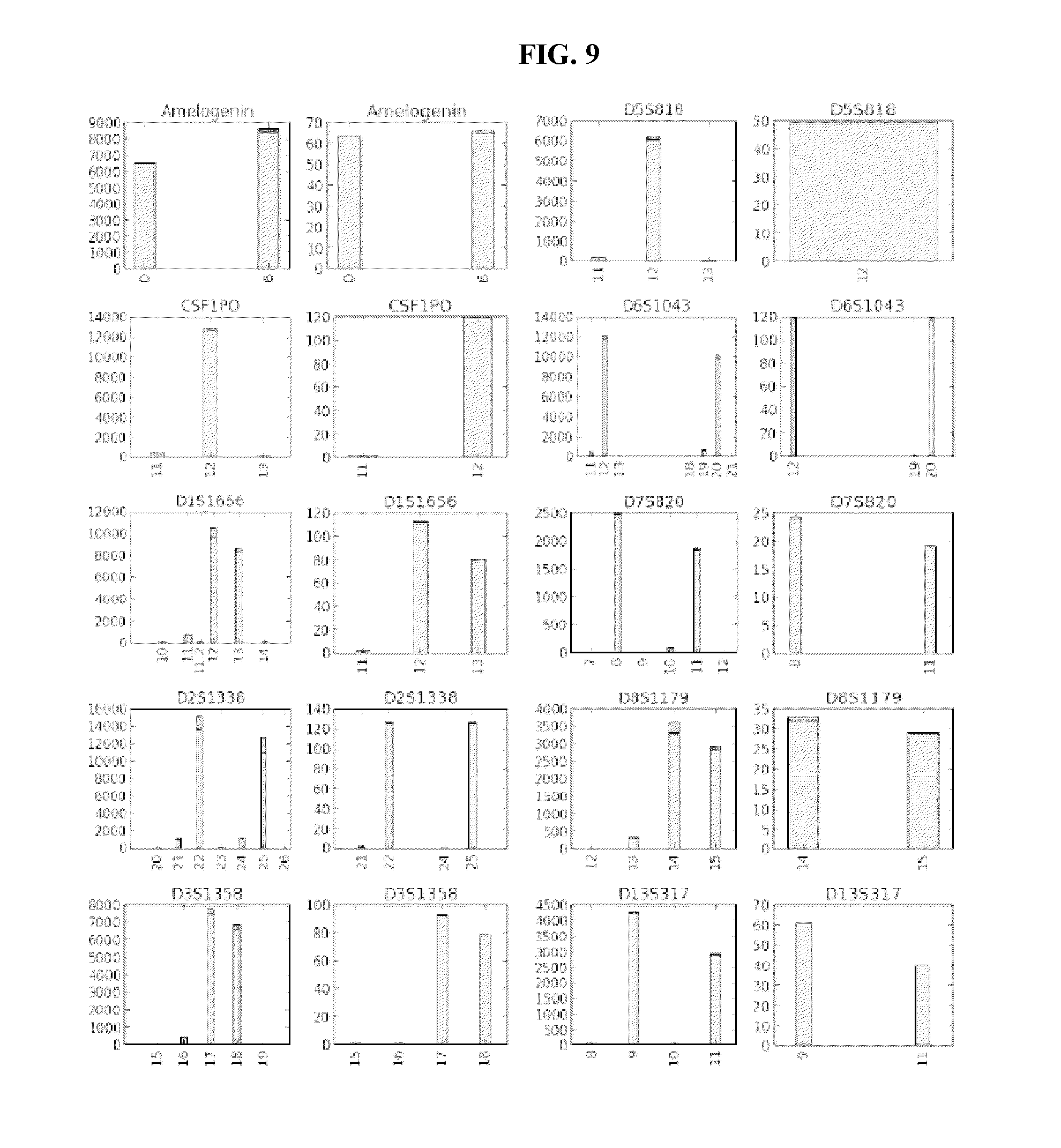
D00016
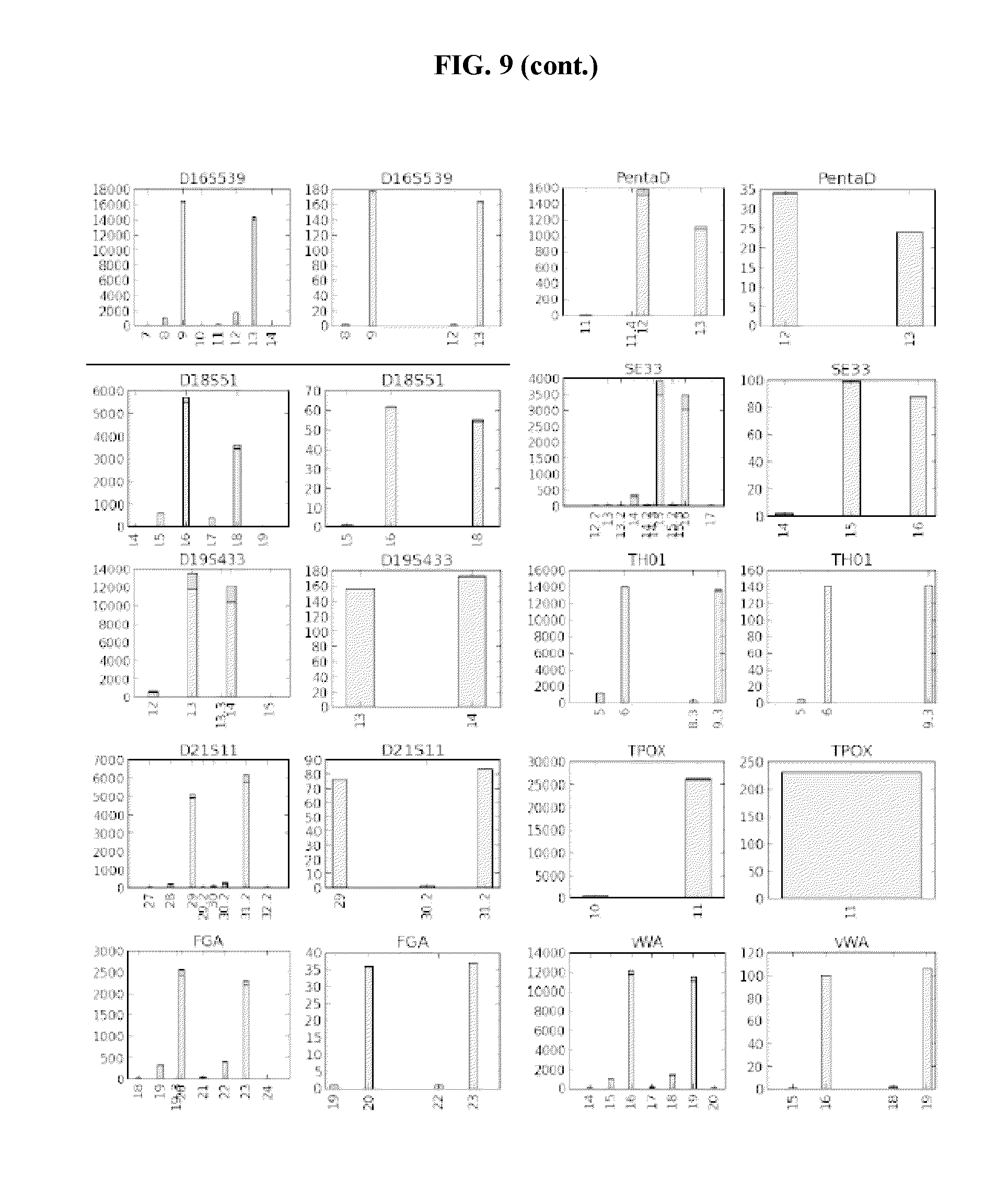
D00017
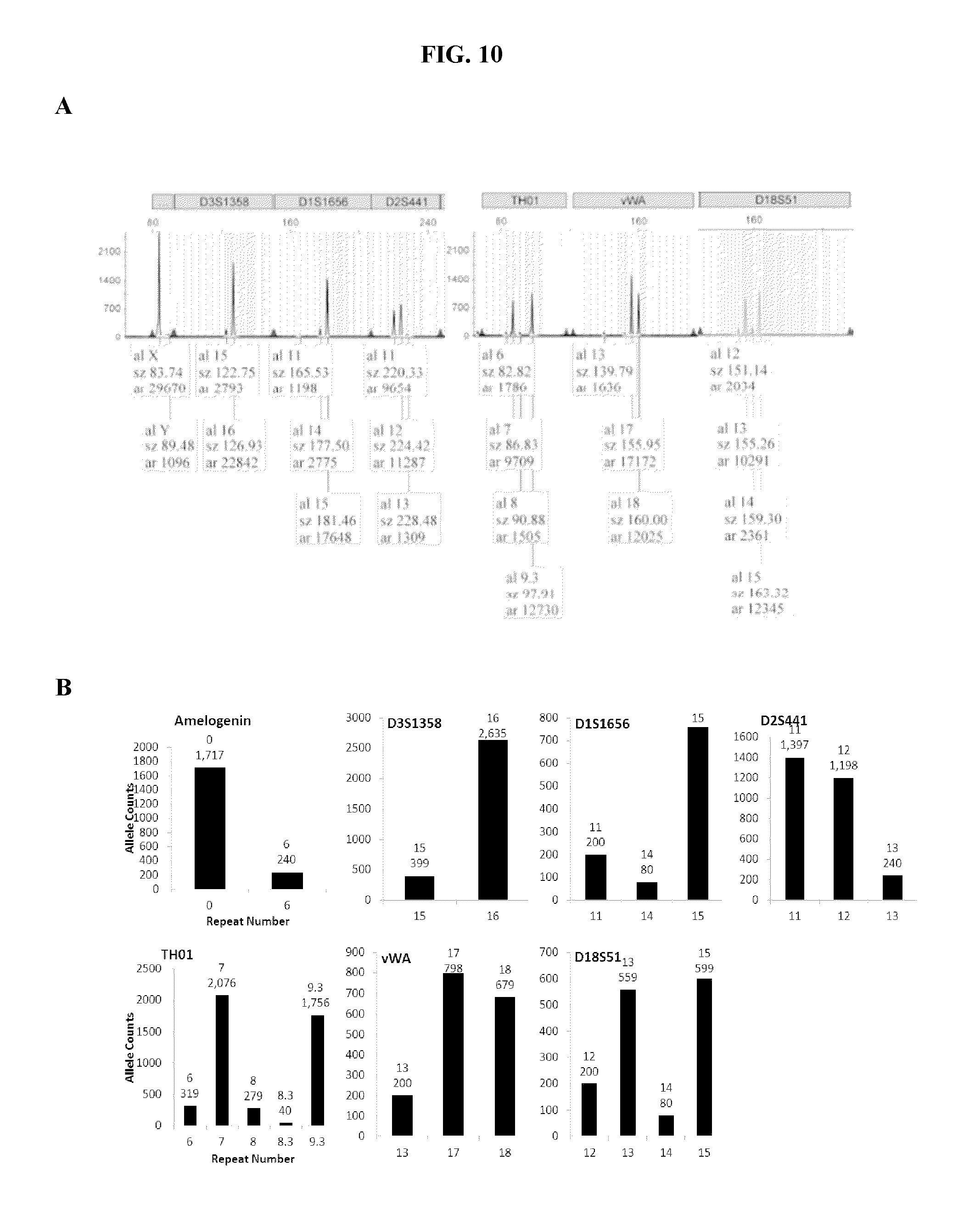
D00018
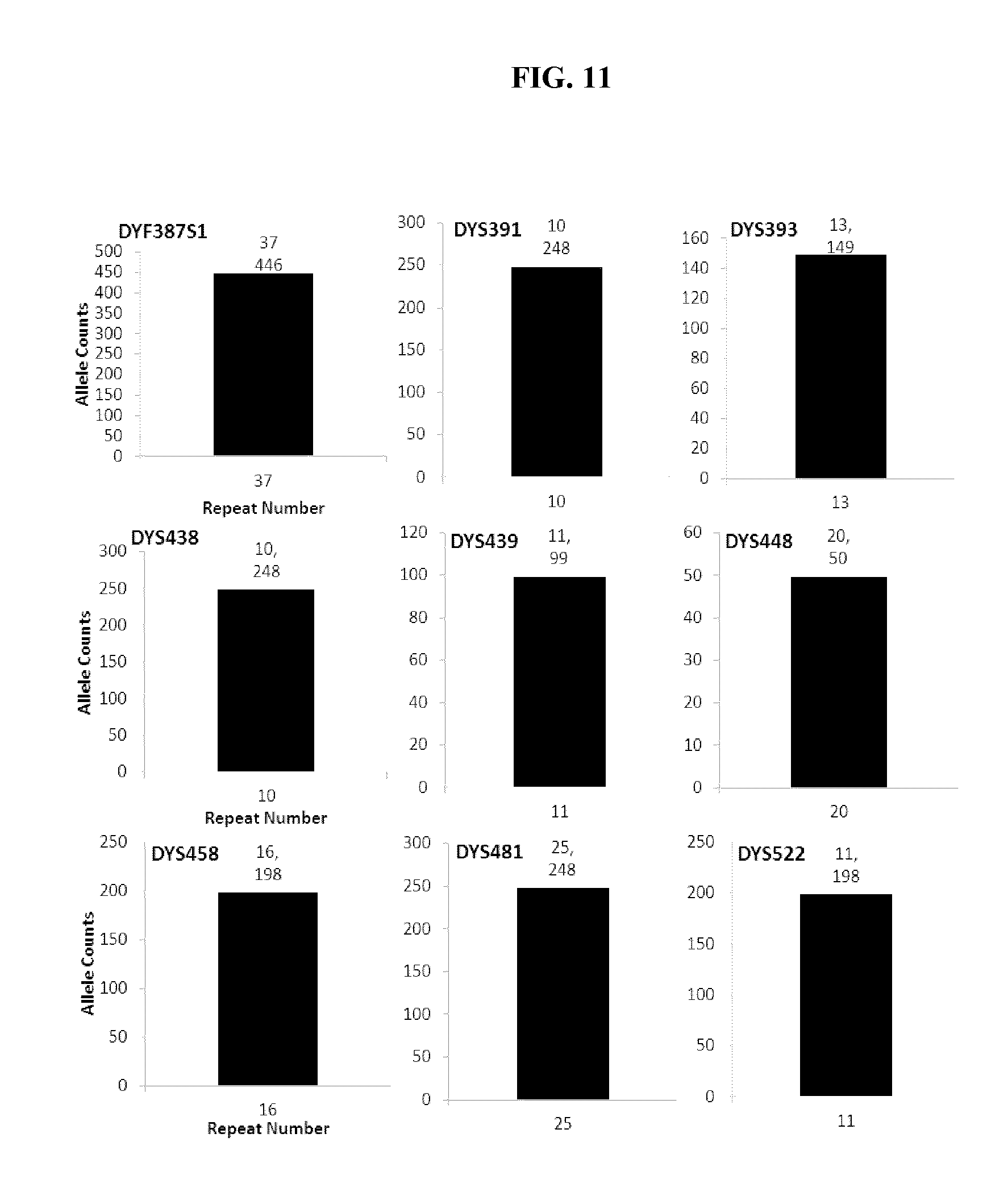
D00019
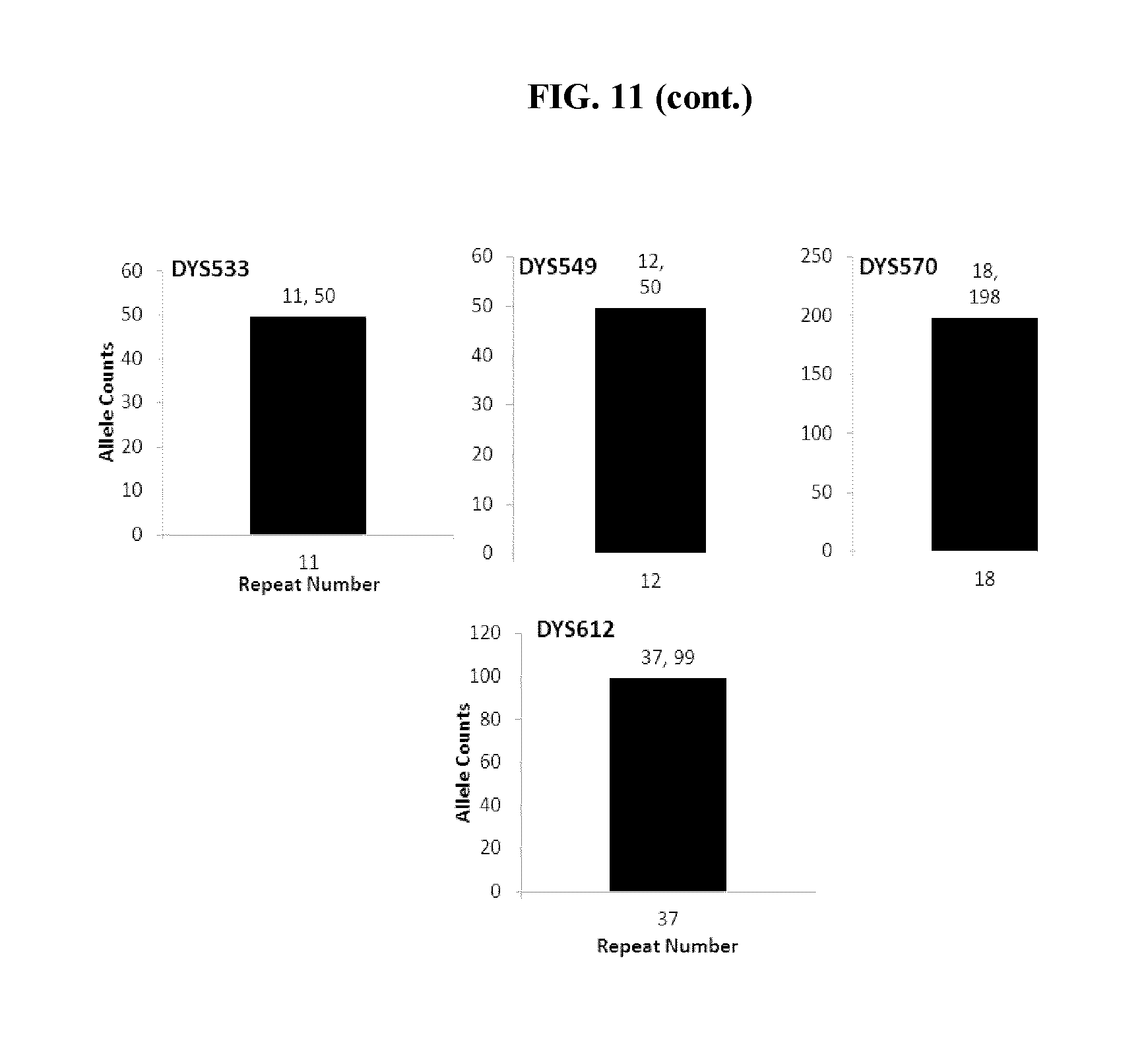
D00020
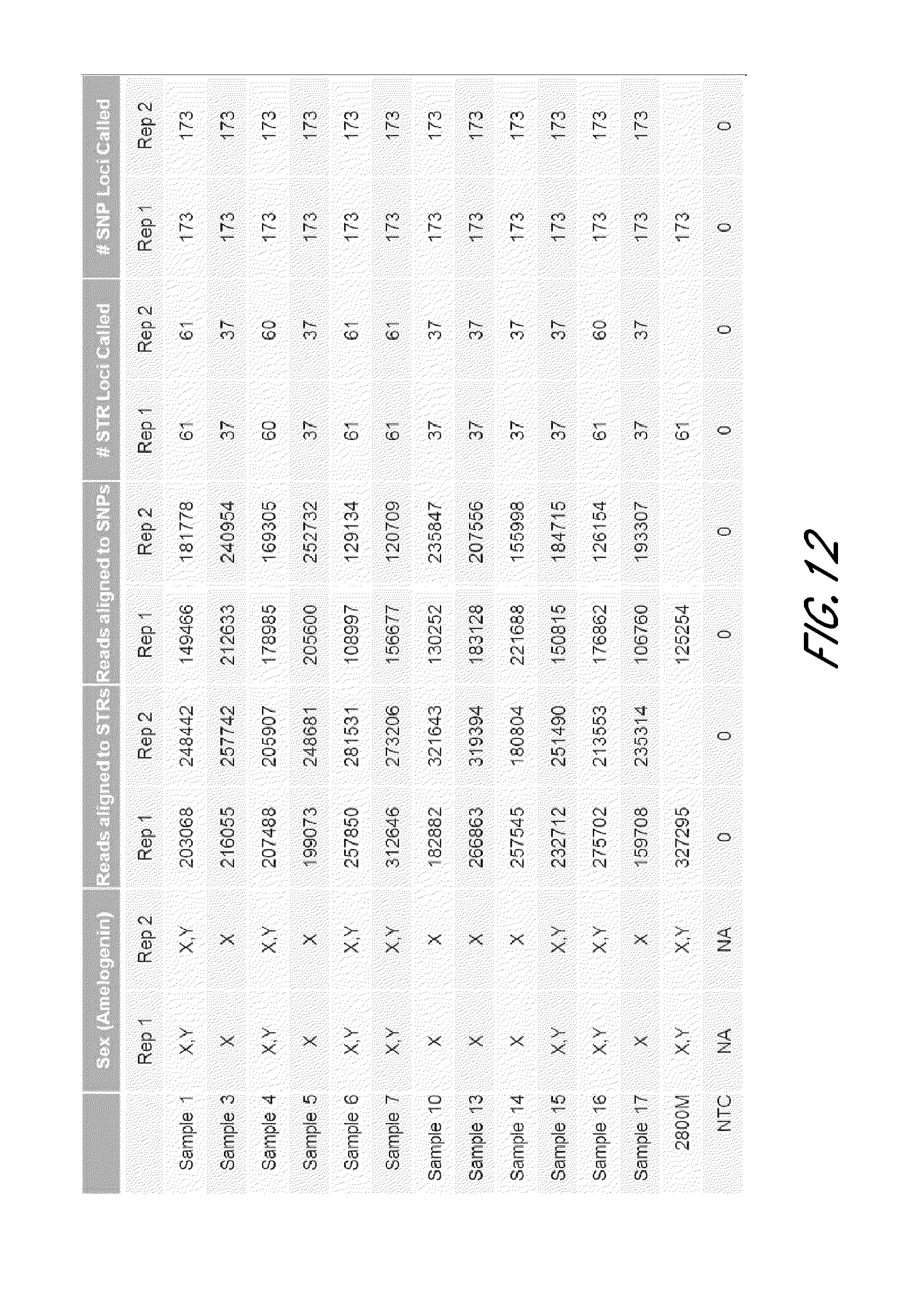
D00021
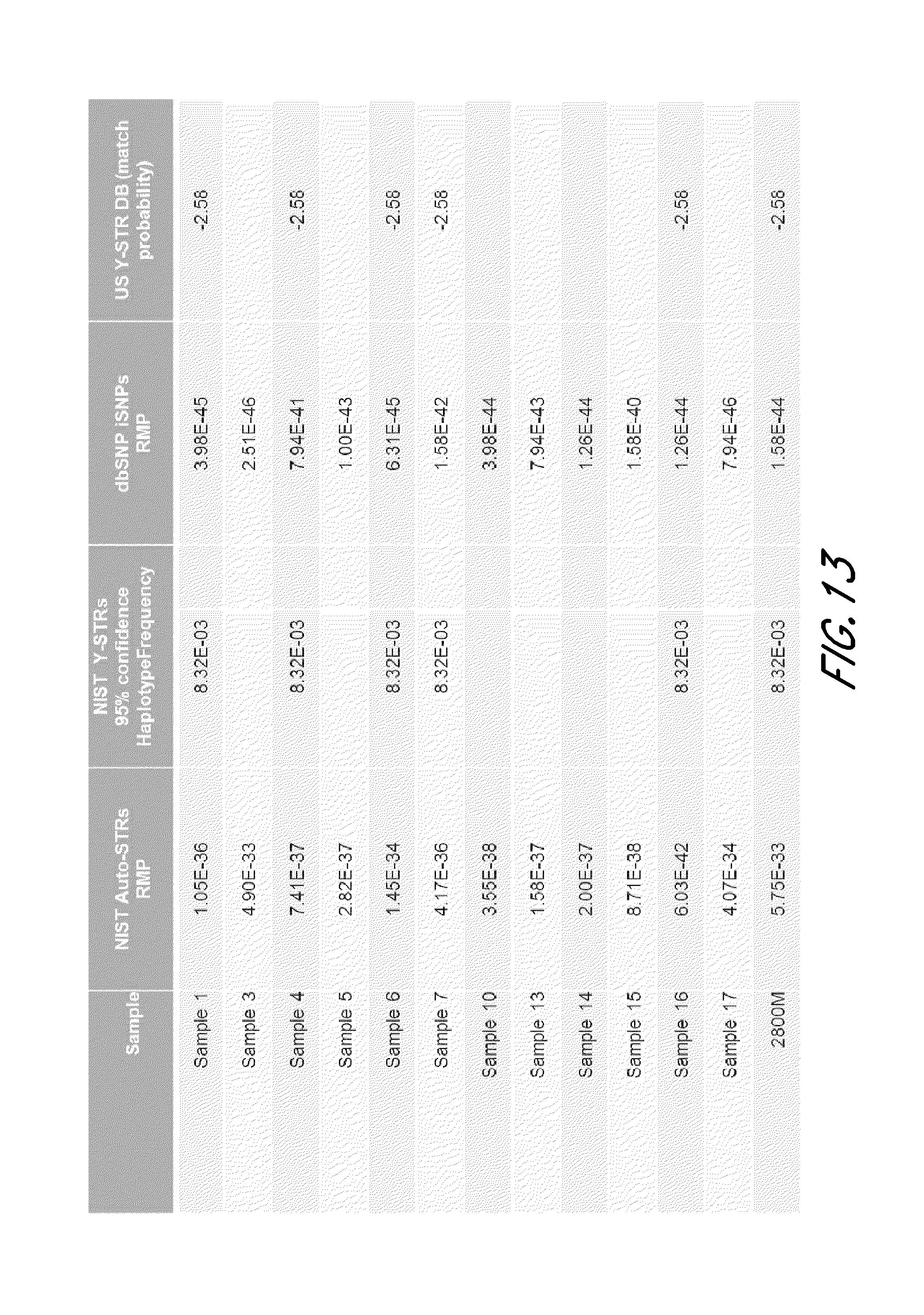
D00022
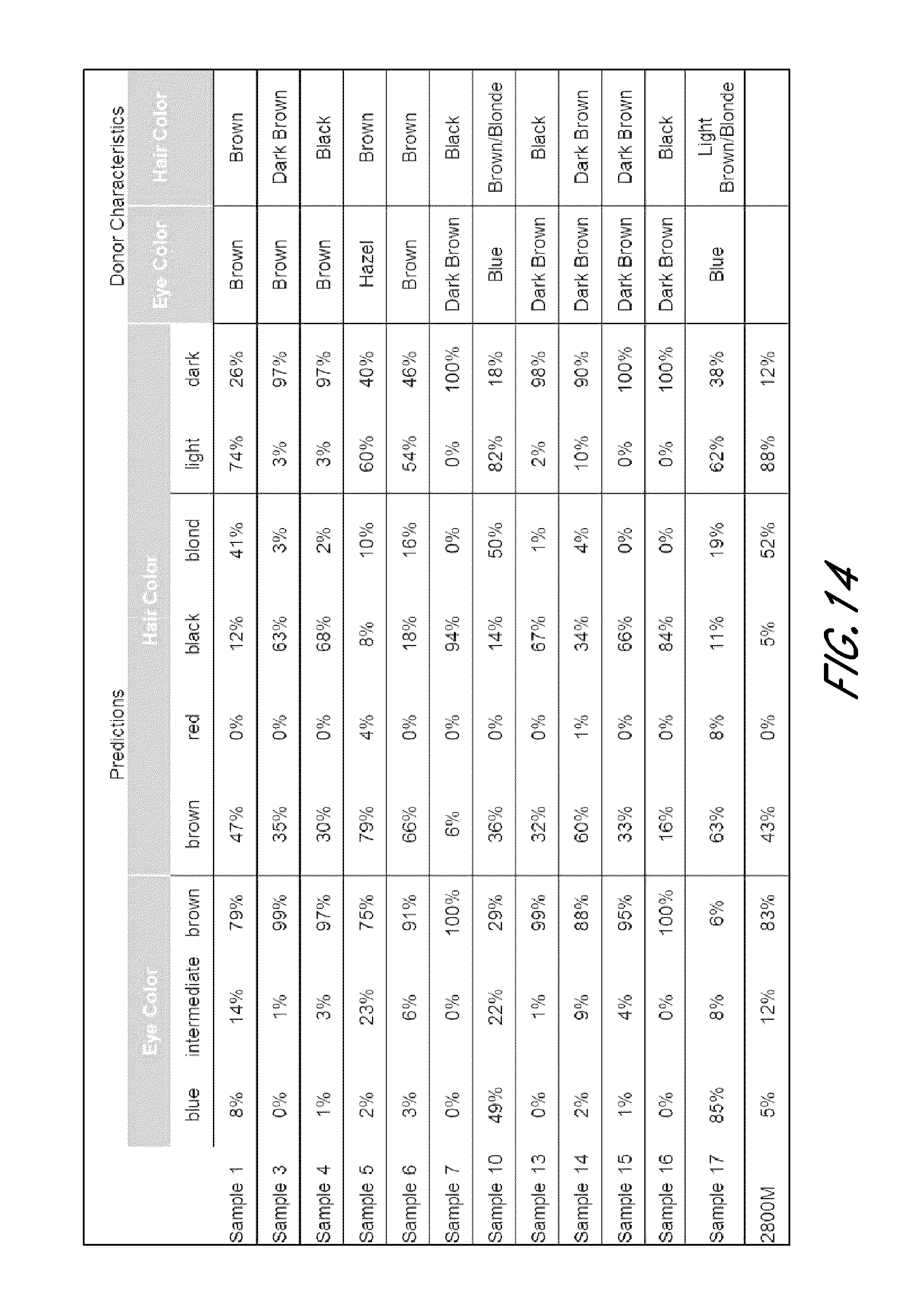
D00023
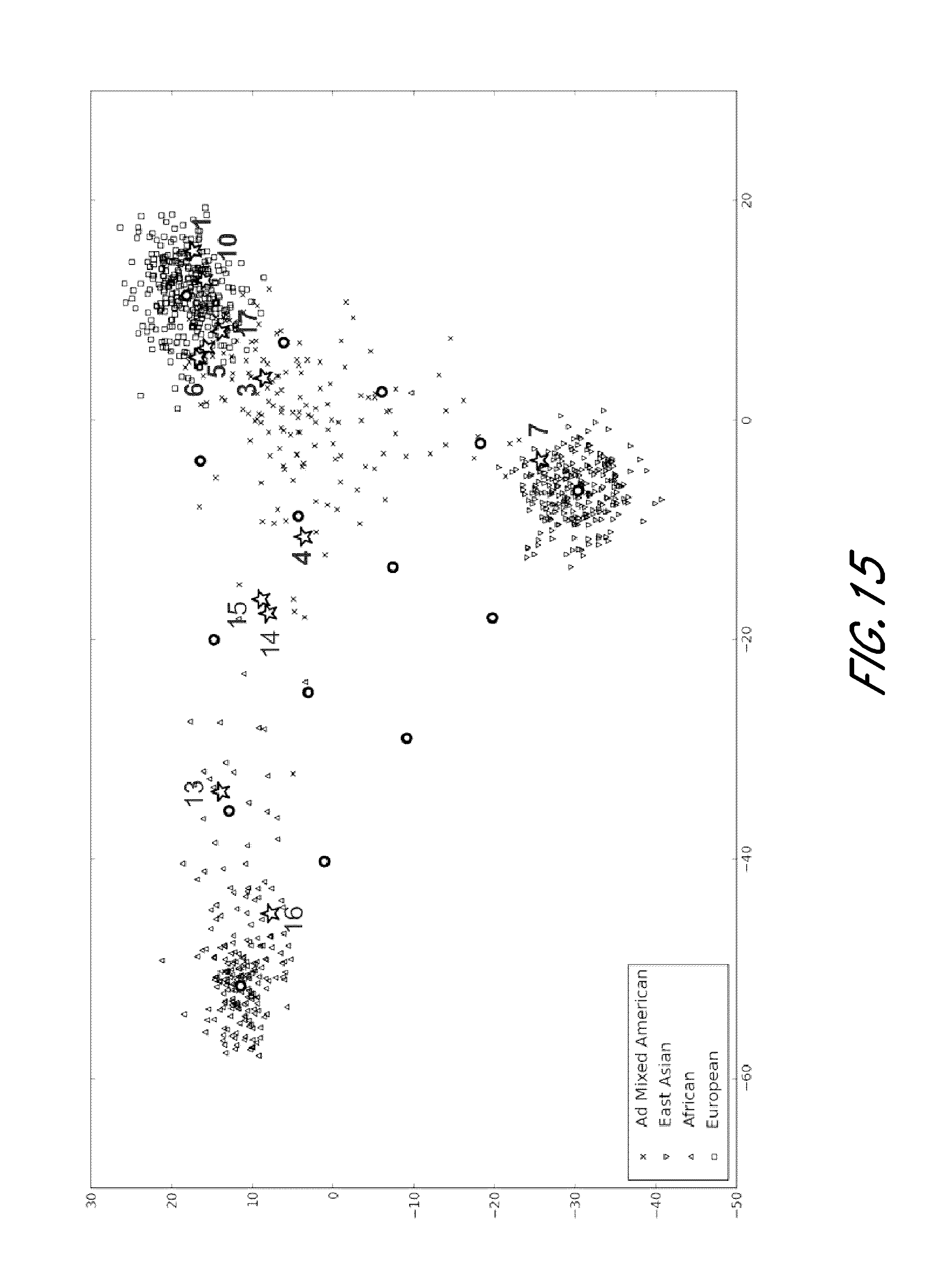
D00024
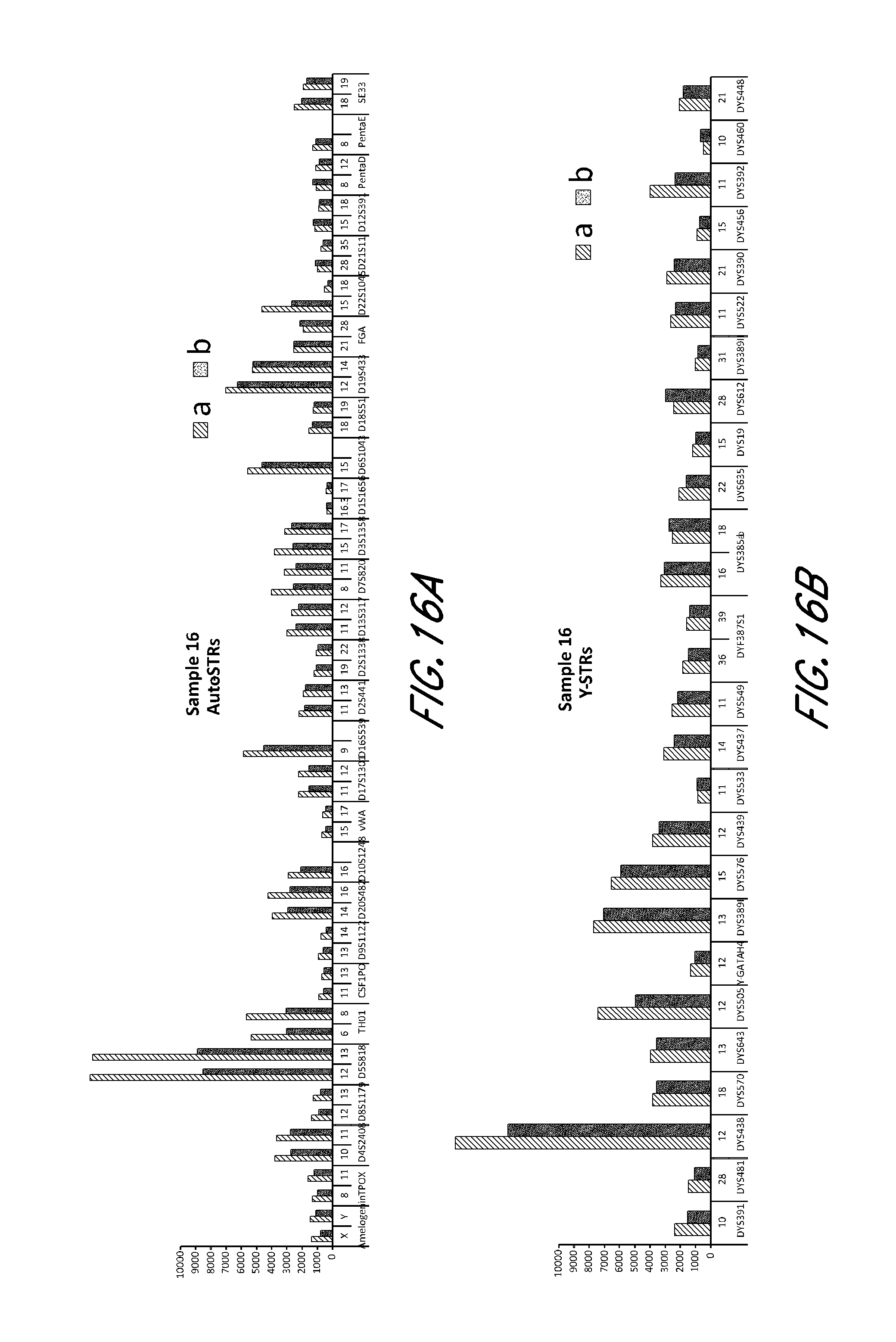
D00025
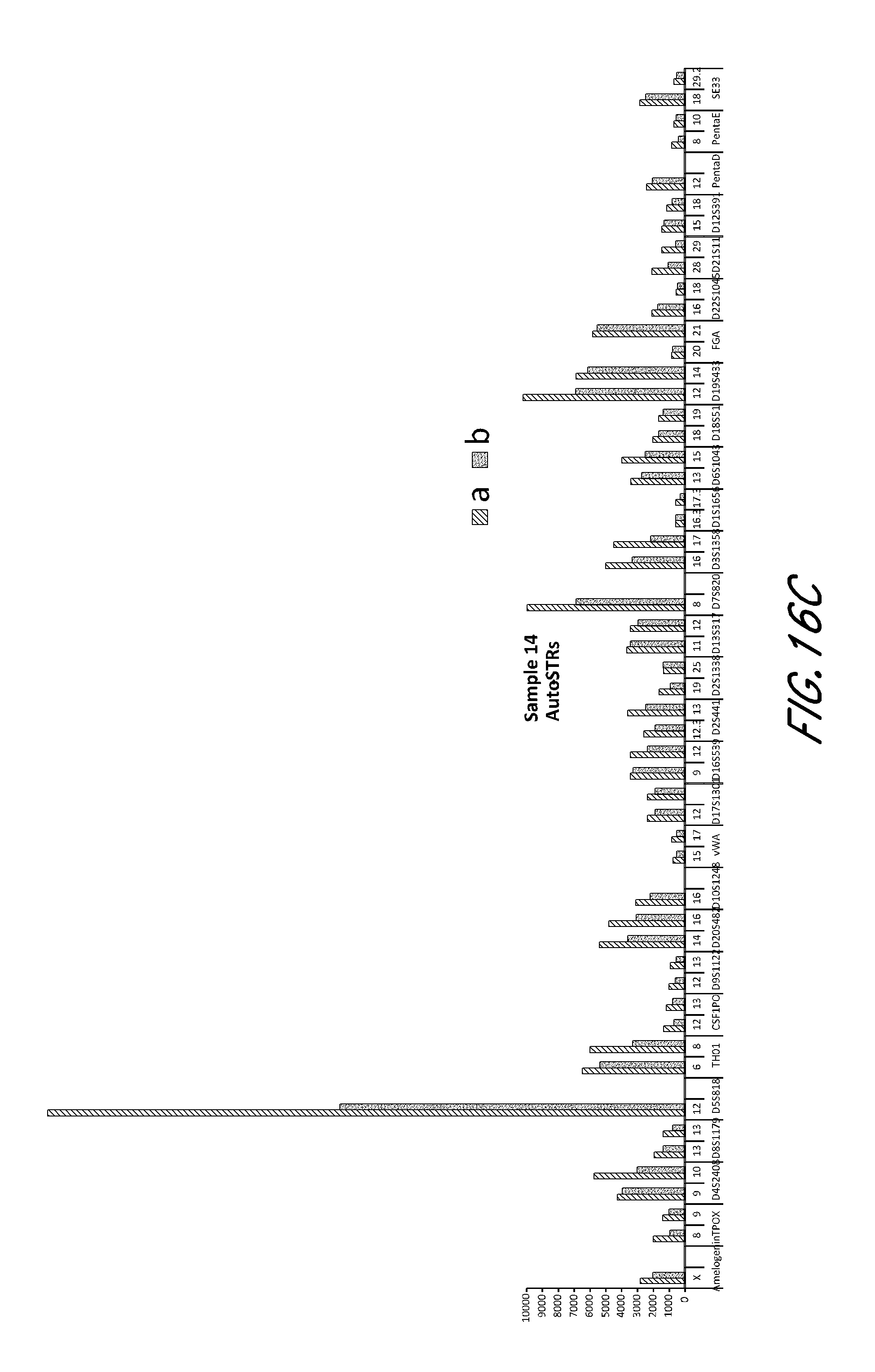
D00026

D00027

D00028
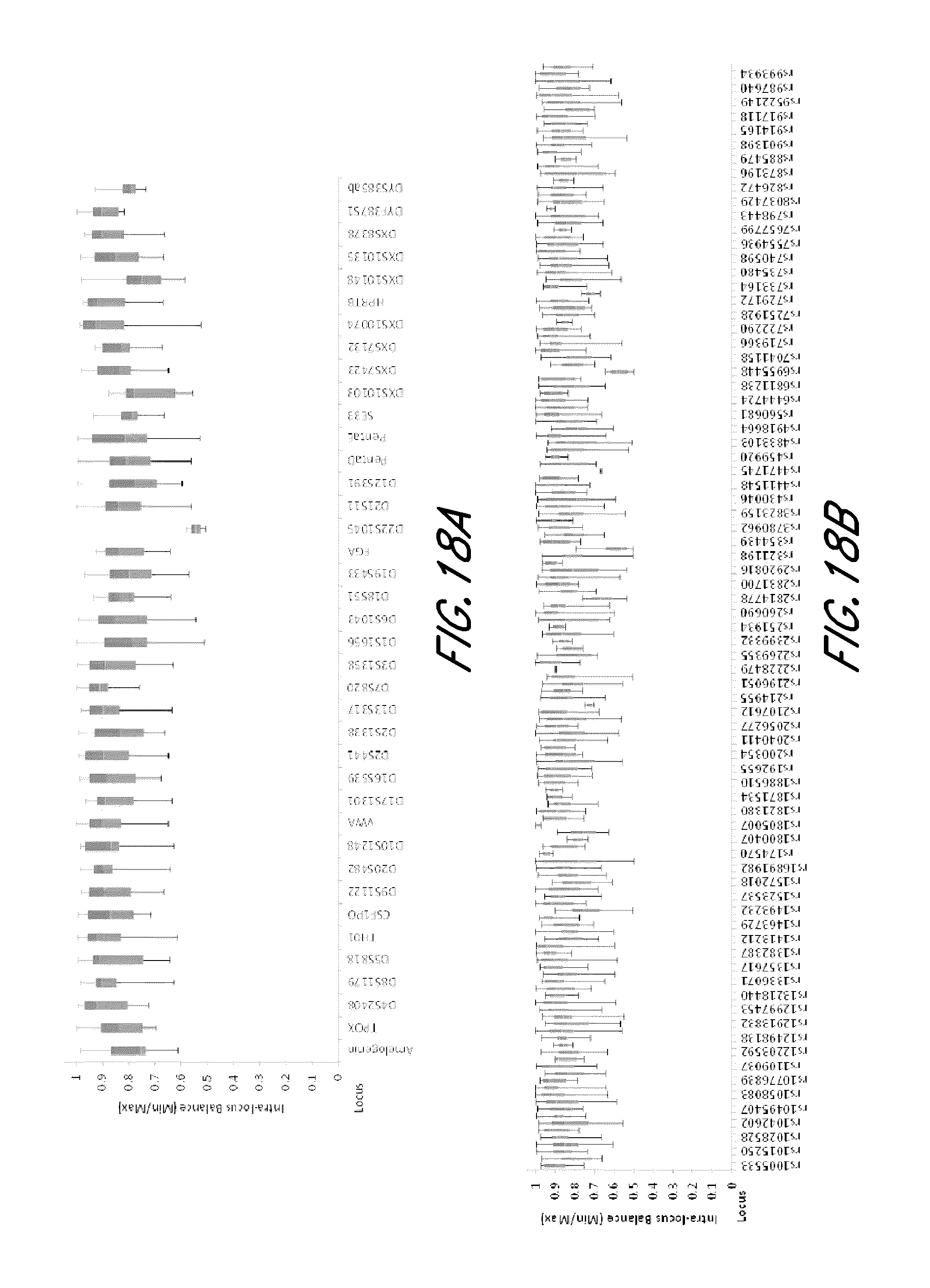
D00029
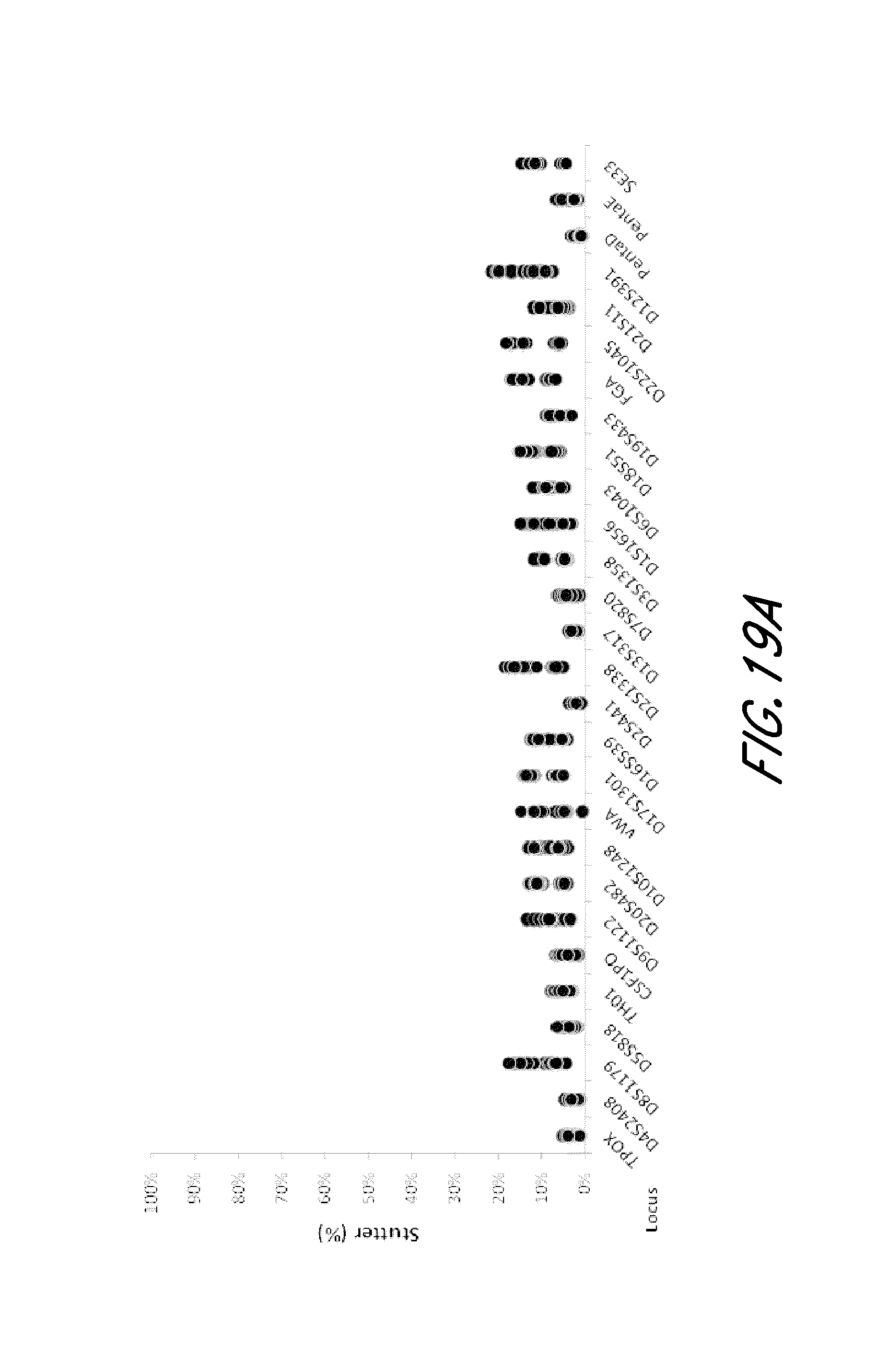
D00030
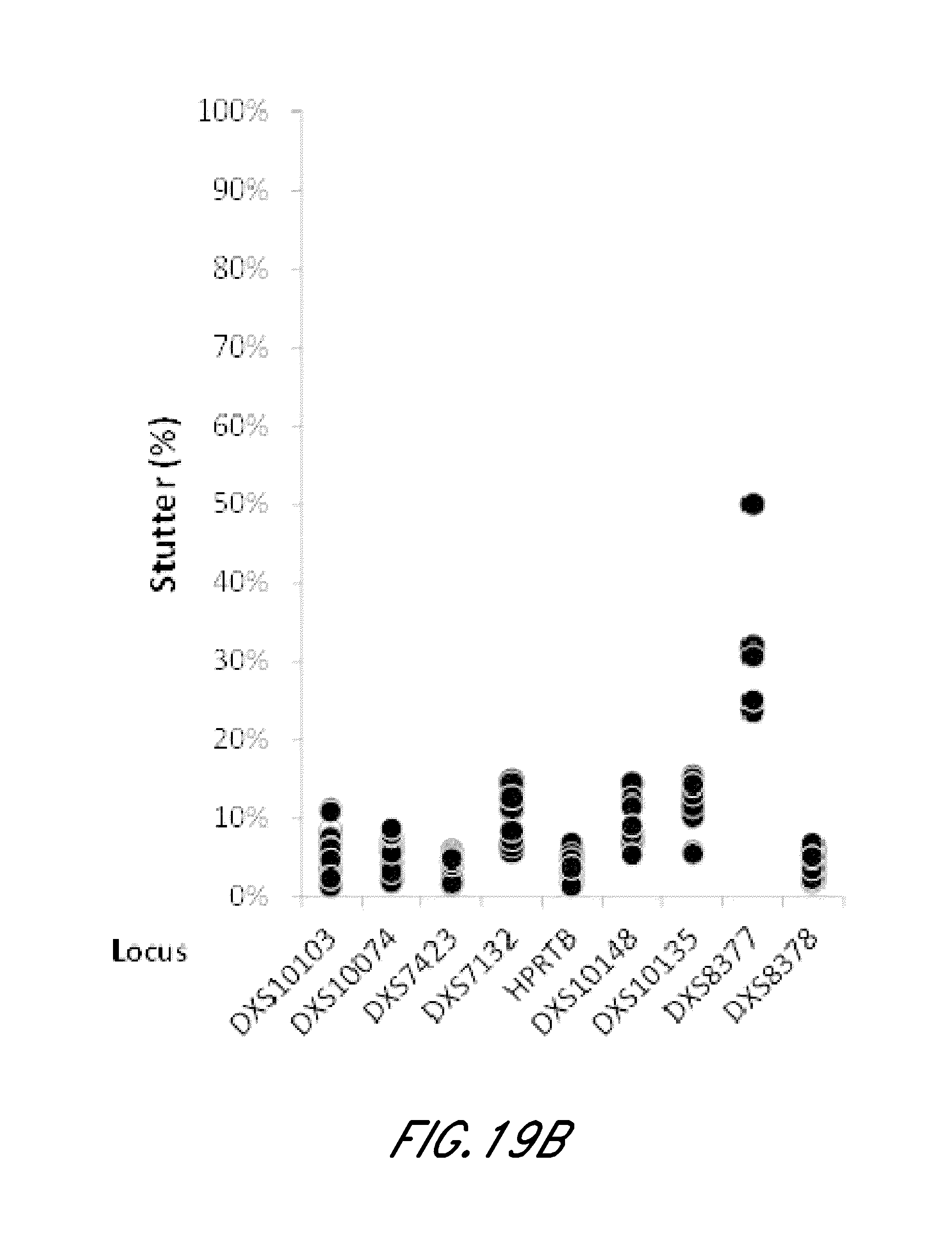
D00031
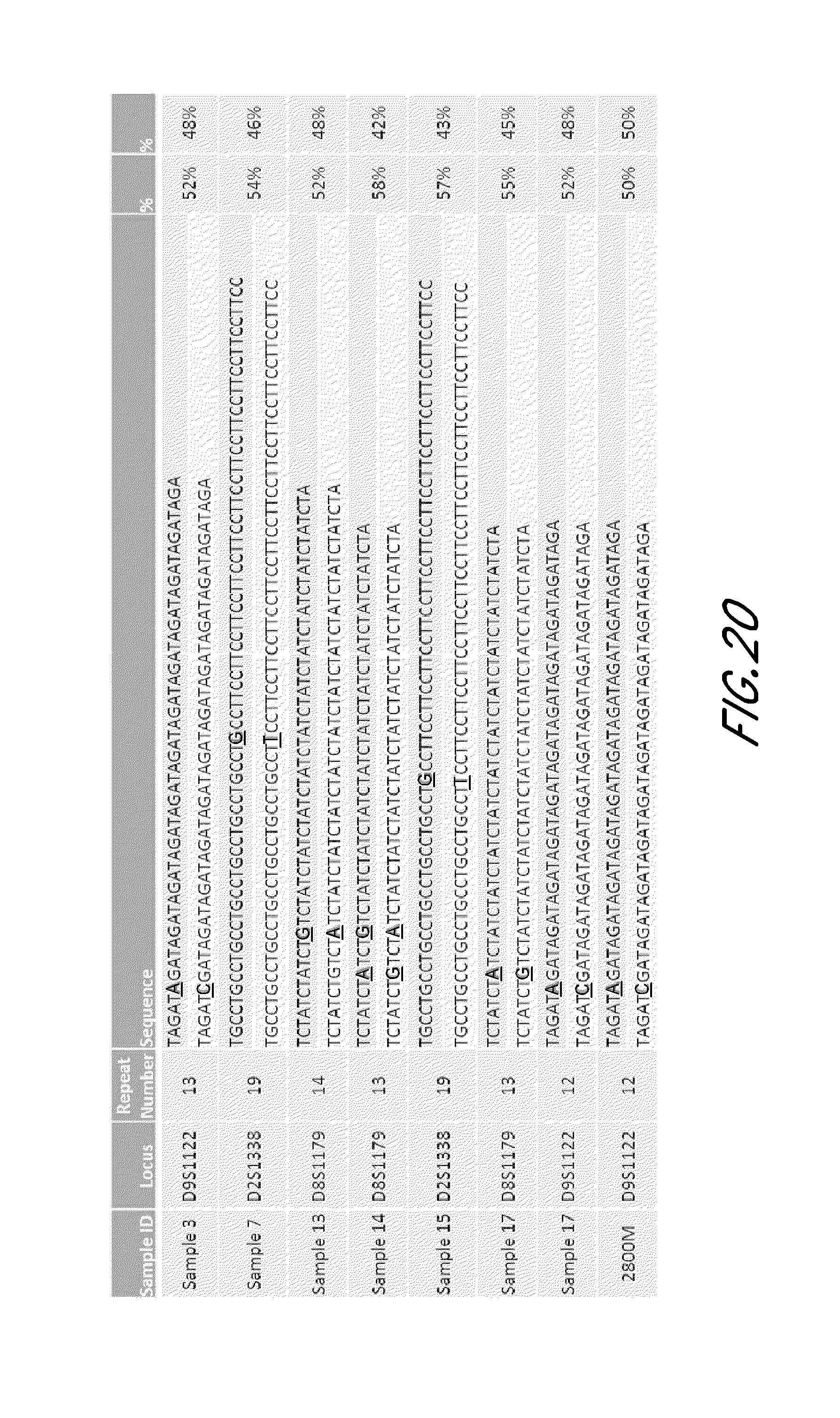
D00032
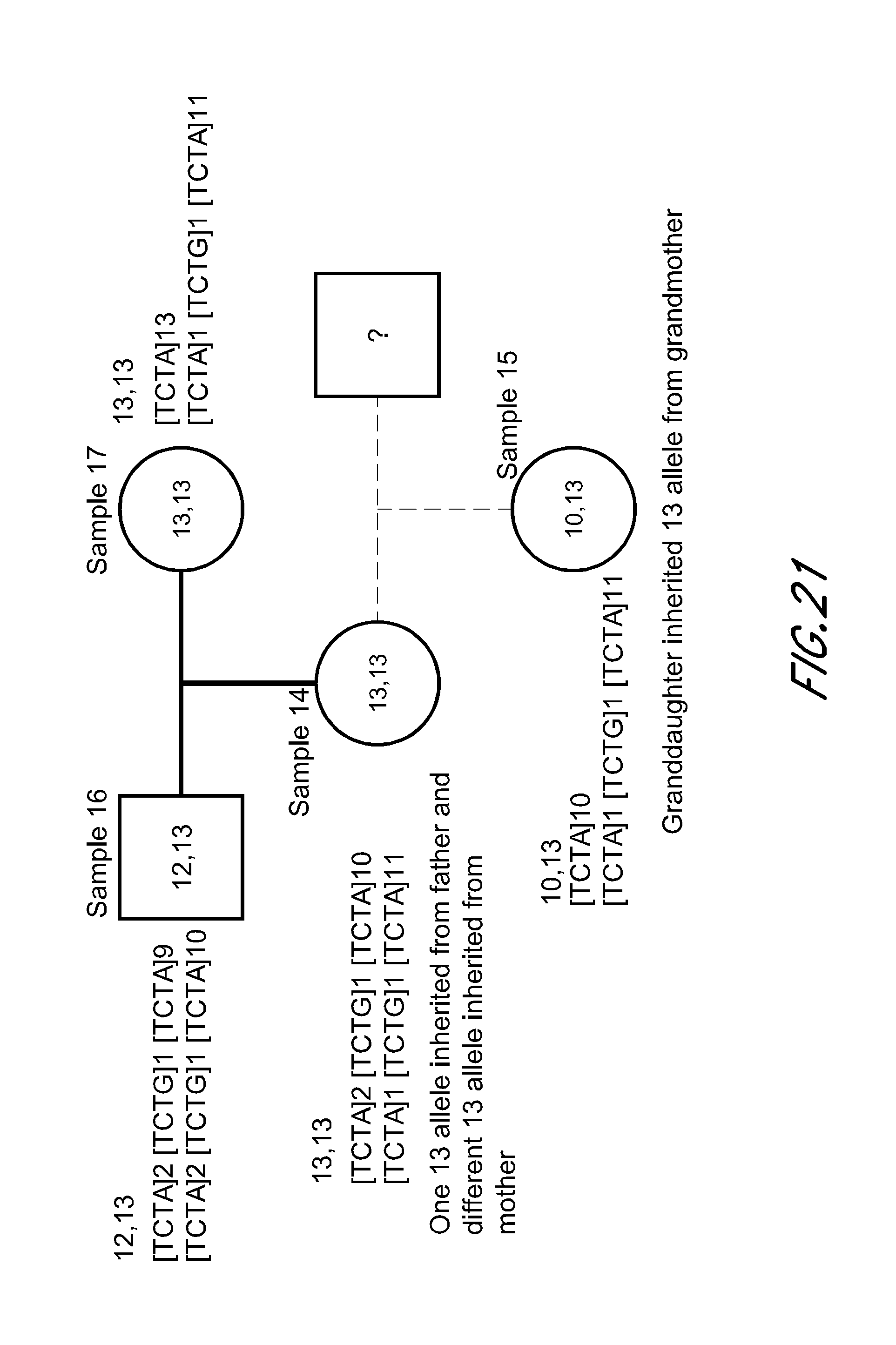
D00033
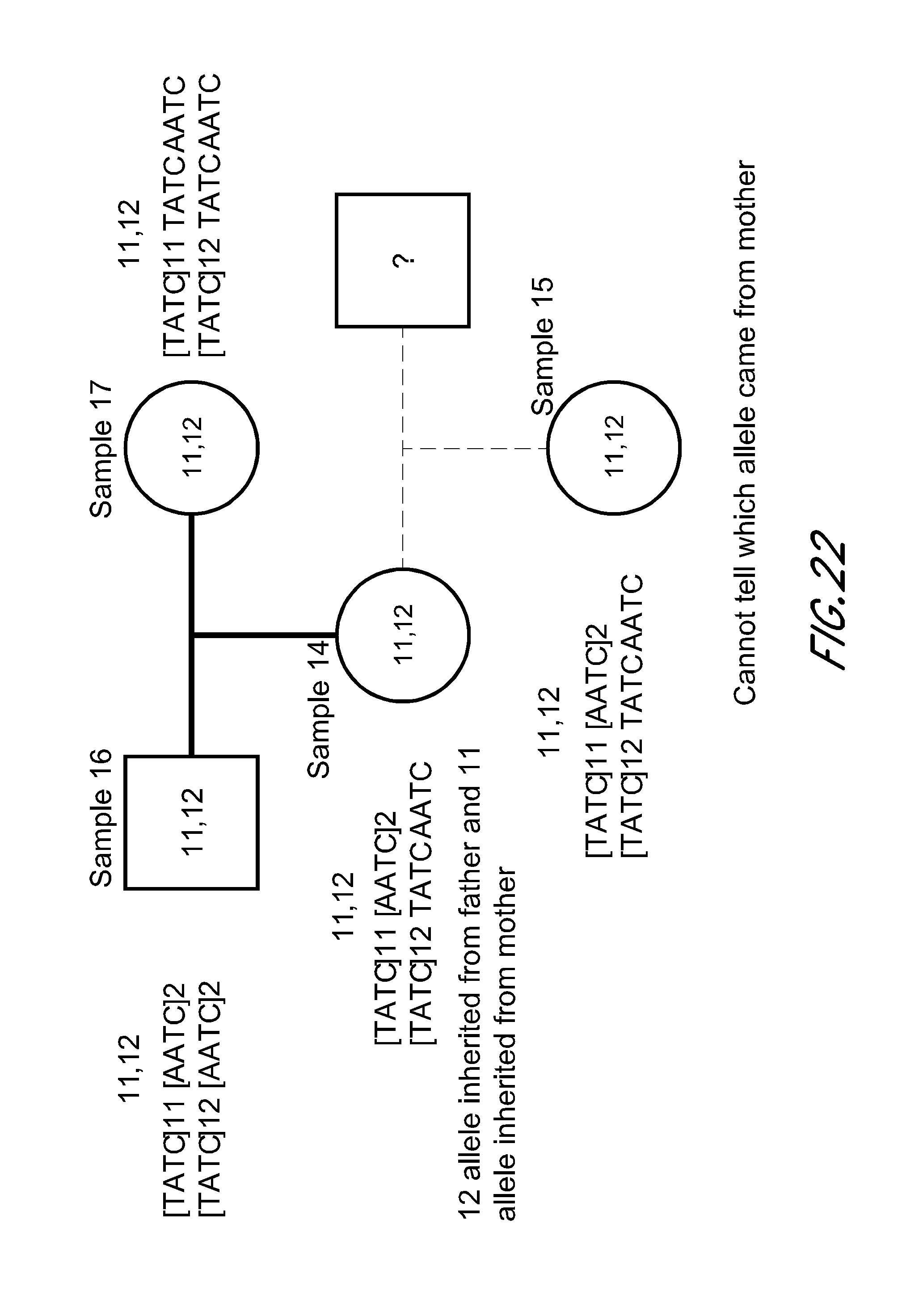
D00034

D00035
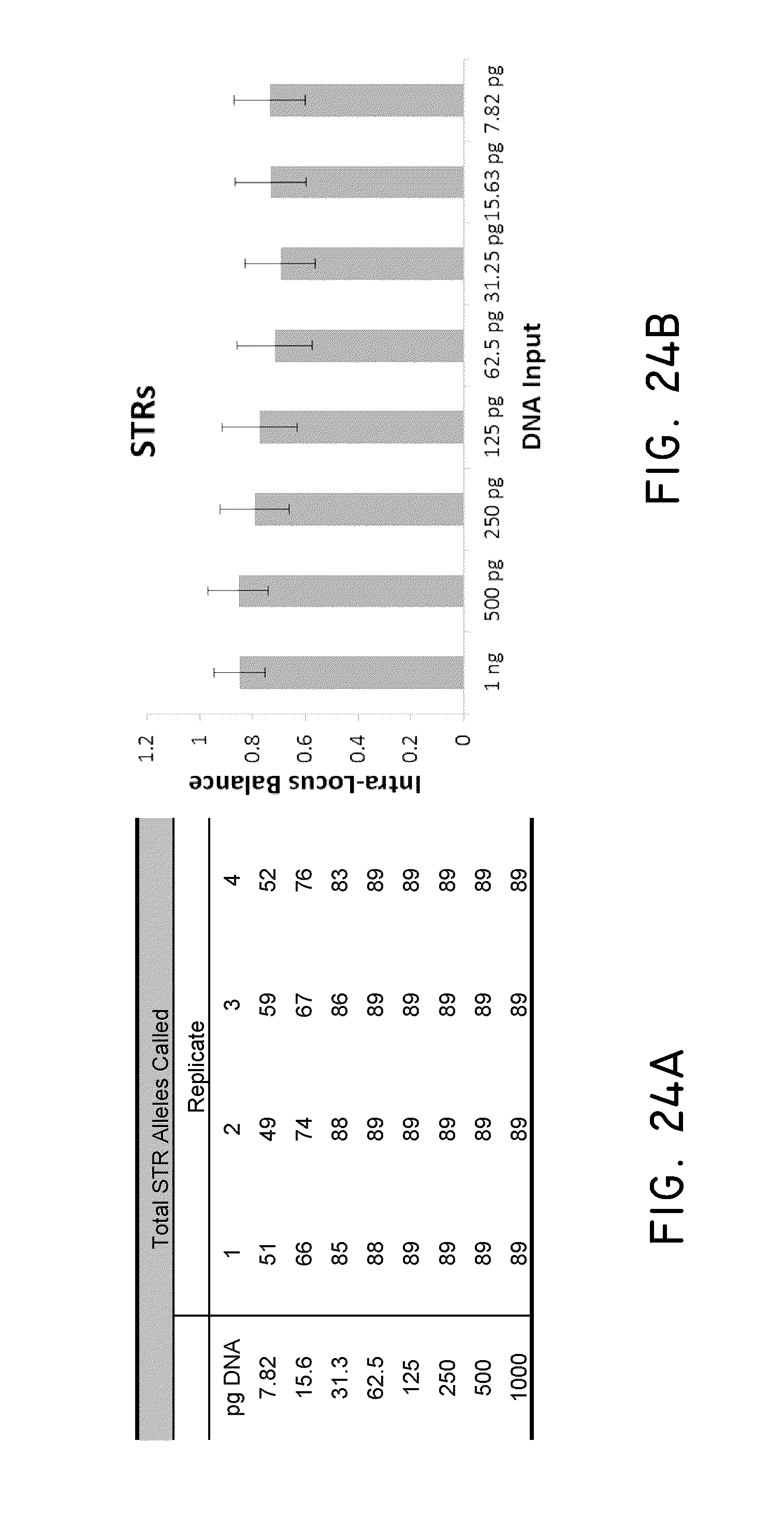
D00036
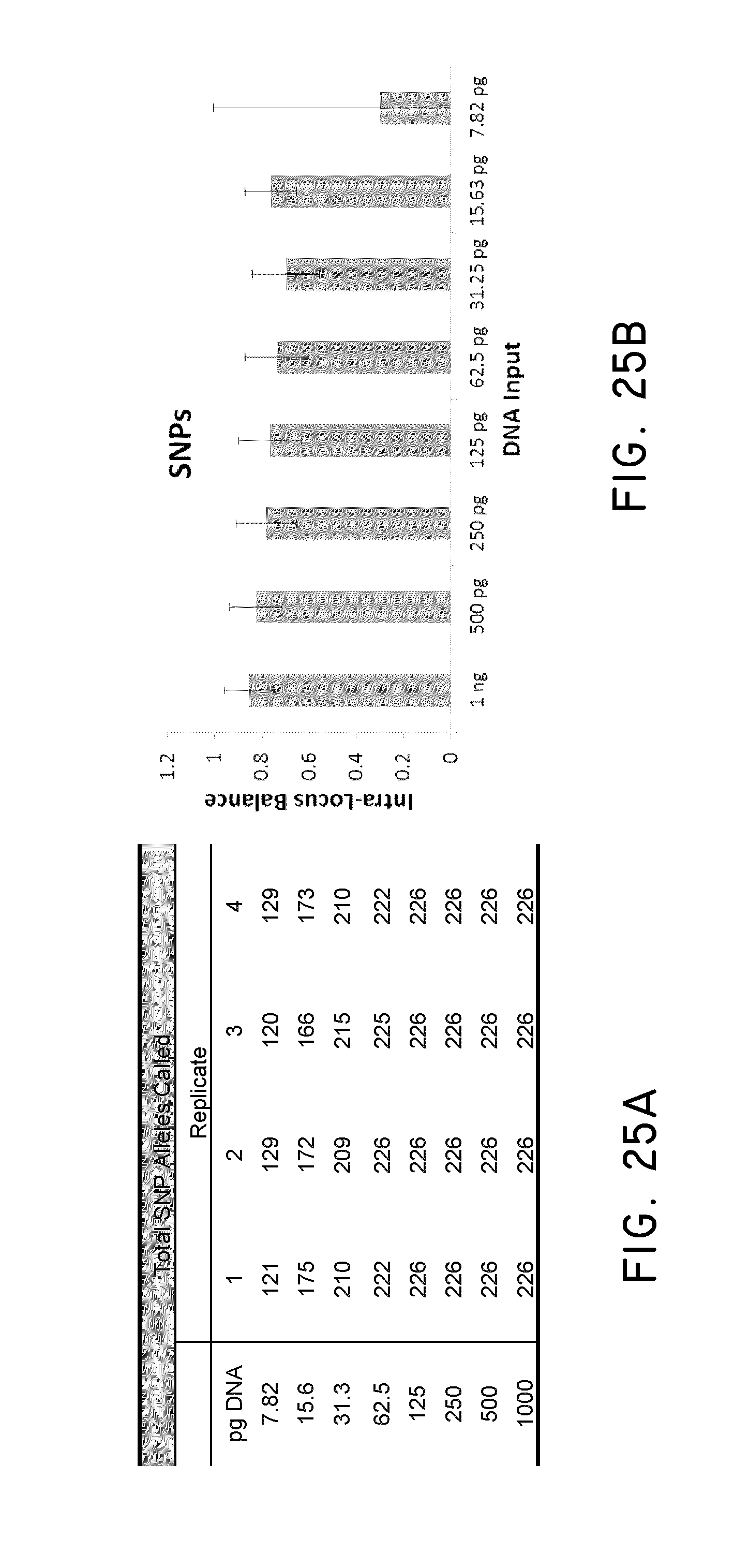
S00001
XML
uspto.report is an independent third-party trademark research tool that is not affiliated, endorsed, or sponsored by the United States Patent and Trademark Office (USPTO) or any other governmental organization. The information provided by uspto.report is based on publicly available data at the time of writing and is intended for informational purposes only.
While we strive to provide accurate and up-to-date information, we do not guarantee the accuracy, completeness, reliability, or suitability of the information displayed on this site. The use of this site is at your own risk. Any reliance you place on such information is therefore strictly at your own risk.
All official trademark data, including owner information, should be verified by visiting the official USPTO website at www.uspto.gov. This site is not intended to replace professional legal advice and should not be used as a substitute for consulting with a legal professional who is knowledgeable about trademark law.